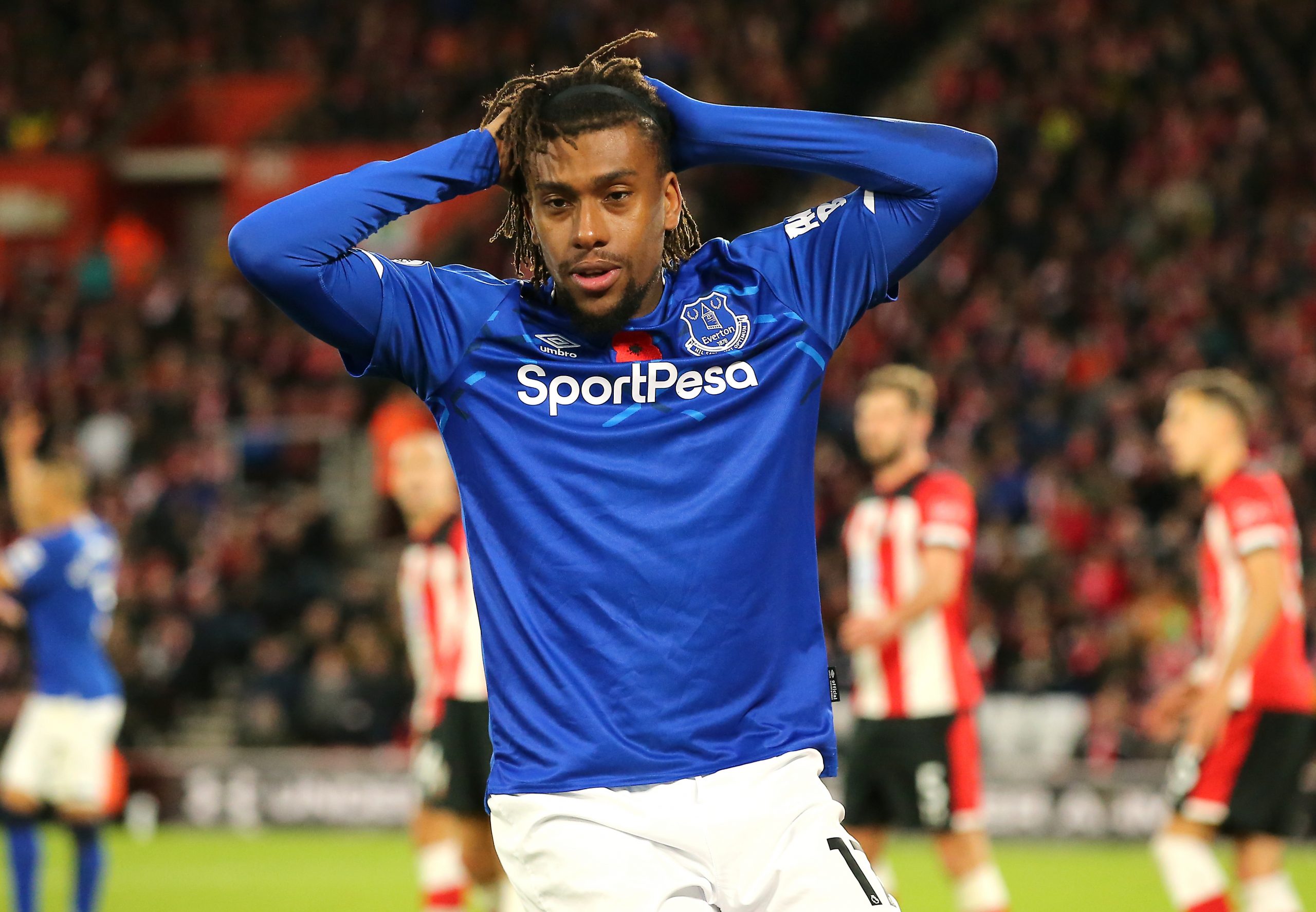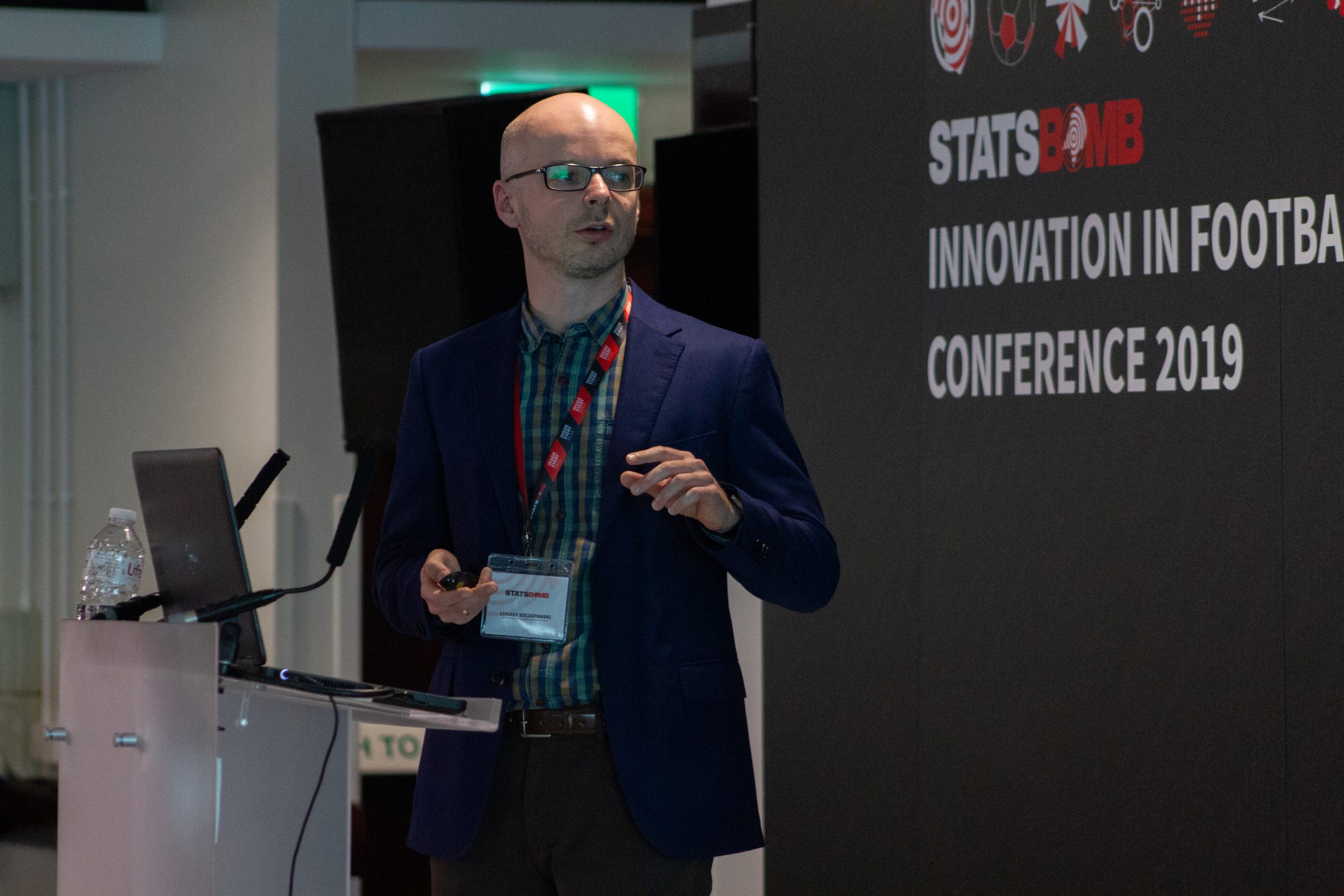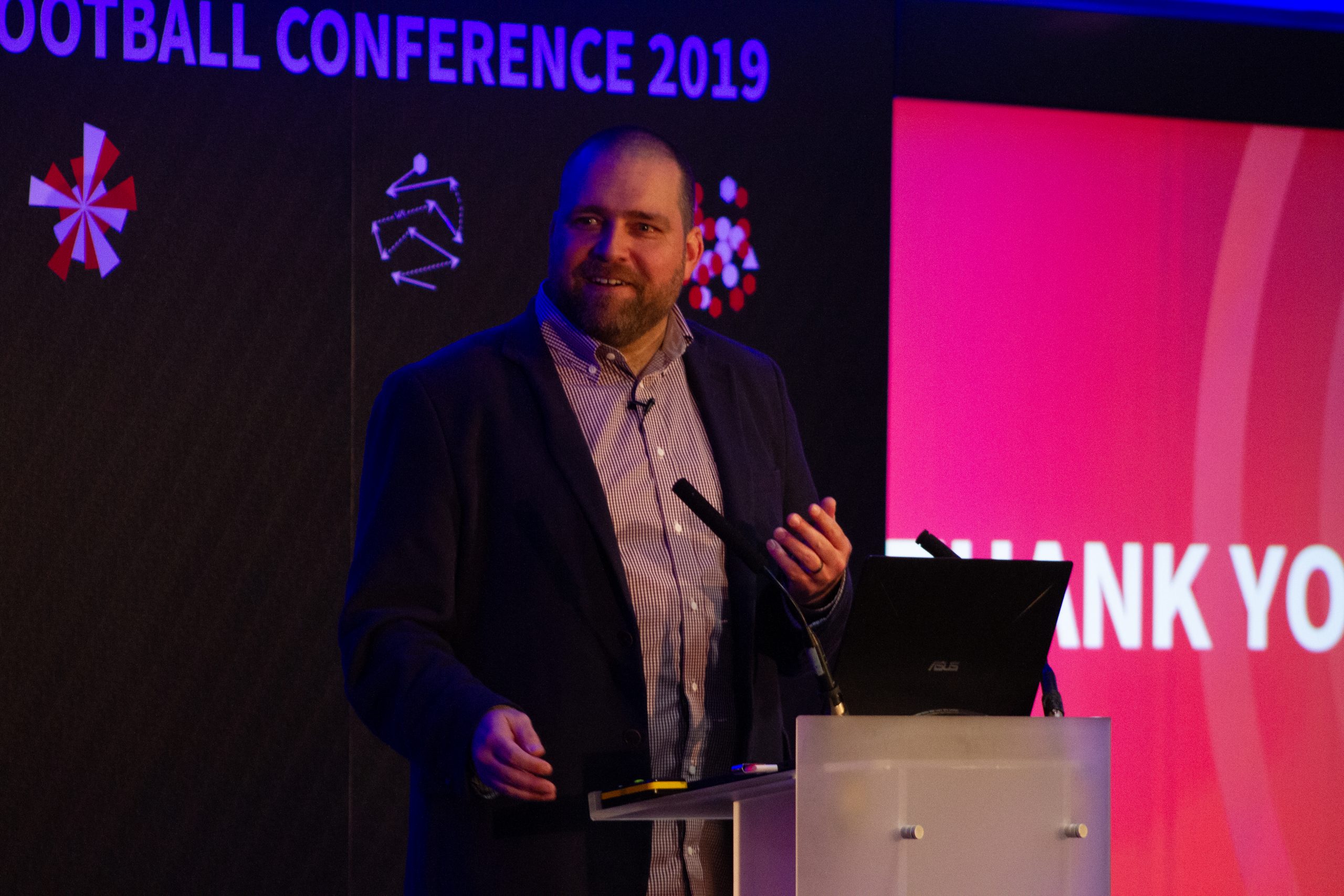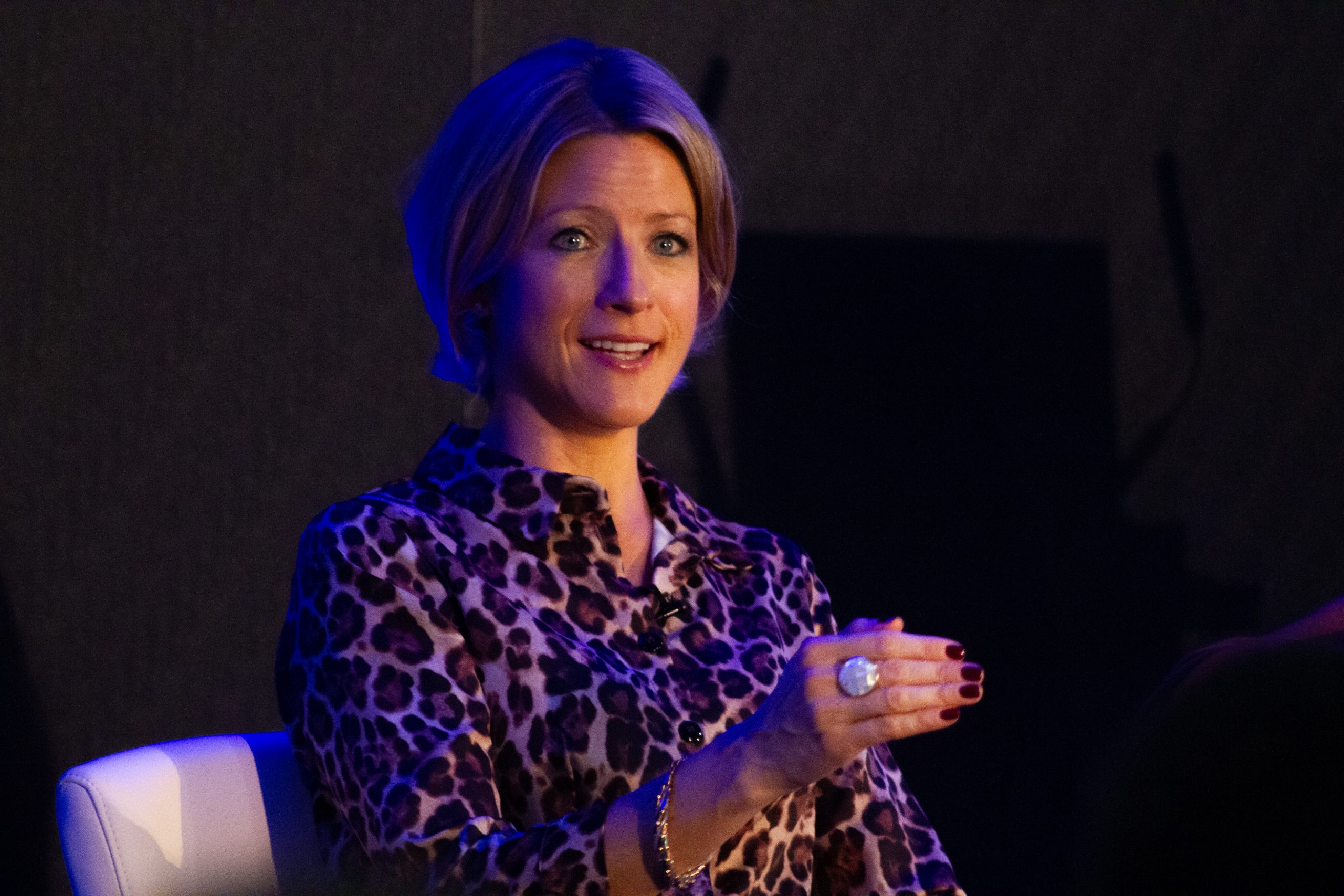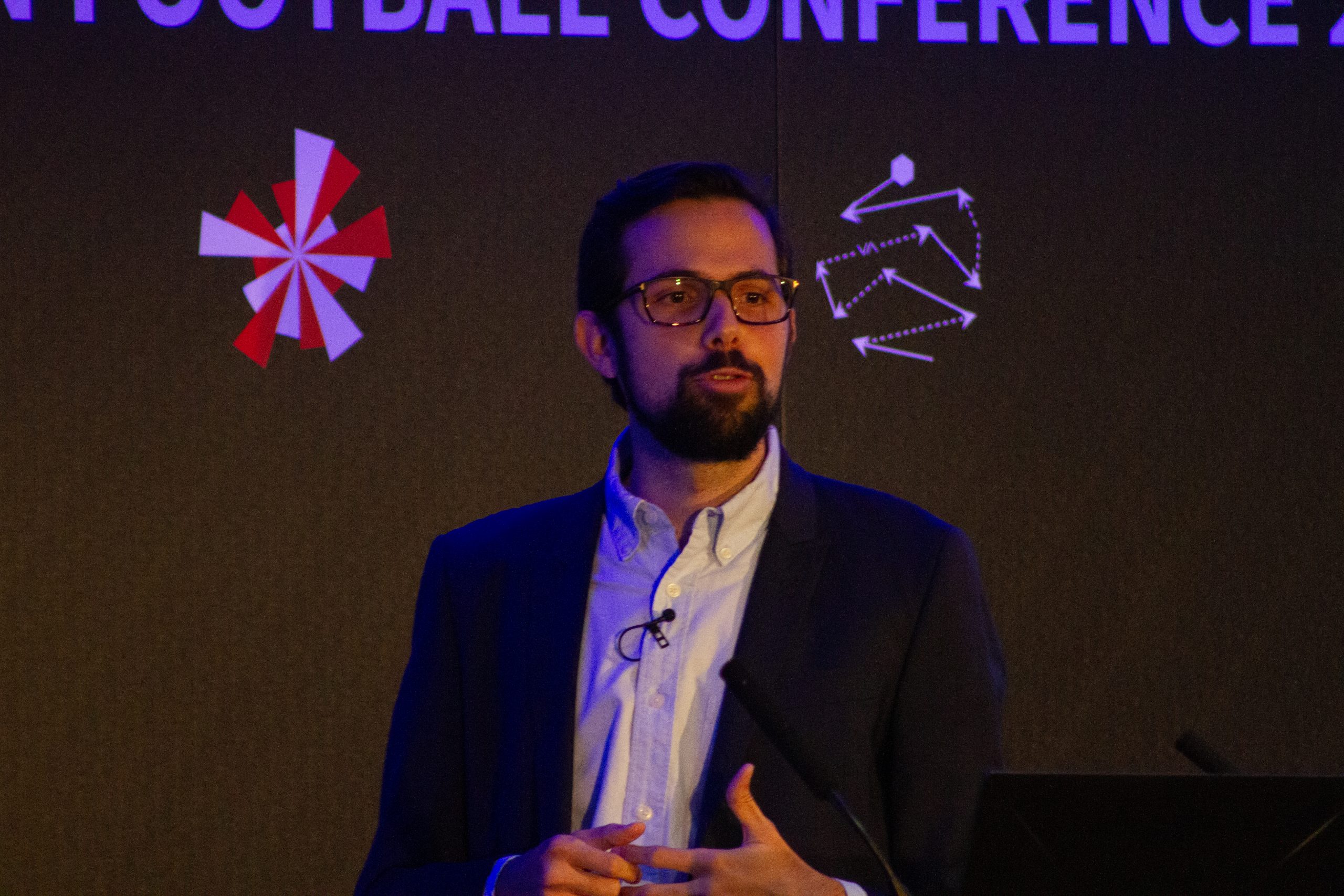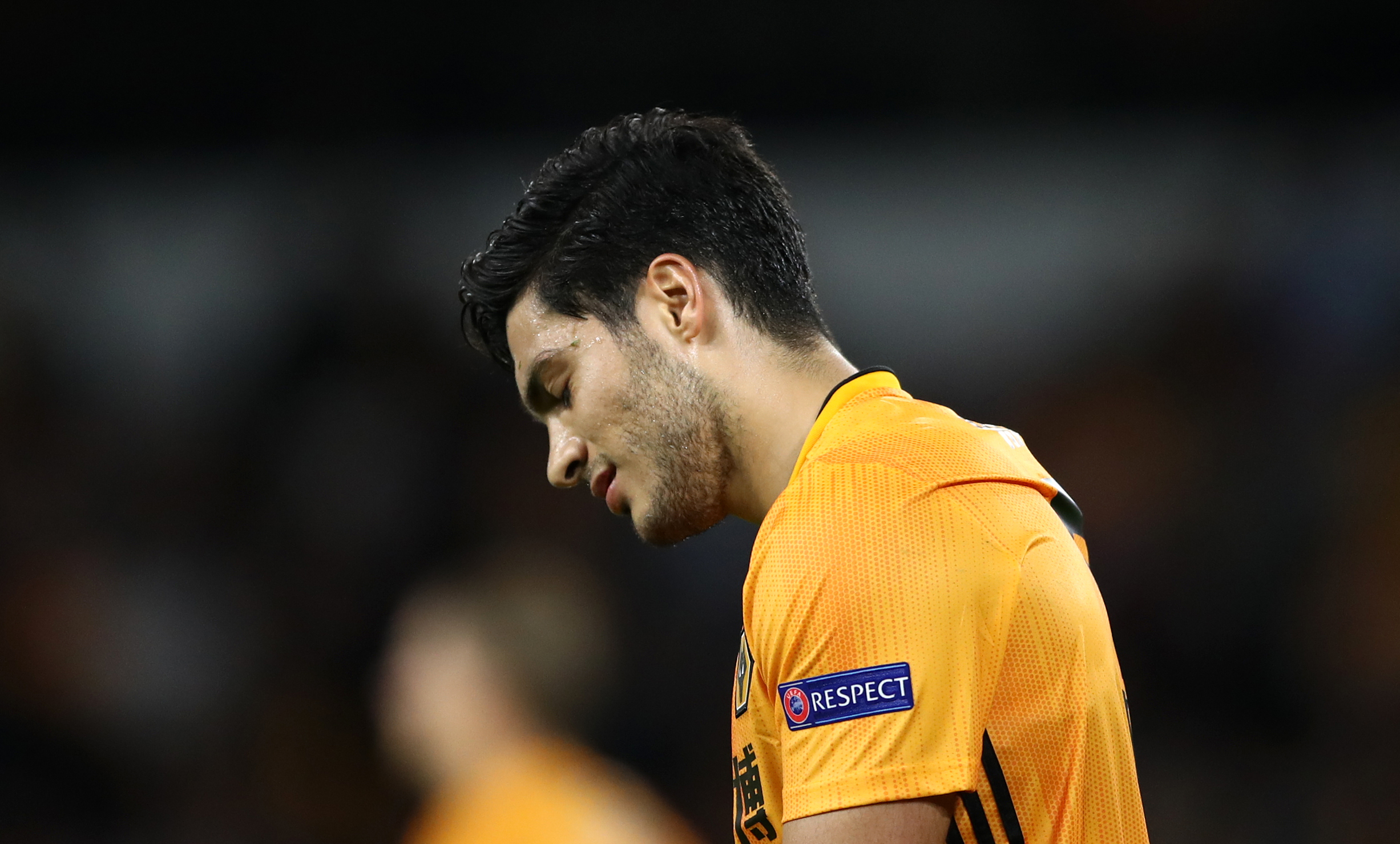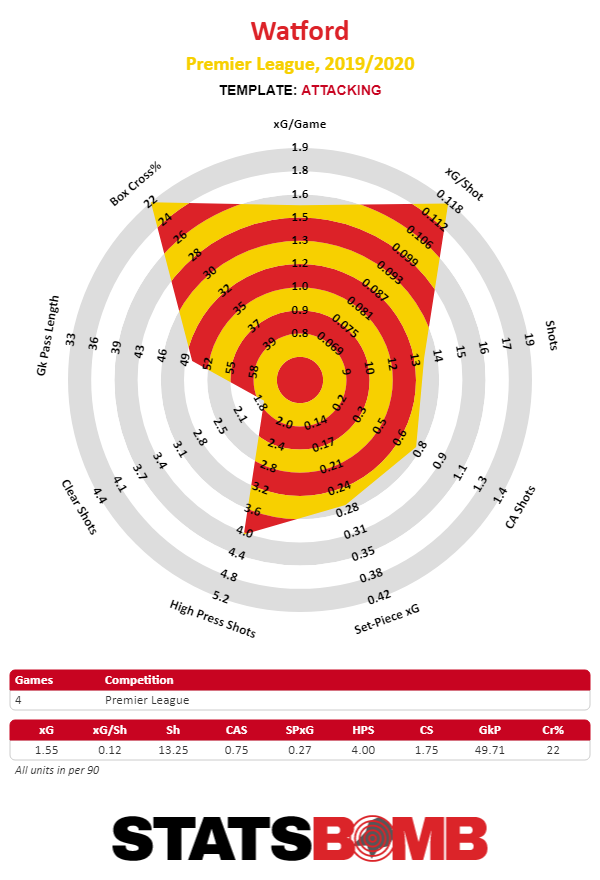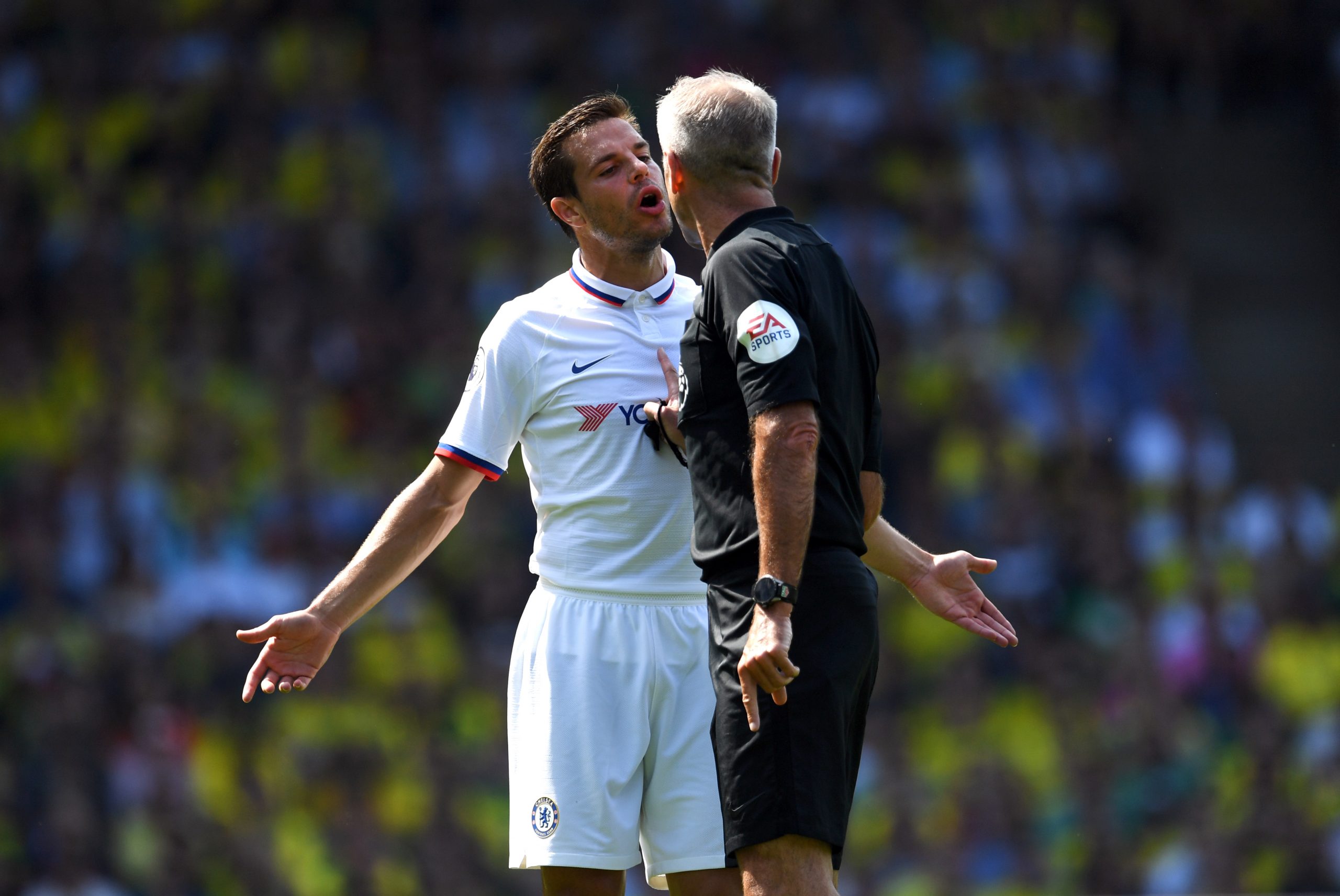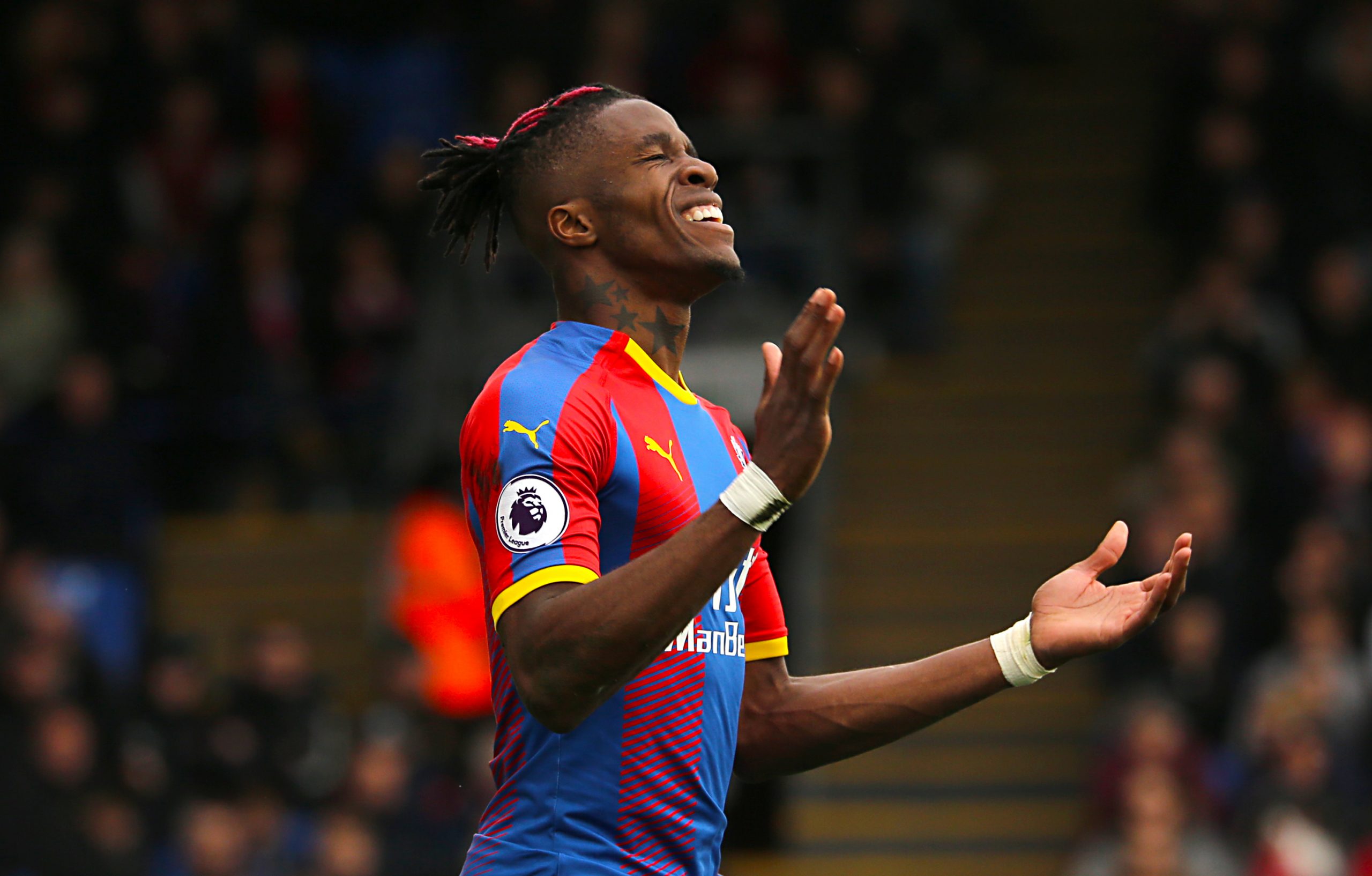Everton are fine. There is, of course, considerable angst about their table position. They sit in 15th place after 12 games, which is certainly not ideal. However, even that perch is better than 17th, the spot they clung to before last weekend’s victory over Southampton. But, contrary to the well-worn phrase, position isn’t everything in life. Everton may be sitting in 15th but they've accumulated 14 points. That’s only three points behind fifth-place Sheffield United. The middle of the Premier League table is extremely congested this season. Two teams have 17 points, three have 16, four have 15 and Everton are accompanied by Tottenham Hotspur on 14. With the midtable brimming with respectable sides, how things look now are certainly not how things will look in a month or two, or even after the games resume in two weeks’ time. Should Everton start winning games, they're likely to fly up the table in a hurry. The real question is, will they start winning games? There’s good news on that front as well. Everton’s lack of points so far this season is not particularly reflective of their underlying performances. In fact, by expected goals, the Toffees seem more like a Europa League level side than a relegation battler. A quick look at their non-penalty xG difference shows they are the sixth most effective team in the Premier League. 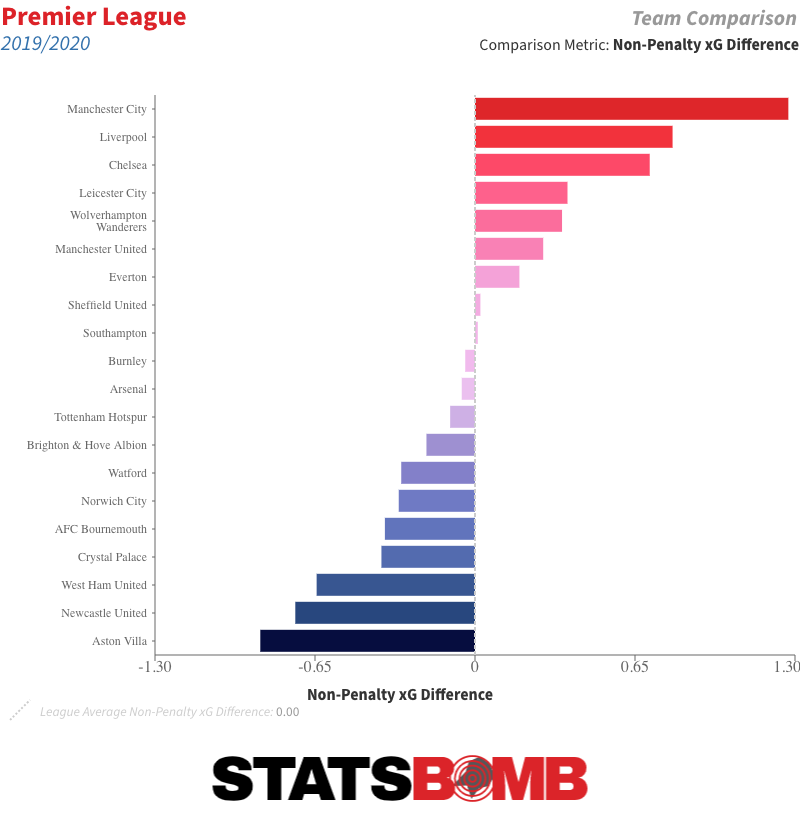 The underlying numbers, at least, show Everton are competent on both sides of the ball. They have the fifth-highest non-penalty xG in the Premier League at 1.32 per match, and the eighth-best non-penalty xG conceded mark at 1.10. These are the kinds of numbers you’d expect from a team competing for a Europa League spot, which at only two points off of seventh place, they technically are. Another way to interpret Everton’s start is to look at the trendlines over the last couple of years. A ten-game rolling average of their xG and xG conceded shows that after playing extremely well at the end of last season, Everton is struggling to keep up their on-fire form. Yet at the same time, there are no real long-term concerns, the trendlines are moving in the right direction, and by and large, Marco Silva has his squad getting the better of things, at least when it comes to expectations.
The underlying numbers, at least, show Everton are competent on both sides of the ball. They have the fifth-highest non-penalty xG in the Premier League at 1.32 per match, and the eighth-best non-penalty xG conceded mark at 1.10. These are the kinds of numbers you’d expect from a team competing for a Europa League spot, which at only two points off of seventh place, they technically are. Another way to interpret Everton’s start is to look at the trendlines over the last couple of years. A ten-game rolling average of their xG and xG conceded shows that after playing extremely well at the end of last season, Everton is struggling to keep up their on-fire form. Yet at the same time, there are no real long-term concerns, the trendlines are moving in the right direction, and by and large, Marco Silva has his squad getting the better of things, at least when it comes to expectations. 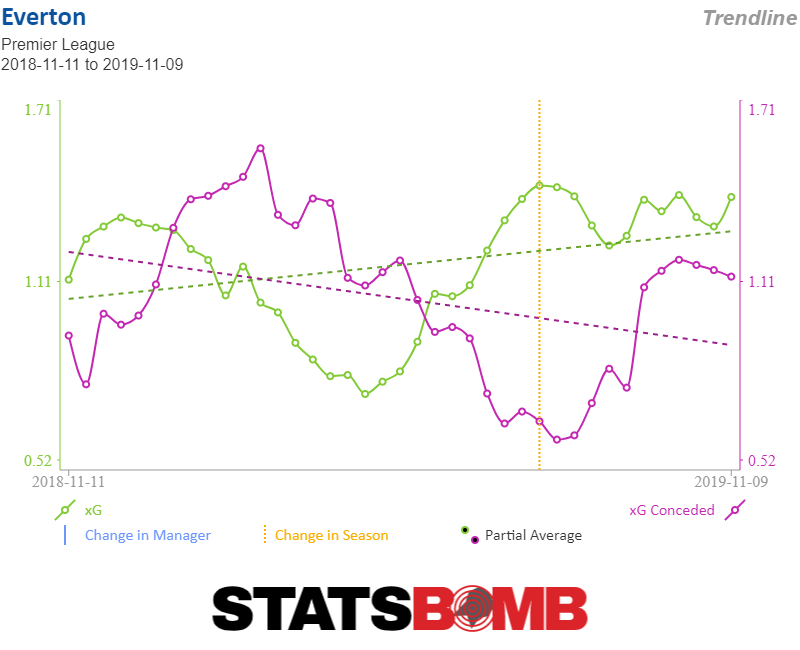 The real problem for Everton is that while their xG has drifted downward from its sky-high perch at the end of last season, their actual goal difference has plummeted. The team is playing somewhat worse, but they’re really getting kicked in the teeth by results. Some of Everton’s lacking point total really is just down to easily identifiable bad luck. There’s not much you can do about finding yourself on the wrong side of a VAR call against Brighton that the Premier League later acknowledged was incorrect. These things might even themselves out in the long run, but 12 games is certainly not the long run.
The real problem for Everton is that while their xG has drifted downward from its sky-high perch at the end of last season, their actual goal difference has plummeted. The team is playing somewhat worse, but they’re really getting kicked in the teeth by results. Some of Everton’s lacking point total really is just down to easily identifiable bad luck. There’s not much you can do about finding yourself on the wrong side of a VAR call against Brighton that the Premier League later acknowledged was incorrect. These things might even themselves out in the long run, but 12 games is certainly not the long run. 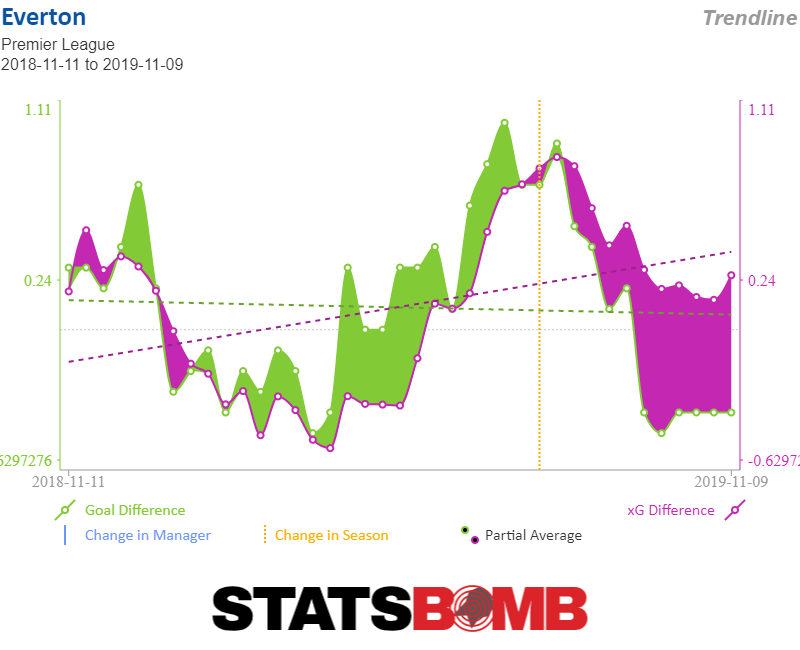 There are, of course, times when xG is misleading, when a fine-grained analysis of tactical choices and personnel decisions will reveal tangible reasons for a team’s actual goals diverging from their expected goals. This doesn’t appear to be one of those times. The team profiles as a fairly typical high pressing aggressive defense. They do most of their defending in the opposition half.
There are, of course, times when xG is misleading, when a fine-grained analysis of tactical choices and personnel decisions will reveal tangible reasons for a team’s actual goals diverging from their expected goals. This doesn’t appear to be one of those times. The team profiles as a fairly typical high pressing aggressive defense. They do most of their defending in the opposition half. 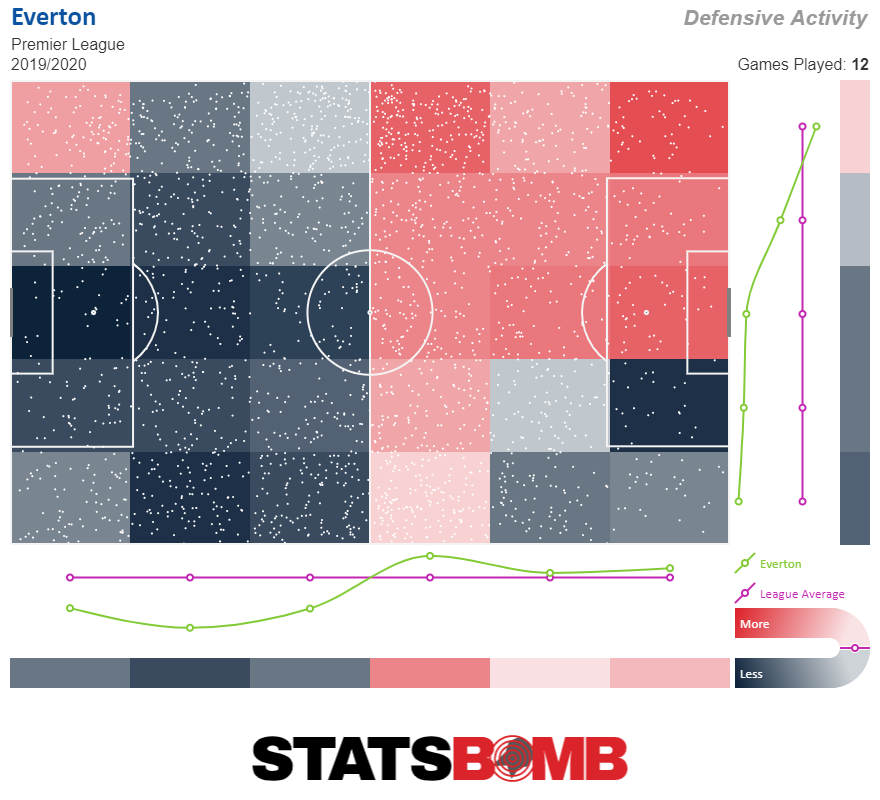 That high press is generally effective, and Everton concede very few shots. Only Manchester City’s 7.42 shots conceded per game ranks below Everton’s 8.42. But, as often happens with aggressive defenses, when the press is broken, Everton’s soft underbelly is exposed. Everton, on average, allow extremely high-quality shots through. Only two teams, Manchester City (again with the aggressive pressing sides) and West Ham, give up higher xG per shot conceded than Everton’s 0.13. Put all those numbers together and it comes out to 13.43 non-penalty xG conceded, but they’ve conceded 17.
That high press is generally effective, and Everton concede very few shots. Only Manchester City’s 7.42 shots conceded per game ranks below Everton’s 8.42. But, as often happens with aggressive defenses, when the press is broken, Everton’s soft underbelly is exposed. Everton, on average, allow extremely high-quality shots through. Only two teams, Manchester City (again with the aggressive pressing sides) and West Ham, give up higher xG per shot conceded than Everton’s 0.13. Put all those numbers together and it comes out to 13.43 non-penalty xG conceded, but they’ve conceded 17. 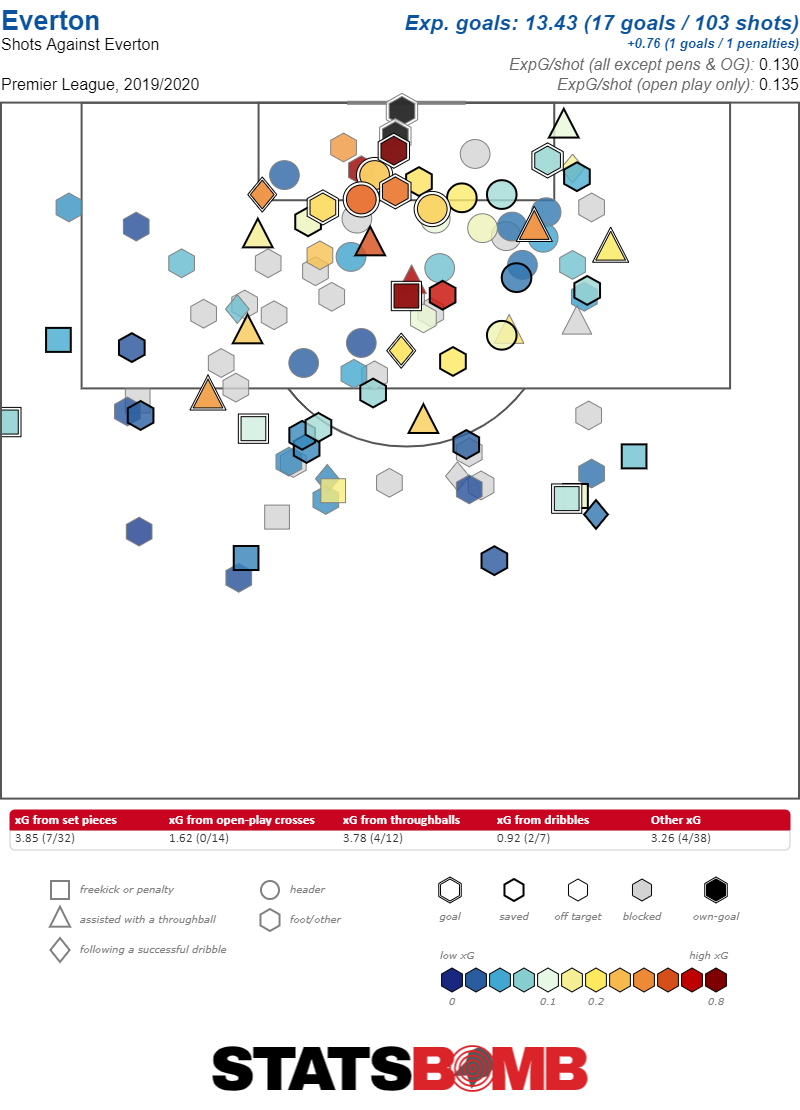 Part of the disconnect is that they’ve conceded two own goals. Own goals are not terribly predictive in and of themselves; even if it might be tempting to suggest they are more likely to happen to a team facing constant pressure, that’s simply not an argument that history supports. So, the fact that Everton have been the victims of two while benefiting from just one is the kind of thing that, again, will work itself out over time. The rest of the difference comes from the fact that Everton’s opponents have put good strikers on the ball. Their opponents have a post-shot xG that’s about a goal higher than their basic xG. Everton keeper Jordan Pickford has had to go flying around his net, where he’s been mostly average at keeping shots out. There’s not a whole lot a team can do when their opponents just keep hitting it sweetly, except, again, trust that the soccer gods are fickle and everybody’s luck turns eventually.
Part of the disconnect is that they’ve conceded two own goals. Own goals are not terribly predictive in and of themselves; even if it might be tempting to suggest they are more likely to happen to a team facing constant pressure, that’s simply not an argument that history supports. So, the fact that Everton have been the victims of two while benefiting from just one is the kind of thing that, again, will work itself out over time. The rest of the difference comes from the fact that Everton’s opponents have put good strikers on the ball. Their opponents have a post-shot xG that’s about a goal higher than their basic xG. Everton keeper Jordan Pickford has had to go flying around his net, where he’s been mostly average at keeping shots out. There’s not a whole lot a team can do when their opponents just keep hitting it sweetly, except, again, trust that the soccer gods are fickle and everybody’s luck turns eventually. 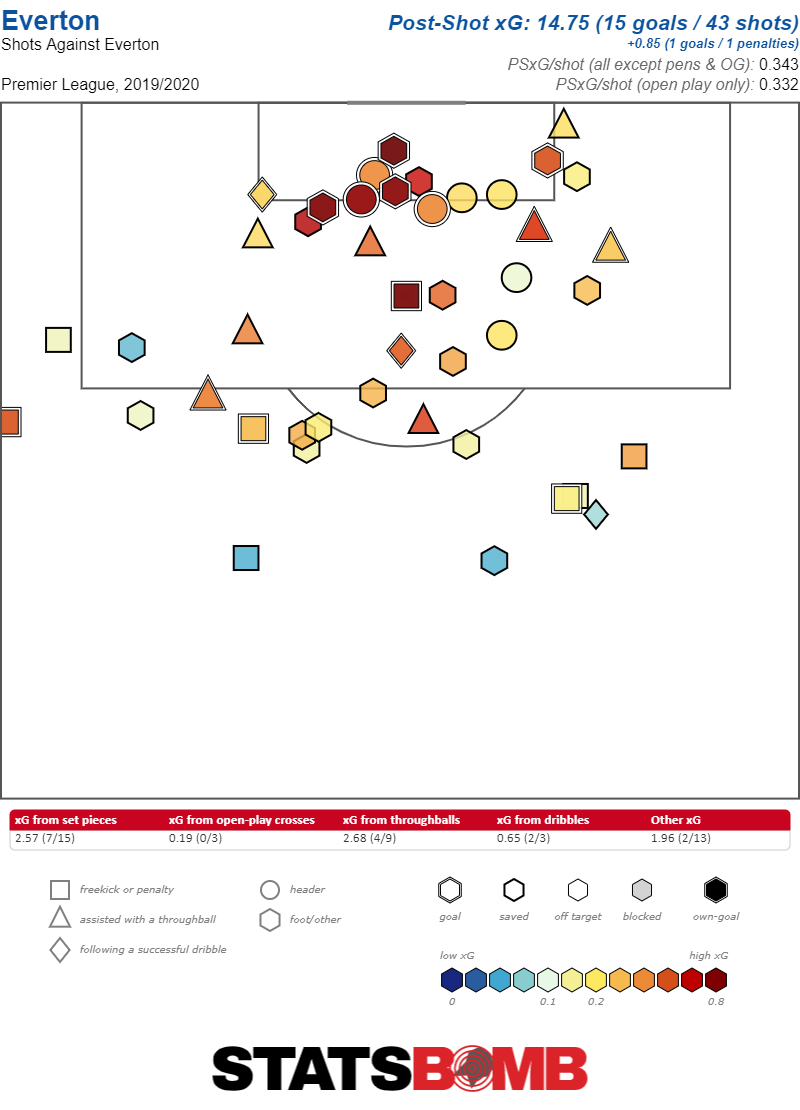 The story is similar on the attacking side of the ball. Everton have been playing well. They’ve created the sixth-most shots in the league, 13.42 per match, at a fairly average xG per shot rate of 0.10, tied for 13th in the Premier League. It’s not the most dynamic way to play, but piling up lots of average shots is a perfectly reasonable way to score goals. The problem is that, again, while the xG is good, 16.07, the actual goals, 13, lag behind. However, as on the defensive side of the ball, a closer examination shows that most of what’s gone wrong is simply that the strikers have run into a number of strong goalkeeper performances. Everton’s post-shot xG is virtually identical to their pre-shot xG, but they’ve only scored 12 goals. That’s as a clear a distillation of keeper performance as you’ll ever see. Everton’s opponents have made a handful of great saves and it’s cost the Toffees points.
The story is similar on the attacking side of the ball. Everton have been playing well. They’ve created the sixth-most shots in the league, 13.42 per match, at a fairly average xG per shot rate of 0.10, tied for 13th in the Premier League. It’s not the most dynamic way to play, but piling up lots of average shots is a perfectly reasonable way to score goals. The problem is that, again, while the xG is good, 16.07, the actual goals, 13, lag behind. However, as on the defensive side of the ball, a closer examination shows that most of what’s gone wrong is simply that the strikers have run into a number of strong goalkeeper performances. Everton’s post-shot xG is virtually identical to their pre-shot xG, but they’ve only scored 12 goals. That’s as a clear a distillation of keeper performance as you’ll ever see. Everton’s opponents have made a handful of great saves and it’s cost the Toffees points. 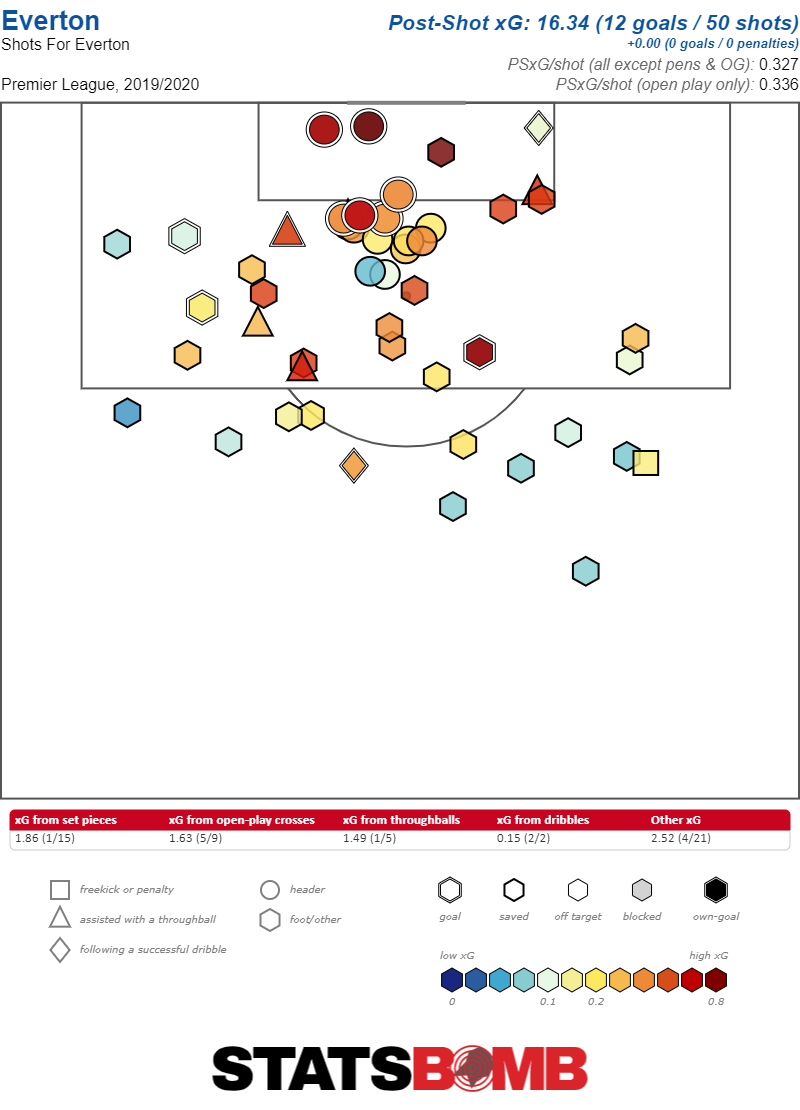 Through 12 games, Everton represent as clear an example of good process and bad results as you’re ever likely to find in the wild. If they keep doing what they’re doing, their results are almost certain to improve. Of course, that’s easier said than done. Playing well but losing is cold comfort, and the league doesn't hand out titles for best process. It is exceedingly difficult to watch your best-laid plans succeed for three months, find yourself nailed to the bottom third of the table, and remain steadfast in your faith that those plans did, in fact, succeed. Everton shouldn’t fire Silva, but they’d be far from the first team to lose faith in a manager after a string of poor results from fine performances. And Silva shouldn’t change the way he sets his team up, but again, better managers than him have reached for solutions to non-existent problems after results didn’t go their way. Up and down the organization, the numbers make it clear that now is the time for both management and the manager to show faith in the project. And that faith is going to be sorely tested, because when the international break ends, Everton get the gift of facing relegation-fodder Norwich City, and then it’s the murderer’s row of the current Premier League top three, with Leicester and Liverpool away followed by Chelsea at Goodison Park. The first 12 games of the season haven’t been an easy time for Everton, but the way forward is clear. As long as they keep playing like this, and their manager is able to keep the performances at the level they’ve been to date, things will improve. And as stern as the tests on the field over the next month will be, the most difficult exam will occur off the pitch. Will Everton be able to keep a steady hand and keep doing the right things, or will bad results ultimately prove too much for a good process to overcome? The answer to that question will define the Toffees' season. Header image courtesy of the Press Association
Through 12 games, Everton represent as clear an example of good process and bad results as you’re ever likely to find in the wild. If they keep doing what they’re doing, their results are almost certain to improve. Of course, that’s easier said than done. Playing well but losing is cold comfort, and the league doesn't hand out titles for best process. It is exceedingly difficult to watch your best-laid plans succeed for three months, find yourself nailed to the bottom third of the table, and remain steadfast in your faith that those plans did, in fact, succeed. Everton shouldn’t fire Silva, but they’d be far from the first team to lose faith in a manager after a string of poor results from fine performances. And Silva shouldn’t change the way he sets his team up, but again, better managers than him have reached for solutions to non-existent problems after results didn’t go their way. Up and down the organization, the numbers make it clear that now is the time for both management and the manager to show faith in the project. And that faith is going to be sorely tested, because when the international break ends, Everton get the gift of facing relegation-fodder Norwich City, and then it’s the murderer’s row of the current Premier League top three, with Leicester and Liverpool away followed by Chelsea at Goodison Park. The first 12 games of the season haven’t been an easy time for Everton, but the way forward is clear. As long as they keep playing like this, and their manager is able to keep the performances at the level they’ve been to date, things will improve. And as stern as the tests on the field over the next month will be, the most difficult exam will occur off the pitch. Will Everton be able to keep a steady hand and keep doing the right things, or will bad results ultimately prove too much for a good process to overcome? The answer to that question will define the Toffees' season. Header image courtesy of the Press Association
Author: Kevin Lawson
Who are the best Premier League goal scorers you're not paying attention to?
The top of the Premier League’s individual expected goals per 90 table is full of all the usual suspects. Exactly half of the top ten (among players with at least 600 minutes on the pitch) are players you’d guess on the first try. Sergio Aguero is still better at scoring goals than everybody. Everybody knows by now that Tammy Abraham is having a star making season. Raheem Sterling, Mohammed Salah, and Sadio Mané are all elite scorers from the wing. They’re all there. But, mixed in are another five players, players who might surprise and amaze you. These are their stories.
Danny Ings: The xG paper tiger
Every year Danny Ings spends part of the season popping up as a surprisingly formidable attacking player. And seemingly every year he squanders his chances, then gets hurt then everybody forgets about him until he starts the next year off in a similarly promising fashion. Ings is once again rocking the attacking production. He’s averaging 0.53 non-penalty xG per 90 minutes. That’s third in the league. He’s doing it by averaging a bunch of shots, 2.94, the ninth highest total in the league and making sure they’re good ones, among players who hit the minutes cutoff and take at least a shot per 90 his 0.18 xG is eight. Imagine Tammy Abraham, take away roughly one shot per match, and that’s what Danny Ings’s numbers look like. As per usual with Ings there’s the caveat that while he’s played the requisite number of minutes, he’s still been used intermittently and has seen less playing time than anybody else in the top ten. 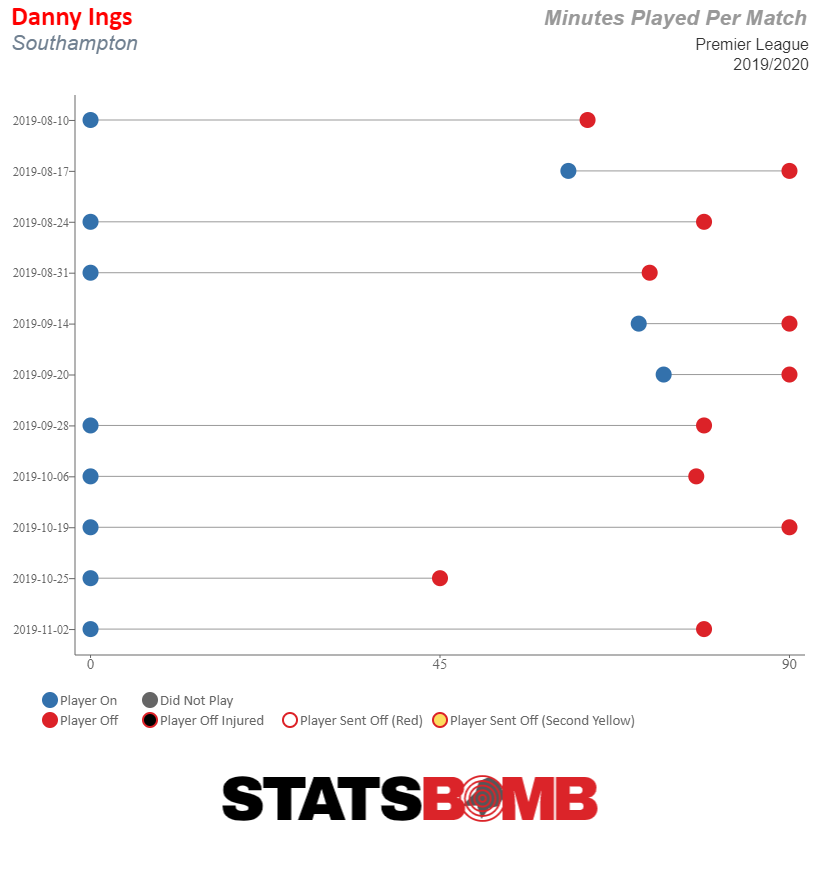 That means we’re only talking about a little over 4 xG and 23 total shots. Still, though, they’re really good shots.
That means we’re only talking about a little over 4 xG and 23 total shots. Still, though, they’re really good shots.
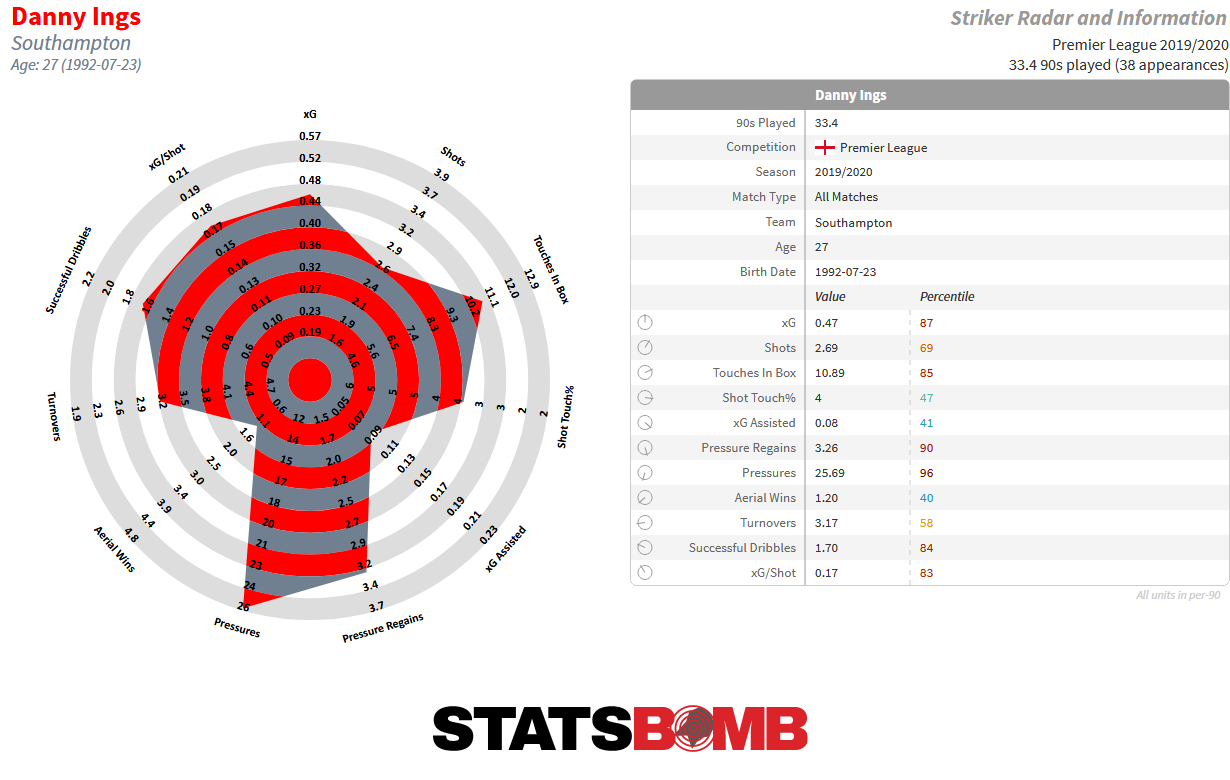 Chris Wood and Ashley Barnes: The dynamic duo
Chris Wood and Ashley Barnes: The dynamic duo
If you’re looking for pairs of elite scorers Manchester City has them all. Aguero and Sterling top the list. After them it’s Aguero and Bernardo Silva, followed by Aguero and David Silva. Then it’s Sterling and Silva, and Sterling and the other Silva. City have the top five pairs. Then, its Salah and Mané who combine for 0.91 xG per 90. But just behind those two. It’s who comes next that’s stunning. Burnley’s set of, apparently world beating strikers, Chris Wood and Ashley Barnes clock in at a combined 0.90 are barely outscored by Liverpool's wingers. The two of them are well matched. Wood shoots less frequently, only 2.00 times per match, the third least frequent shooter of any in the top 20 of xG per 90, but his 0.23 xG per shot is extraordinary. 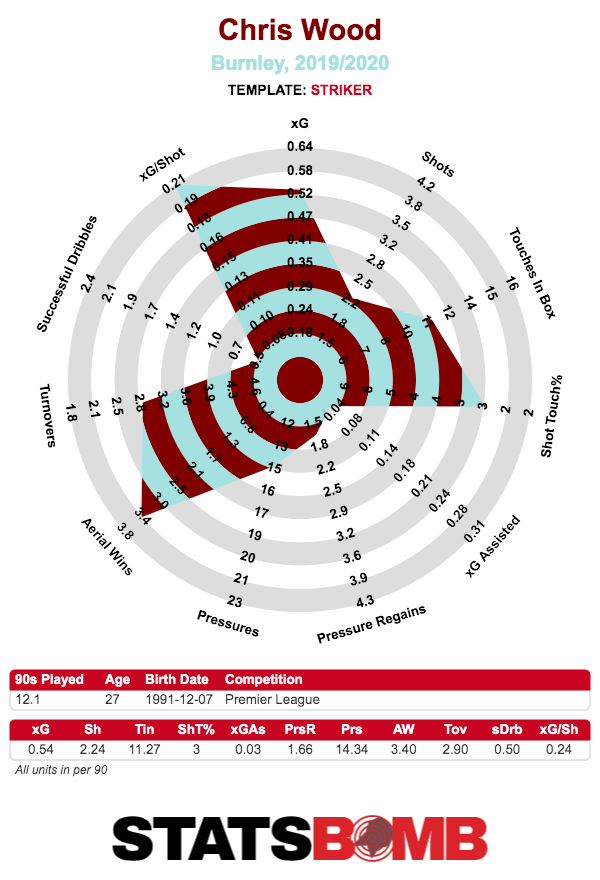 Barnes on the other hand both shoots more, and from somewhat more varied positions, with 3.23 shots per 90 and a still respectfully robust 0.14 xG per shot.
Barnes on the other hand both shoots more, and from somewhat more varied positions, with 3.23 shots per 90 and a still respectfully robust 0.14 xG per shot. 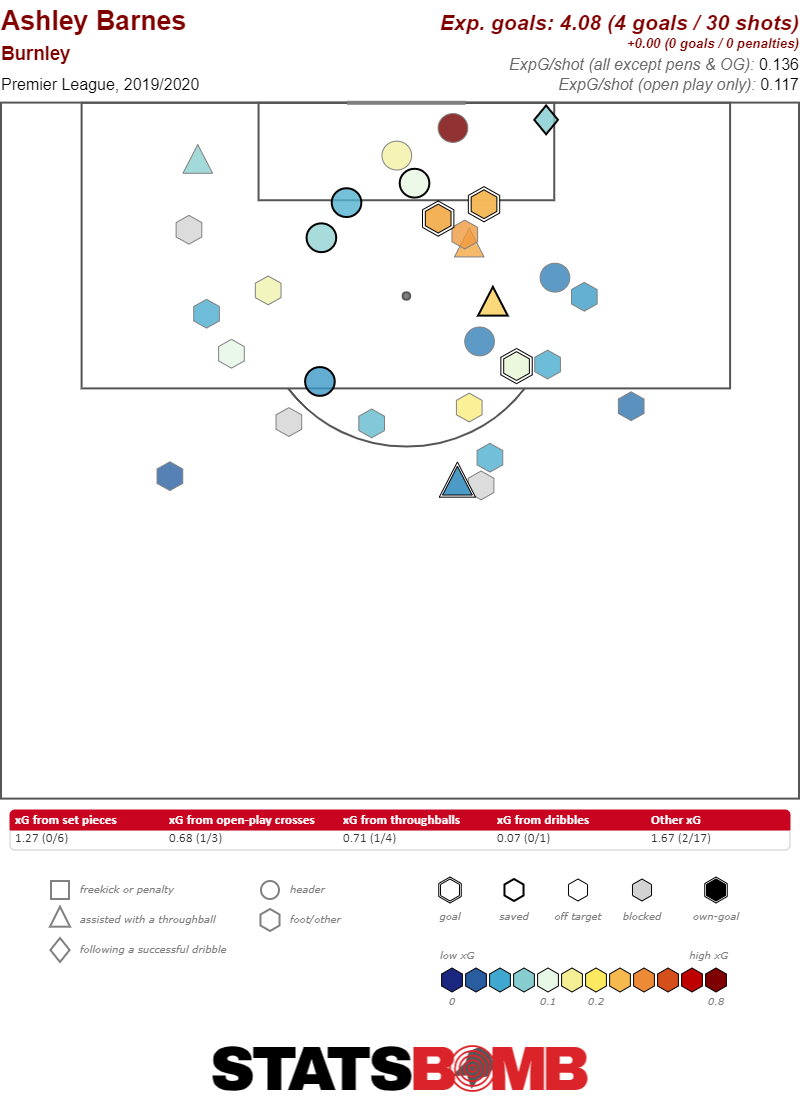 What really makes the Barnes and Wood show so incredible is that Burnley only averages 1.14 xG total per match. It’s really just the two of them holding down the attacking fort.
What really makes the Barnes and Wood show so incredible is that Burnley only averages 1.14 xG total per match. It’s really just the two of them holding down the attacking fort. 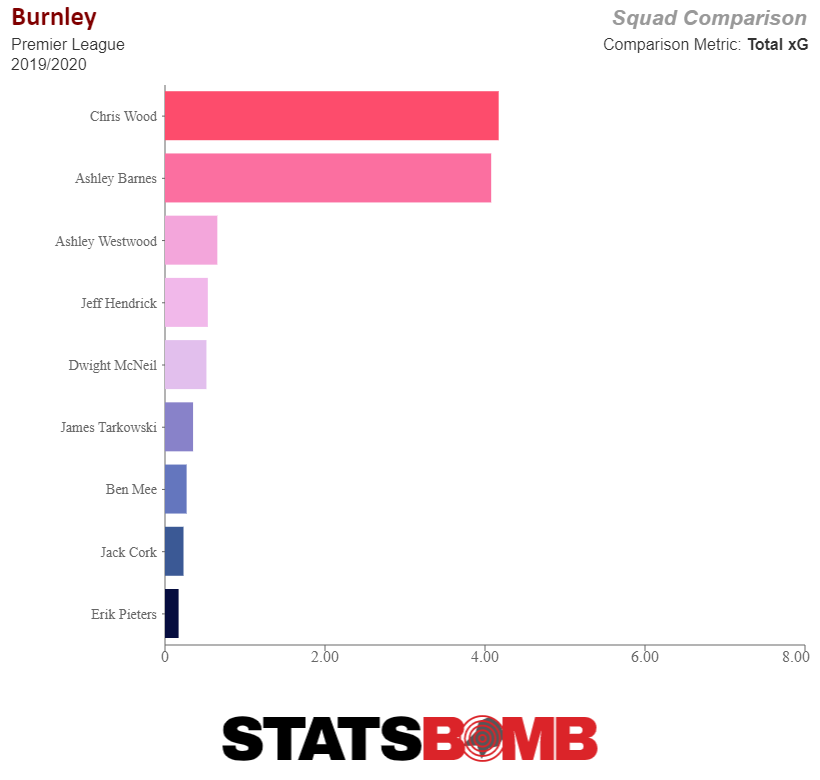 Obviously, City, who have four different players appearing in the top five two-man combinations, aren’t nearly as narrowly reliant, and neither are Liverpool. Here’s how their top two stack up with everybody else. Unsurprisingly Liverpool’s big three are in fact a big three and they have help from the fullbacks.
Obviously, City, who have four different players appearing in the top five two-man combinations, aren’t nearly as narrowly reliant, and neither are Liverpool. Here’s how their top two stack up with everybody else. Unsurprisingly Liverpool’s big three are in fact a big three and they have help from the fullbacks. 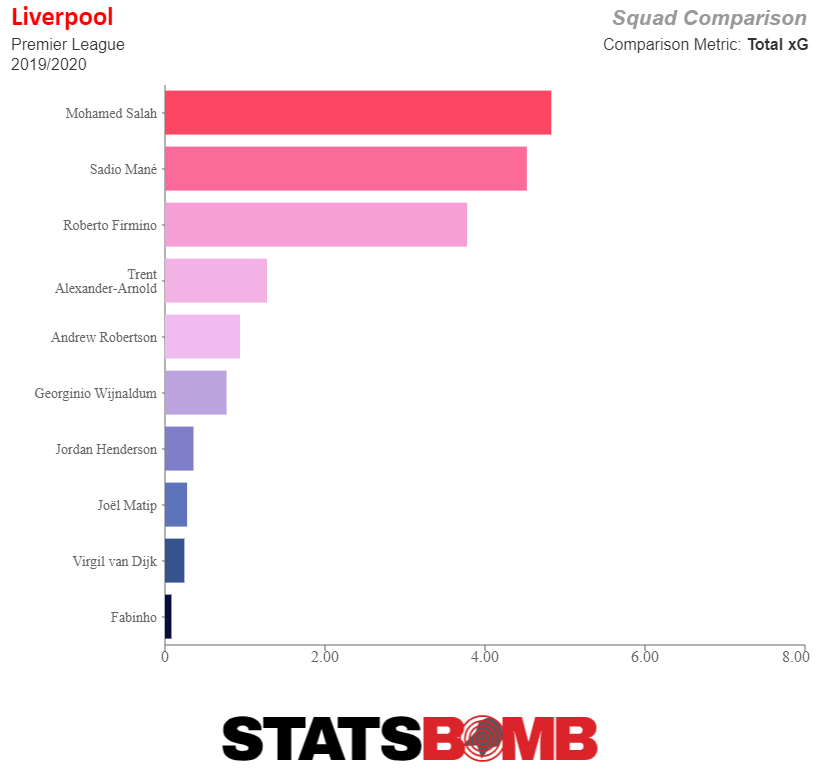 Burnley are a two-man attacking show, and so far this season those two men have been among the best in the league.
Burnley are a two-man attacking show, and so far this season those two men have been among the best in the league.
Neal Maupay: Making the leap at Brighton
It’s easy to miss just how strong Neal Maupay’s start to life at the Premier League level has been. Among the top twenty in xG per 90 only one other player is underperforming their xG total by as much as Maupay who is averaging 0.32 non-penalty goals per 90 against 0.46 xG (though what this means practically given the limited minutes is that he has three goals as opposed to 4.26 xG). He’s in good company though, since the other player significantly under their xG total is Salah. As Brighton’s featured attacker, Maupay shoot a lot, 3.45 times per 90 is fourth most frequent in the Premier League, and while his shot chart can get a little ugly, he keeps the xG per shot at 0.13 which is respectable enough (it is, again, right in line with Salah). 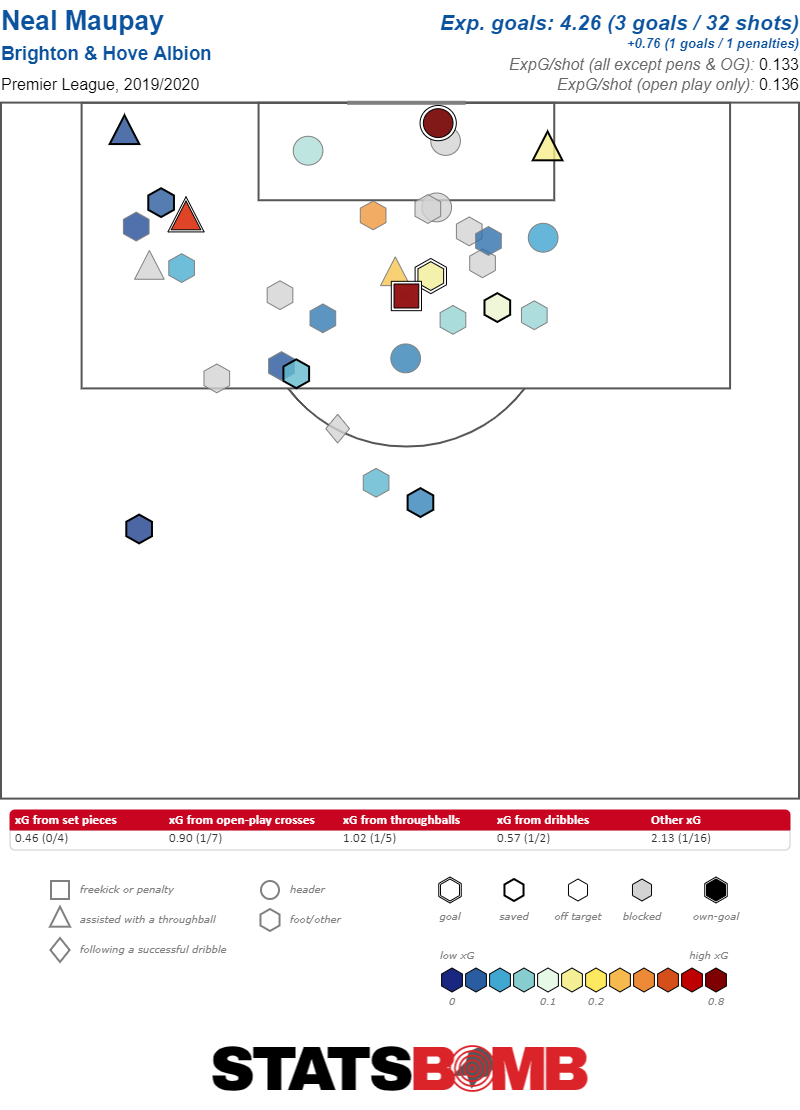 Notably Maupay isn’t just a goal scorer. He’s an acceptable passer, and a defensive contributor as well. It’s still early, of course, but so far he looks like one of the most successful and impactful new signings of the Premier League season.
Notably Maupay isn’t just a goal scorer. He’s an acceptable passer, and a defensive contributor as well. It’s still early, of course, but so far he looks like one of the most successful and impactful new signings of the Premier League season. 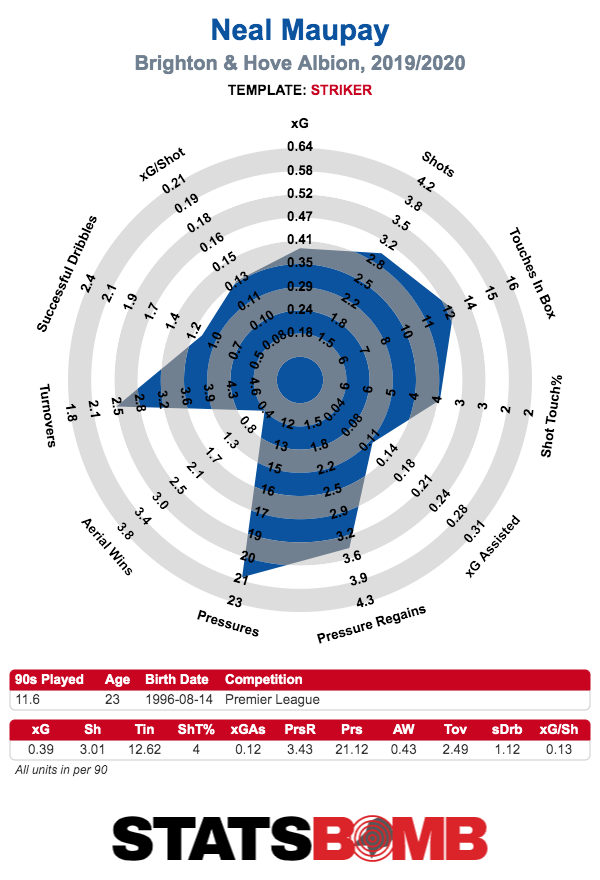
Callum Wilson: Bournemouth’s old reliable
And finally, there’s Callum Wilson. You don’t have to shoot much if when you do shoot, you shot from where Wilson shoots from. The man has five goals from 17 shots, and that’s exactly what xG would predict. Not too shabby. 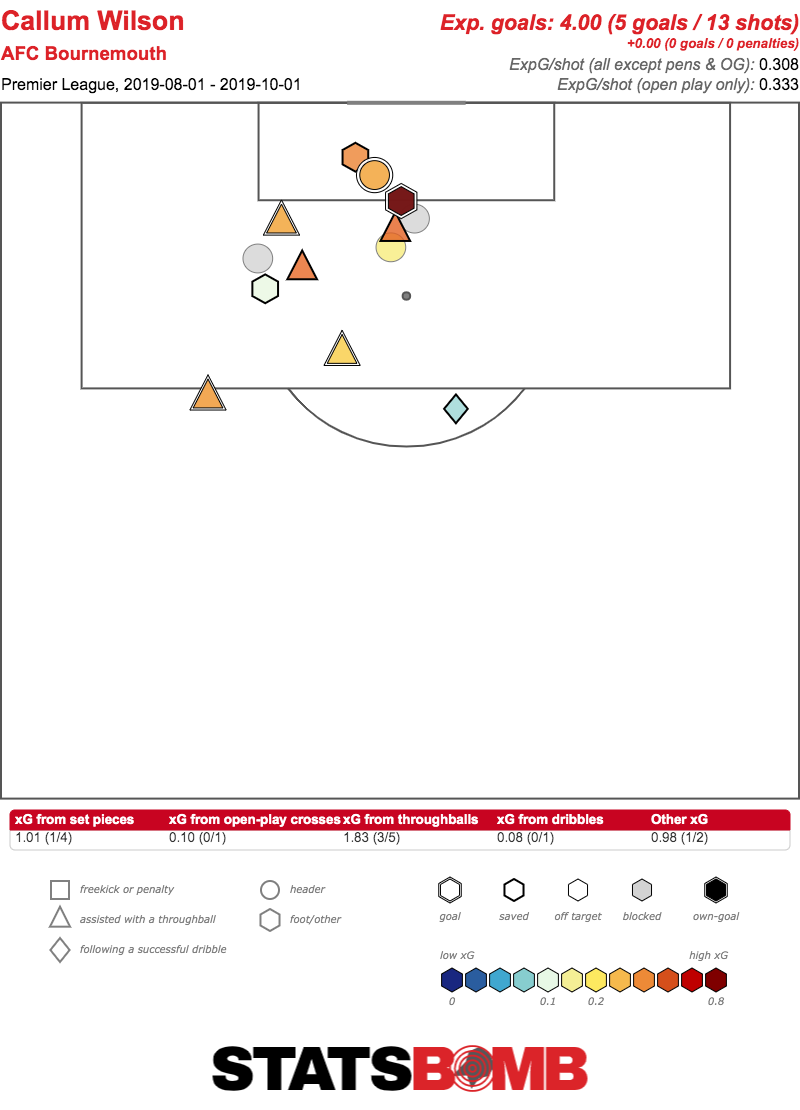
StatsBomb Conference Videos: How to Kick and Save, and Estimating the xG Impact of Actions
We have two more conference videos for you today, both from the research room. First up it's friend of the site Łukasz Szczepański (@footyquant) breaking down the most basic building blocks of the sport with some football analytics for dads. https://www.youtube.com/watch?v=VcmwZWZMc6Q Next up it's Tom Decroos (@TomDecroos) asking, "Is Our Model Learning What We Think It Is?" https://www.youtube.com/watch?v=i7Ra4Qv4_m4&t=7s
StatsBomb Conference Videos: Seth Partnow, Media Panel, and How to Break Down a Set Defense,
Happy Monday! We have three new videos to share with you today. First up it's Seth Partnow (@SethPartnow) and his talk, Anayltics as Vocabulary: https://www.youtube.com/watch?v=_GR0VbrzzFY Next, we have our media panel: Globalized Storytelling: How Media Narrates Football Across the World with Gab Marcotti (@Marcotti), Raphael Honigstein (@Honigstein) and Guillem Balague (@GuillemBalague). https://www.youtube.com/watch?v=3F7K_bK6CQU And finally, we have a research presentation from Daniel Girela (@girela_d), David Perdomo Meza (@dperdomomeza1), Mark Thompson (@EveryTeam_Mark) and the folks at @Twenty3sport. https://www.youtube.com/watch?v=ho3CDJLrNyI
StatsBomb Conference Videos: Working in Football Panel, and Michael Caley
Today for your viewing pleasure we have two more videos from our StatsBomb Innovation in Football Conference. First up we have the Working in Football Panel: Opportunities and Difficulties, with Emma Hayes (Head Coach Chelsea Women), Vosse de Boode (Head of Sports Science and Analytics at Ajax), and Jacqui Oatley MBE (ITV,.Sky, BBC). https://www.youtube.com/watch?v=I82lcPHP5zo From the research room we have Michael Caley (@MC_of_A) and his talk, Pressing, Press-Breaking, and Footedness: Exploring StatsBomb's New Data. https://www.youtube.com/watch?v=CZNHD2MUTlU
StatsBomb Conference Videos: Javi Fernandez and Karun Singh
We're beginning the process of getting our conference videos out into the wide wide world. First up today, we have Javi Fernandez (@JaviOnData) and his talk "Finding the Free Man: A Contextual Approach for Identifying Spaces." https://youtu.be/nfPEEbKJbpM But wait there's more. We also have Karun Singh (@karun1710) and his talk "Expected Threat and Beyond, A Practical Guide." https://youtu.be/mE3sUVCIwfA
Seattle Sounders vs FC Dallas: A case study on using data to prepare to administer the eye test
Over the weekend the Seattle Sounders beat FC Dallas 4-3. It was a rollicking affair that went into extra time with Jordan Morris completing his hattrick and scoring the winner in the 113th minute. Afterwards, Steve Zakuani said this about the match. https://twitter.com/Zakuani11/status/1185685586167775233?s=20 That wasn’t particularly in line with what the statistics of the match suggested. StatsBomb, for example, had the expected goals at 2.98 for Seattle to 1.59 for Dallas. Zakuani didn’t agree with the stats. https://twitter.com/Zakuani11/status/1185700289644335104?s=20 Given his clarification I don’t think there’s anything particularly wrong with what he’s saying about stats here. Football is a game of tiny sample sizes, all good stats work is a matter of interpretation and context. Doing analytics right is a matter of improving the guesses in the guesswork. Beware of anybody selling absolute certainty about anything. But, it did get me thinking about what using stats in concert with your eyes really means on a granular level. What does it mean to reconcile an assessment of this match with stats that tell a dramatically different story. It can’t just be a matter of saying, “stats are good unless I disagree with what they suggest, then I’ll ignore them.” Usually when I write about a match or a team, I make sure to have watched them. It’s exceedingly rare for me to form a strong opinion based on numbers alone. Frequently, however, I’ll be watching things after I’ve already seen the stats for the match. That is, I’m filtering my eye test through what the stats have primed me for, letting the numbers set my expectations. Today, rather than watching the match and writing about it, I’m going to write about what that process looks like. Given the stats I have at my disposal, and Zakuani’s interpretation, one which was echoed by Matt Doyle who knows more than more or less anybody about the goings on in MLS, let's walk through the process of marrying that assessment to the numbers we have at our disposal. Okay, enough throat clearing. By xG, this match was extremely not close. 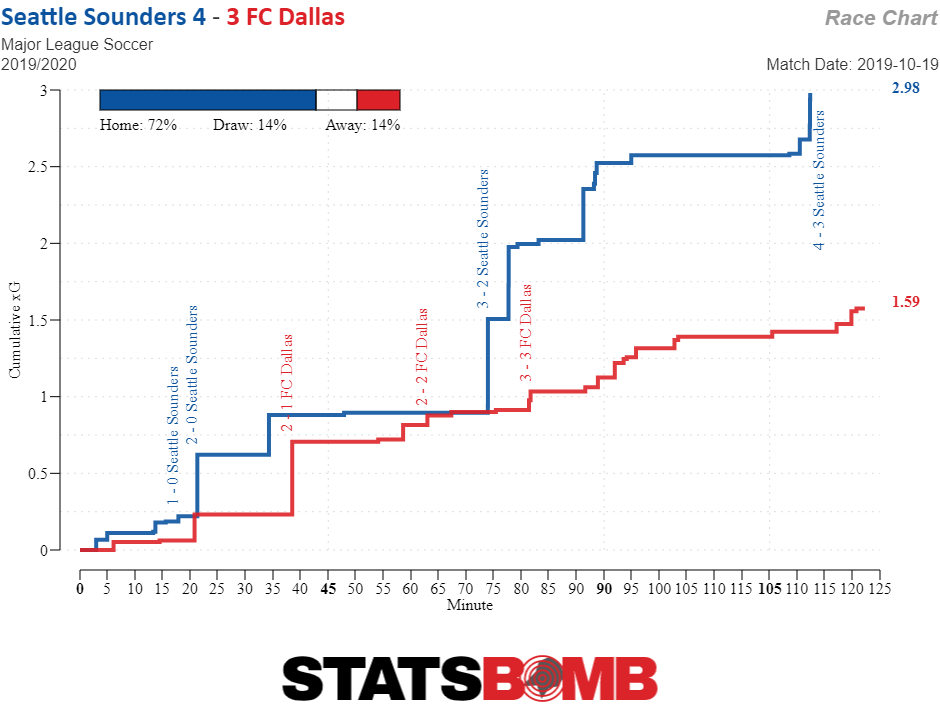 It was a dead even affair until the 74th minute at which point Seattle really pulled away. The mechanics of what happened seem pretty simple. Jordan Morris scored a massive chance from a corner.
It was a dead even affair until the 74th minute at which point Seattle really pulled away. The mechanics of what happened seem pretty simple. Jordan Morris scored a massive chance from a corner. 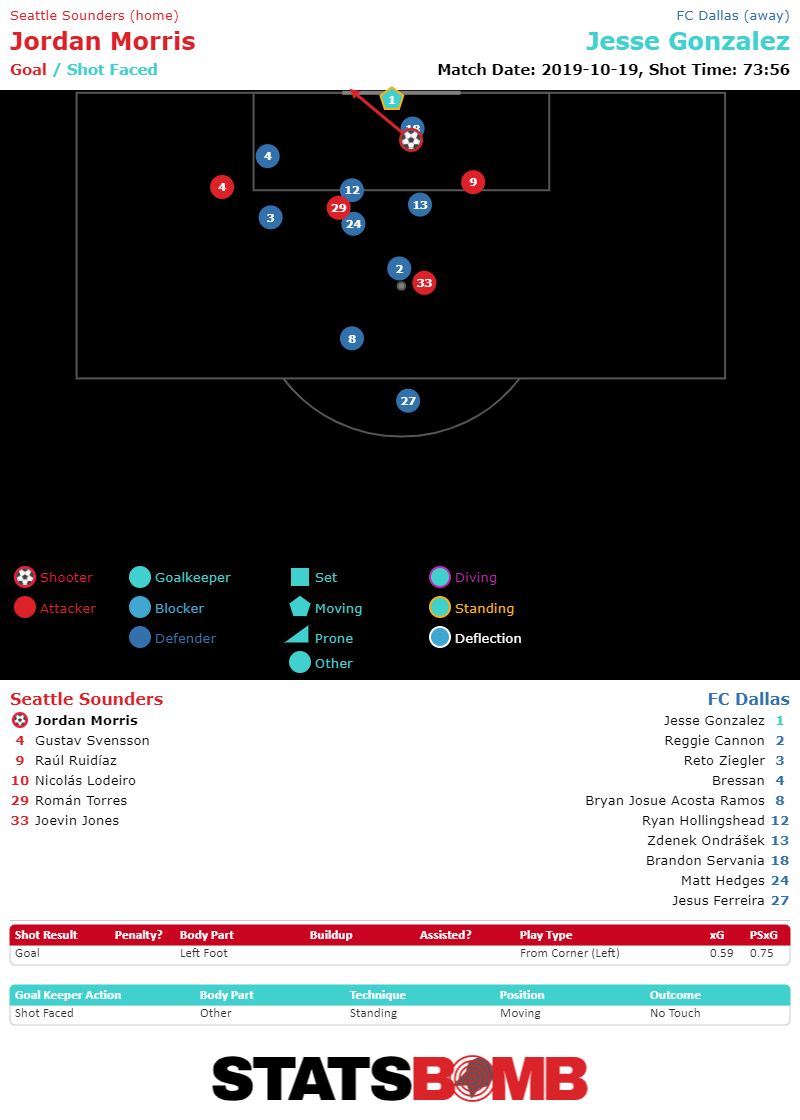 That was followed quite quickly by two pretty good chances from open play. First Victor Rodriguez got this shot off.
That was followed quite quickly by two pretty good chances from open play. First Victor Rodriguez got this shot off. 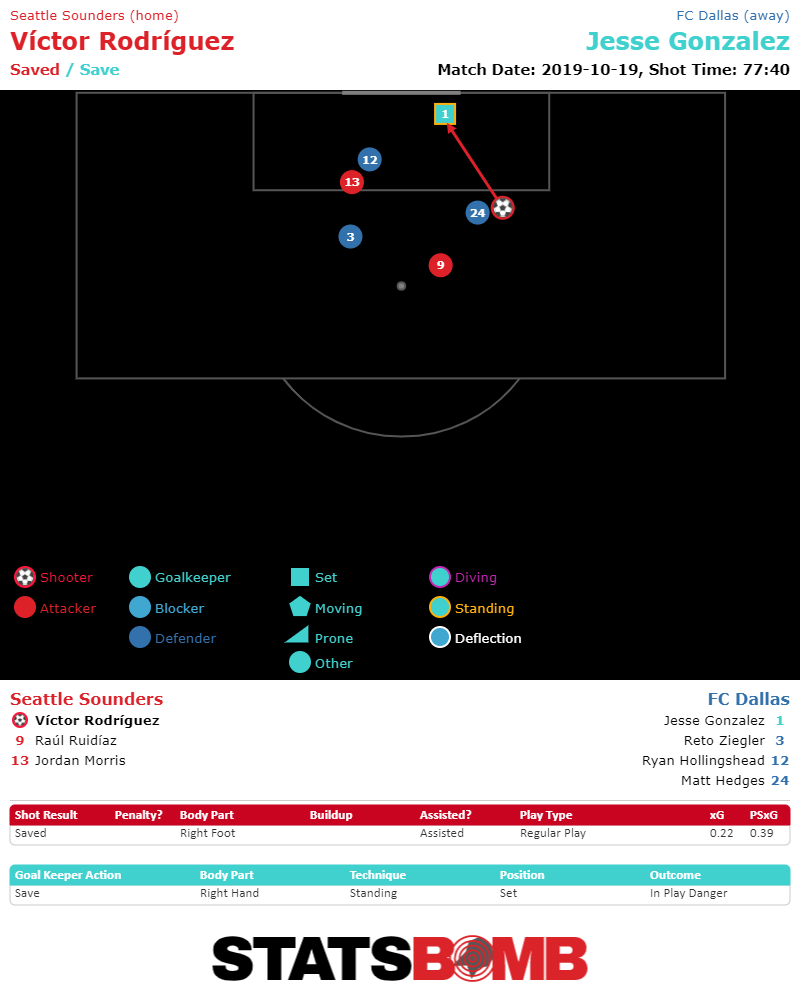 Then Raúl Ruidíaz had this shot blocked from point blank range.
Then Raúl Ruidíaz had this shot blocked from point blank range. 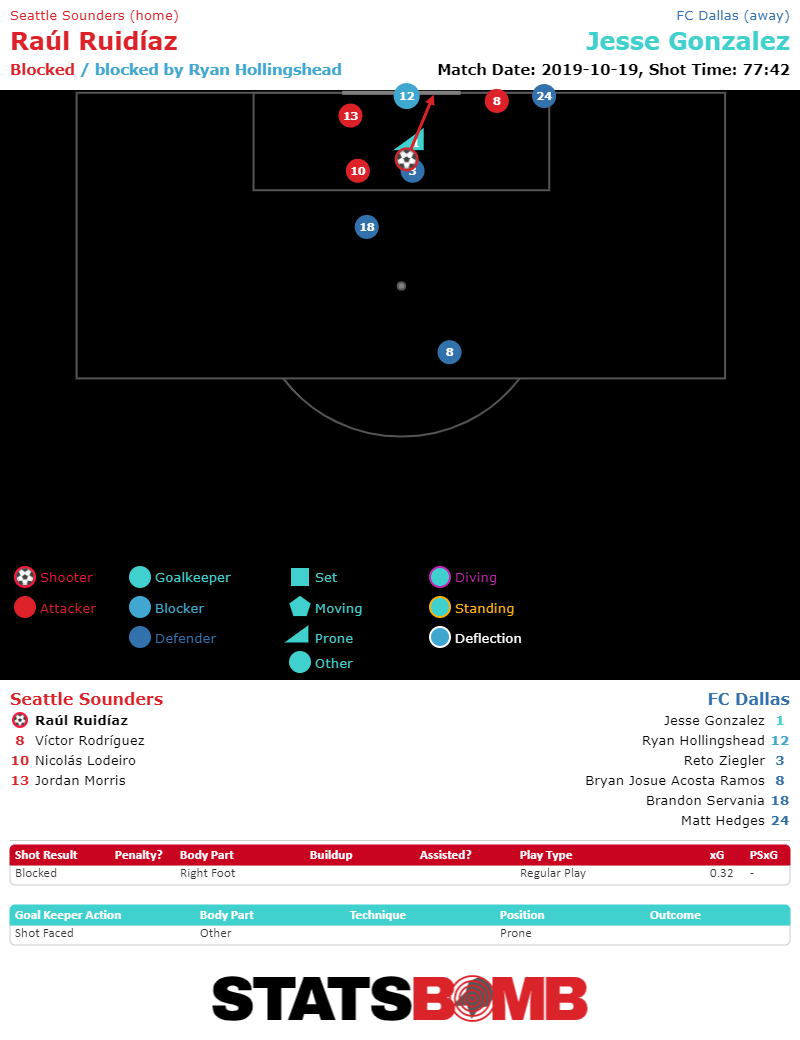 From that point on, Dallas had 11 shots, but not a single one, not even Bryan Acosta’s equalizer was worth even 0.10 xG. Even though the game was tied until late, from an xG perspective that span from 73-78 minutes is what sealed Seattle’s claim to having “played better” from an xG perspective. So, when watching the match I’d want to keep an eye on those chances and see if they were, in fact, as strong as xG believes they were, I’d also want to look at Dallas’s flurry of attempts and see if maybe xG was missing something, and if perhaps Dallas’s chances were more threatening than the calculations appeared to show. In a single game, and especially when looking at a single chance, the error bars around football analytics’ most fundamental building block can be big. Still, that overall xG gap is huge, and I’d expect to walk away from watching the match thinking that even if it wasn’t perfect, it more or less captured a real gap in the value of chances created by the two sides. However, that’s only the beginning of the story. Next, I’d want to look at the teams’ post-shot xG. That is, rather than the measure of the chances created, I want to look at a measure of the quality of the shots that the teams actually took. This is a less predictive measure of a team’s future performance, but it will more closely resemble the actions that took place on the pitch. There are good reasons to prefer xG to post-shot xG when analyzing a team, but given that what we’re trying to do here is both big picture analysis, and garner a small-picture understanding of what went on on the pitch (regardless of its predictive power for the future), it is helpful to look at both. And here something wild jumps out. Seattle’s post-shot xG of 2.92 is fairly in line with their standard xG, but Dallas has a crazy different total. Their post-shot xG is a massive 3.14, way above what their standard xG looks like. On average, Dallas might have created a lot less than Seattle did, but they did the absolute most with it.
From that point on, Dallas had 11 shots, but not a single one, not even Bryan Acosta’s equalizer was worth even 0.10 xG. Even though the game was tied until late, from an xG perspective that span from 73-78 minutes is what sealed Seattle’s claim to having “played better” from an xG perspective. So, when watching the match I’d want to keep an eye on those chances and see if they were, in fact, as strong as xG believes they were, I’d also want to look at Dallas’s flurry of attempts and see if maybe xG was missing something, and if perhaps Dallas’s chances were more threatening than the calculations appeared to show. In a single game, and especially when looking at a single chance, the error bars around football analytics’ most fundamental building block can be big. Still, that overall xG gap is huge, and I’d expect to walk away from watching the match thinking that even if it wasn’t perfect, it more or less captured a real gap in the value of chances created by the two sides. However, that’s only the beginning of the story. Next, I’d want to look at the teams’ post-shot xG. That is, rather than the measure of the chances created, I want to look at a measure of the quality of the shots that the teams actually took. This is a less predictive measure of a team’s future performance, but it will more closely resemble the actions that took place on the pitch. There are good reasons to prefer xG to post-shot xG when analyzing a team, but given that what we’re trying to do here is both big picture analysis, and garner a small-picture understanding of what went on on the pitch (regardless of its predictive power for the future), it is helpful to look at both. And here something wild jumps out. Seattle’s post-shot xG of 2.92 is fairly in line with their standard xG, but Dallas has a crazy different total. Their post-shot xG is a massive 3.14, way above what their standard xG looks like. On average, Dallas might have created a lot less than Seattle did, but they did the absolute most with it. 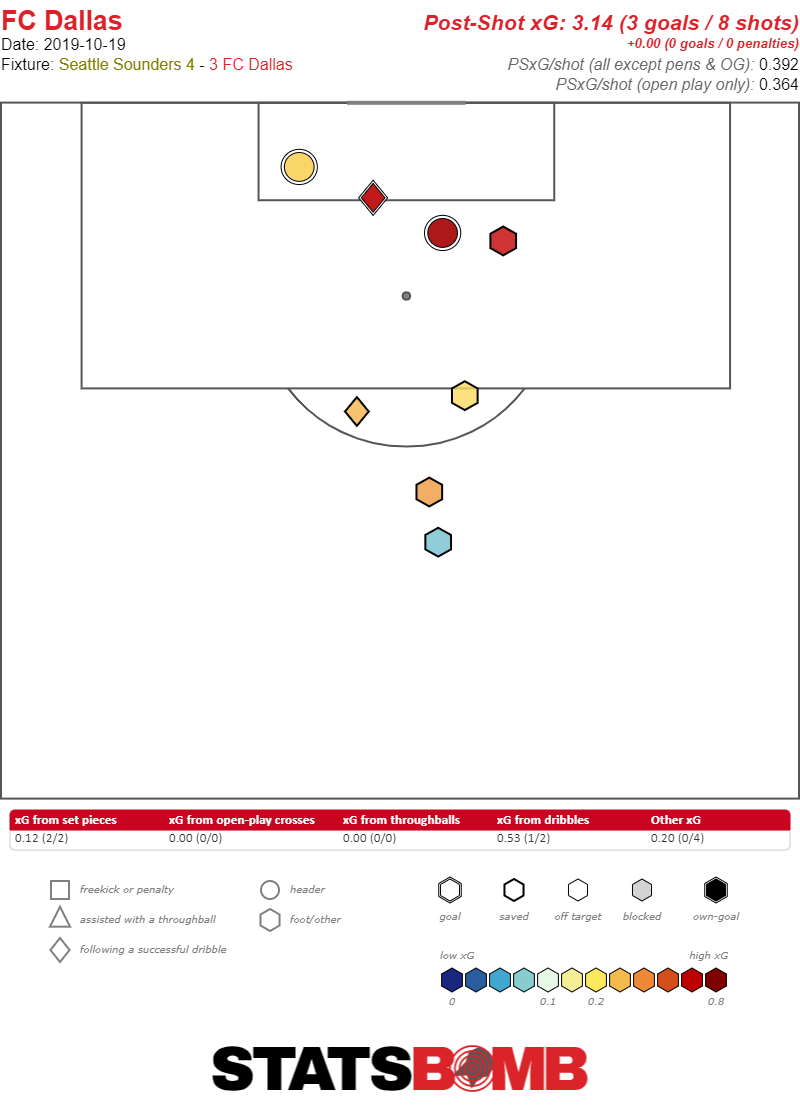 Matt Hedges 63rd minute header pops out as a gorgeously headed ball from the kind of chance that is rarely scored.
Matt Hedges 63rd minute header pops out as a gorgeously headed ball from the kind of chance that is rarely scored. 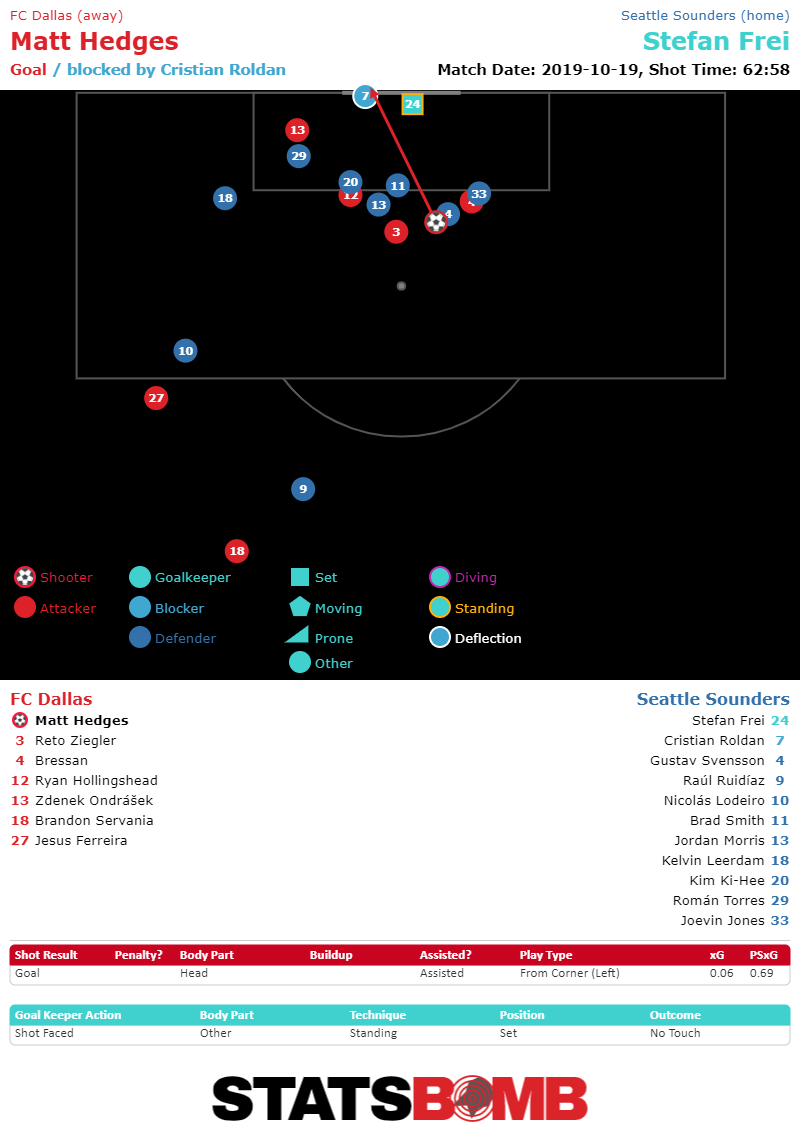 Paxton Pomykal's effort just before the final whistle is similarly notable.
Paxton Pomykal's effort just before the final whistle is similarly notable. 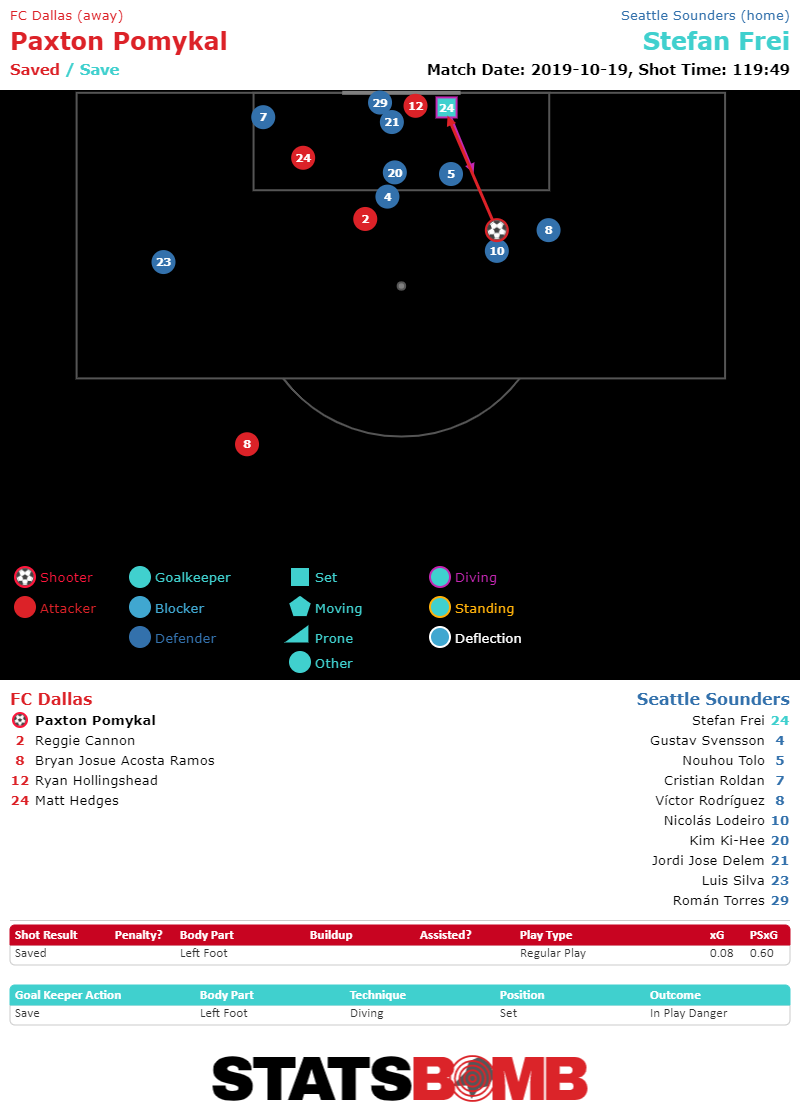 So, how do we reconcile those two numbers. Given the chances created we’d expect Seattle to win this match a lot, somewhere around 72% of the time. However, given what both teams did with those chances it’s reasonable to look at this match and think this easily could have fallen in the other 28%, and Dallas, given how well they struck the actual chances they created, were actually unlucky not to get a little bit more from this match. The analysis then when watching the match is examining that gap. Sometimes a team just hits the ball really well for 90 (or 120 minutes) and there’s not a lot to analyze, but other times there will be reasons that those specific chances appear to be better than xG understands. That’s a major question to answer when watching the match. And this is only looking at shots. You can repeat the same kind of analysis for passing and possessions. We know, for example, that Dallas had more of the ball, completing 568 passes to Seattle’s 457 and completing them at a higher rate, 81% to 77%. So, even before watching the match, the question becomes, if it’s true that Seattle created the better opportunities, why is it true? Were they doing something specific on the defensive side of the ball to foil Dallas’s ability to turn possession into good shots? Or was the problem one of Dallas’s own making? Or neither. Maybe Dallas simply got unlucky with a number of incisive move finishing passes just narrowly missing. Again, this is a specific area of the game to watch closely, determined by looking at numbers beforehand. After looking through the numbers I’d approach watching the game and determining who played better the following way. Going in I’d expect that Seattle would be pretty pleased with their performance. The fact that they walked out of the match with a pretty strong xG edge suggests that they did the kinds of things in this match that are repeatable match to match and week to week. The one major caveat I’d have is that I’d want to watch the defensive side of the ball closely to see if the divergence between Dallas’s xG and post-shot xG was due to mistakes they were making. Dallas, on the other hand, is a trickier question. The first thing I’d be looking for is their finishing. I’m looking for reasons that their post-shot xG diverged so heavily from their normal xG. There may not be any, it may be they just got hot and it almost bailed them out in a match were they were decidedly the worse team. On the other hand, it’s certainly possible that a handful of the shots they got off were, in fact, deceptively good attempts. The fact that, on average, xG evens out doesn’t mean that you can’t gain fleeting edges in a match (or have other teams gain fleeting edges against you) thanks to either smart tactical planning or winning individual matchups, or any one of the hundreds of things that go on in a soccer match. Of course, that stuff evens out over the long run, but we’re not analyzing the long run. Secondly, I’d want to watch Dallas’s possession in the final third. Determining whether they played well will rest heavily on figuring out why they managed to create so few shots that were actually highly valued by xG. Teasing out the answer to that question, and whether to blame Dallas, credit Seattle, or simply shrug and raise your hands to the soccer gods, will go a long way to determining exactly how highly to value Dallas’s performance. I admit that I’m skeptical that when I watch this match I’ll walk away thinking Dallas played better. I think that by far the most likely conclusion to draw is that Dallas’s somewhat sterile possession and hot shooting combined with Seattle missing a handful of good but not great chances to give the impression of a match that was much closer than it was. That’s not a definite conclusion though, it’s a hypothesis formed by data. Forming a strong hypothesis is important, but you also have to then go and test it. And that’s what watching the games is for.
So, how do we reconcile those two numbers. Given the chances created we’d expect Seattle to win this match a lot, somewhere around 72% of the time. However, given what both teams did with those chances it’s reasonable to look at this match and think this easily could have fallen in the other 28%, and Dallas, given how well they struck the actual chances they created, were actually unlucky not to get a little bit more from this match. The analysis then when watching the match is examining that gap. Sometimes a team just hits the ball really well for 90 (or 120 minutes) and there’s not a lot to analyze, but other times there will be reasons that those specific chances appear to be better than xG understands. That’s a major question to answer when watching the match. And this is only looking at shots. You can repeat the same kind of analysis for passing and possessions. We know, for example, that Dallas had more of the ball, completing 568 passes to Seattle’s 457 and completing them at a higher rate, 81% to 77%. So, even before watching the match, the question becomes, if it’s true that Seattle created the better opportunities, why is it true? Were they doing something specific on the defensive side of the ball to foil Dallas’s ability to turn possession into good shots? Or was the problem one of Dallas’s own making? Or neither. Maybe Dallas simply got unlucky with a number of incisive move finishing passes just narrowly missing. Again, this is a specific area of the game to watch closely, determined by looking at numbers beforehand. After looking through the numbers I’d approach watching the game and determining who played better the following way. Going in I’d expect that Seattle would be pretty pleased with their performance. The fact that they walked out of the match with a pretty strong xG edge suggests that they did the kinds of things in this match that are repeatable match to match and week to week. The one major caveat I’d have is that I’d want to watch the defensive side of the ball closely to see if the divergence between Dallas’s xG and post-shot xG was due to mistakes they were making. Dallas, on the other hand, is a trickier question. The first thing I’d be looking for is their finishing. I’m looking for reasons that their post-shot xG diverged so heavily from their normal xG. There may not be any, it may be they just got hot and it almost bailed them out in a match were they were decidedly the worse team. On the other hand, it’s certainly possible that a handful of the shots they got off were, in fact, deceptively good attempts. The fact that, on average, xG evens out doesn’t mean that you can’t gain fleeting edges in a match (or have other teams gain fleeting edges against you) thanks to either smart tactical planning or winning individual matchups, or any one of the hundreds of things that go on in a soccer match. Of course, that stuff evens out over the long run, but we’re not analyzing the long run. Secondly, I’d want to watch Dallas’s possession in the final third. Determining whether they played well will rest heavily on figuring out why they managed to create so few shots that were actually highly valued by xG. Teasing out the answer to that question, and whether to blame Dallas, credit Seattle, or simply shrug and raise your hands to the soccer gods, will go a long way to determining exactly how highly to value Dallas’s performance. I admit that I’m skeptical that when I watch this match I’ll walk away thinking Dallas played better. I think that by far the most likely conclusion to draw is that Dallas’s somewhat sterile possession and hot shooting combined with Seattle missing a handful of good but not great chances to give the impression of a match that was much closer than it was. That’s not a definite conclusion though, it’s a hypothesis formed by data. Forming a strong hypothesis is important, but you also have to then go and test it. And that’s what watching the games is for.
Who's gonna fix Wolves?
Things are not great in Wolverhampton. Wolves sit second to the last in the table, one of only two teams without a victory. Only fellow winless side Watford are preventing them from sitting in dead last. This was a team that finished seventh best last season, with numbers that were arguably better than that. So what’s going on? Is it time for Wolves to panic? The first place to look, as always, is at the expected goals. There’s some good news here for Wolves. In attack they’re basically running at xG with six goals for against 5.61 xG (plus a penalty). 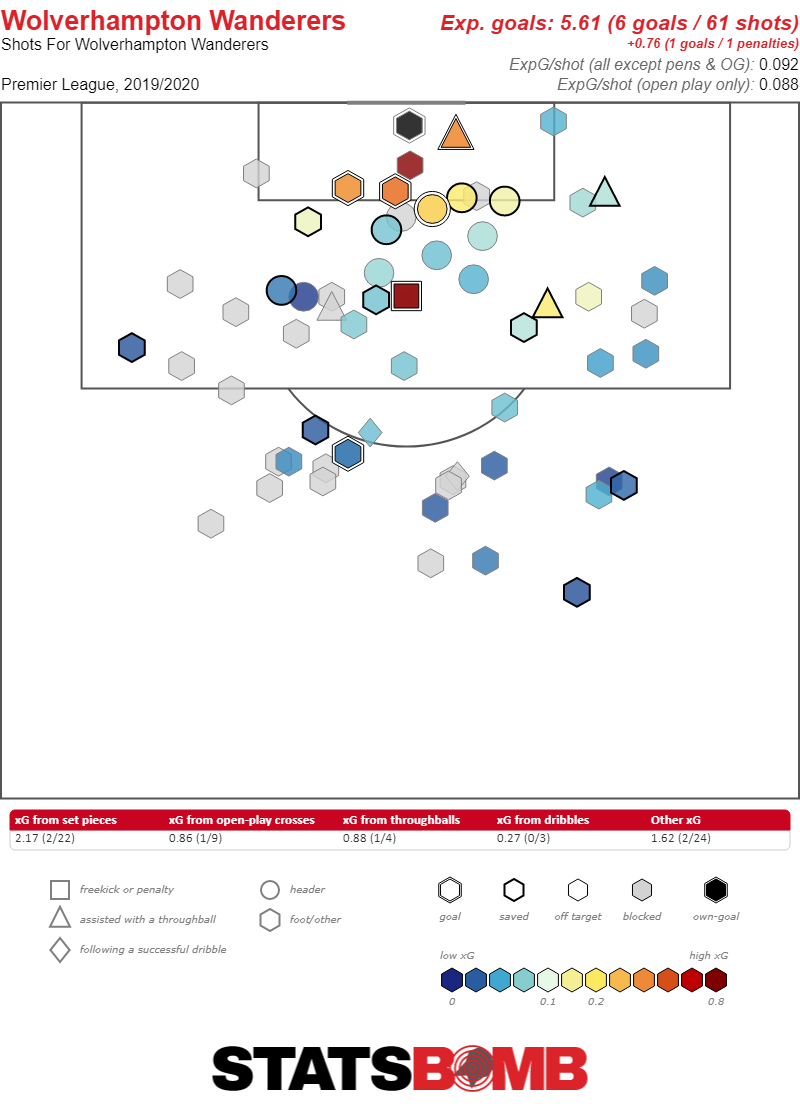 On the defensive side of the ball is where the good news is. Sure they’ve given up 11 goals, but only 6.49 expected goals. That’s exactly the kind of performance you’d expect to see turn around without doing too much of anything different.
On the defensive side of the ball is where the good news is. Sure they’ve given up 11 goals, but only 6.49 expected goals. That’s exactly the kind of performance you’d expect to see turn around without doing too much of anything different. 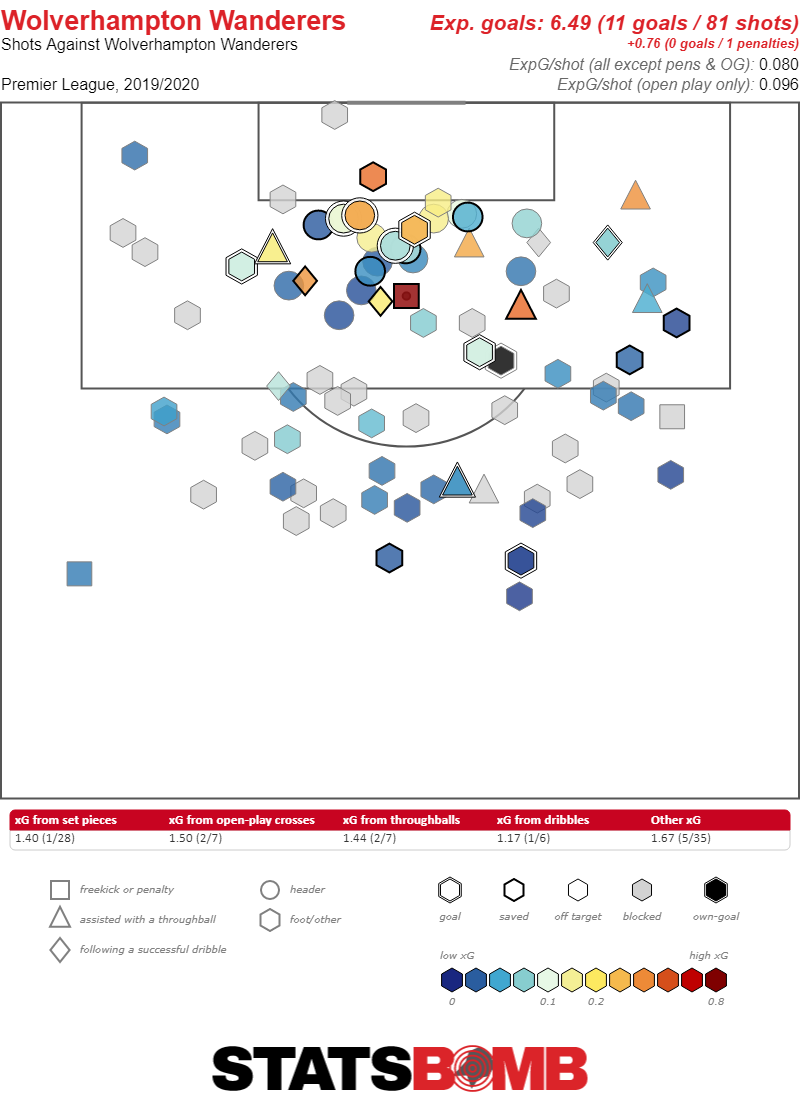 Specifically all of that extra conceding seems like it’s down mostly to keeper So far this season he has the worst goals saved above average % of any regular starting keeper in the Premier League. He’s only saved 50% of the shots he’s faced while his expected average giving those shots is 66.1%. That’s really bad! Patricio’s -16.1 GSAA% is significantly behind Everton’s Jordan Pickford at -9.9% and Chelsea’s Kepa Arrizabalaga’s -9.1%.
Specifically all of that extra conceding seems like it’s down mostly to keeper So far this season he has the worst goals saved above average % of any regular starting keeper in the Premier League. He’s only saved 50% of the shots he’s faced while his expected average giving those shots is 66.1%. That’s really bad! Patricio’s -16.1 GSAA% is significantly behind Everton’s Jordan Pickford at -9.9% and Chelsea’s Kepa Arrizabalaga’s -9.1%. 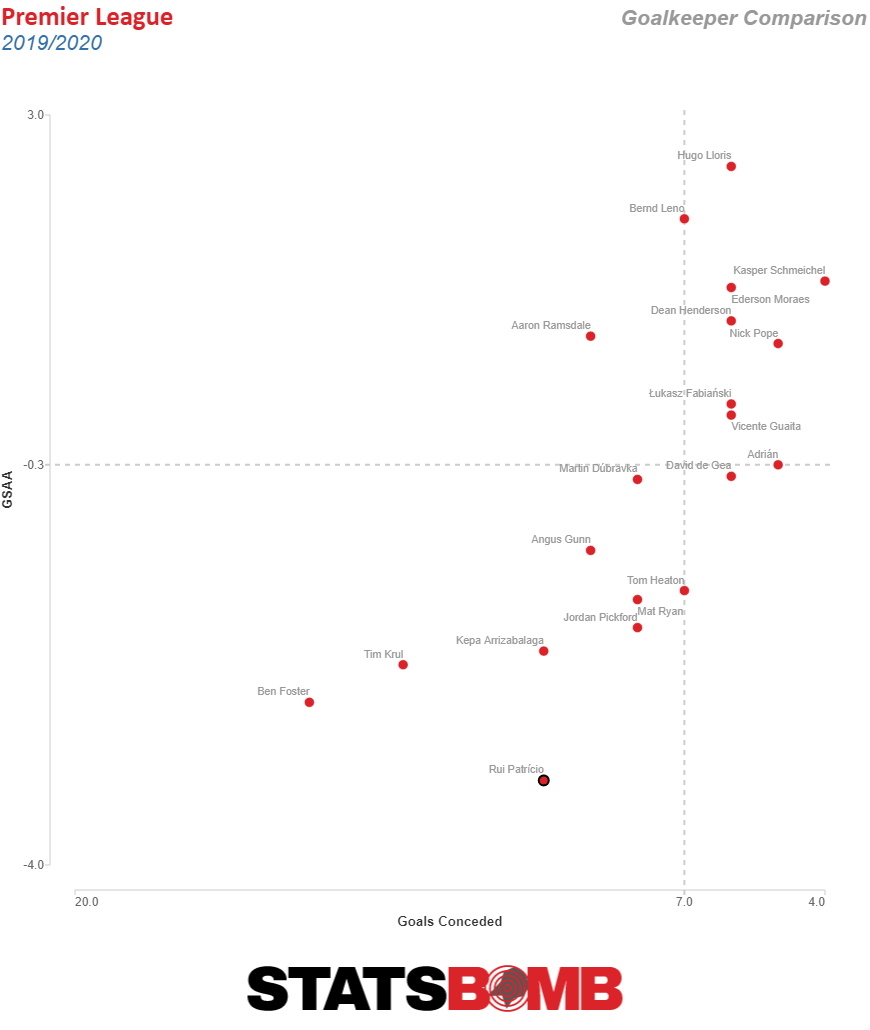 Encouragingly for Wolves, last year Patricio’s was almost exactly flat against expectation. He saved 71% of shots and was expected to save 71.1%. So this horrible form will probably work itself out. They don’t need him to be great this season, they just need him to be fine. So far, he hasn’t been, but there’s not a ton of reason to suspect he won’t be going forward. So that’s the good news. Here’s the bad news. Even adjusting for the unexpected defensive lapses, Wolves haven’t been nearly as good as last season. Last season StatsBomb had their xG difference at 0.28 per match, virtually tied with Spurs for the fourth best in the Premier League. This season, so far it’s dropped to -0.16. That’s not nearly bad enough to be where they are in the table, but it’s not in any way remarkable. It’s just outside the top half of the table (and interestingly enough again virtually tied with Spurs). That difference amounts to almost half a goal per match, or just under three goals in six games. For a team that’s drawn four times and lost another match by a single goal, that’s a massive difference. Their sixth match, a 2-5 home defeat to Chelsea was one of the wilder mostly balanced xG matches you will find.
Encouragingly for Wolves, last year Patricio’s was almost exactly flat against expectation. He saved 71% of shots and was expected to save 71.1%. So this horrible form will probably work itself out. They don’t need him to be great this season, they just need him to be fine. So far, he hasn’t been, but there’s not a ton of reason to suspect he won’t be going forward. So that’s the good news. Here’s the bad news. Even adjusting for the unexpected defensive lapses, Wolves haven’t been nearly as good as last season. Last season StatsBomb had their xG difference at 0.28 per match, virtually tied with Spurs for the fourth best in the Premier League. This season, so far it’s dropped to -0.16. That’s not nearly bad enough to be where they are in the table, but it’s not in any way remarkable. It’s just outside the top half of the table (and interestingly enough again virtually tied with Spurs). That difference amounts to almost half a goal per match, or just under three goals in six games. For a team that’s drawn four times and lost another match by a single goal, that’s a massive difference. Their sixth match, a 2-5 home defeat to Chelsea was one of the wilder mostly balanced xG matches you will find. 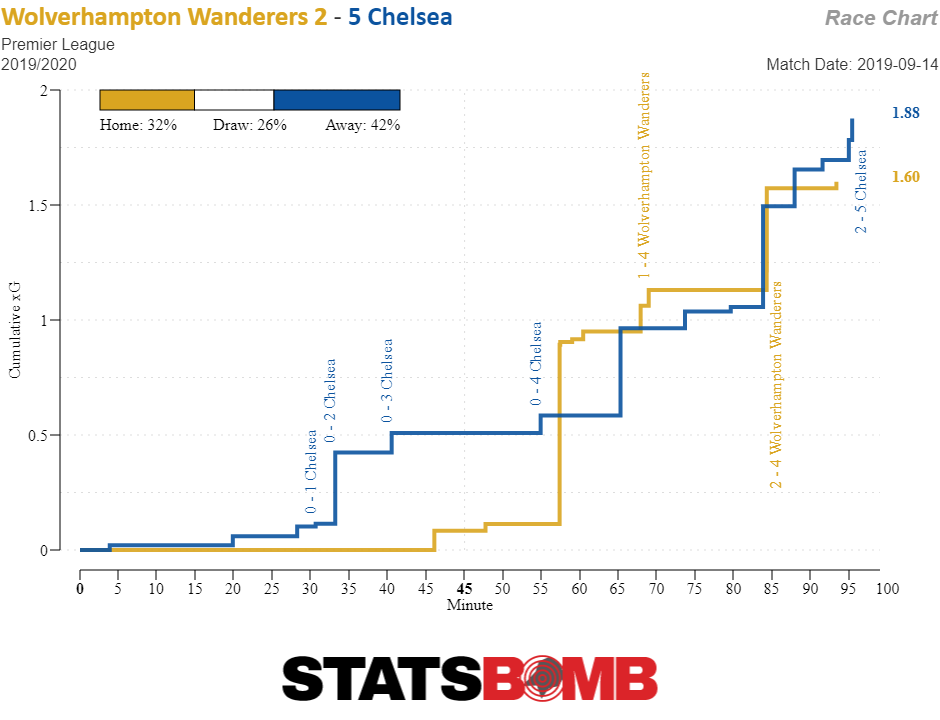 Last season Wolves were a great defensive team. They were one of only four teams to concede fewer than one xG per match (0.91). They were also a decent attacking side. They accumulated 1.19 xG per match, which is nothing to write home about but landed them exactly in the middle of the league. This year they’re just worse on both sides of the ball. This year their defense is average, at 1.09 xG conceded, which trails eight other teams and their attack, well their attack at 0.92 xG per match is simply an utter mess.
Last season Wolves were a great defensive team. They were one of only four teams to concede fewer than one xG per match (0.91). They were also a decent attacking side. They accumulated 1.19 xG per match, which is nothing to write home about but landed them exactly in the middle of the league. This year they’re just worse on both sides of the ball. This year their defense is average, at 1.09 xG conceded, which trails eight other teams and their attack, well their attack at 0.92 xG per match is simply an utter mess. 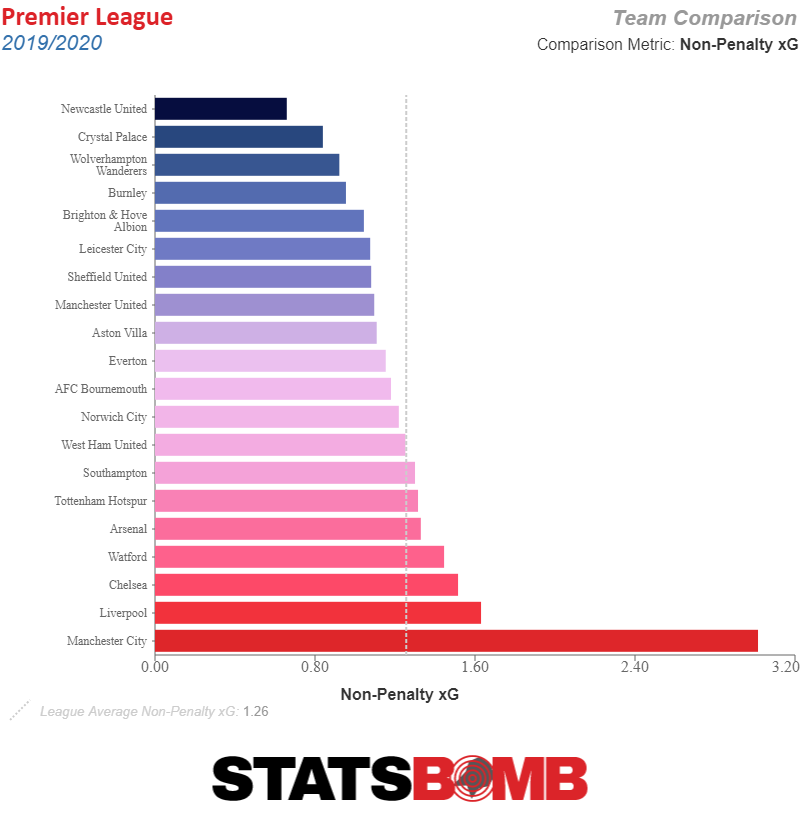 Then there’s a matter of the schedule. They’ve played a relatively difficult set of six games so far, facing Leicester City away, Manchester United at home and Chelsea at home. Though given the sides early season aspirations those were all games they’d be expected to compete in and taking only two points is minorly disappointing. That said, if they’d taken more than two points from Burnley at home, Everton away, and Palace away nobody would have much noticed the struggles against the top teams. If Wolves had taken six points from the easy half of their schedule they’d currently be tied with the six teams sitting in seventh through 12th place. Instead they’re beginning a fledgling fight against relegation. The next month remains pretty easy for Wolves. Before the end of October the side will face fellow relegation battlers Watford at home and Newcastle away, as well as hosting Southampton (currently in 13th place). Just ignore that they fourth match in that stretch of time is against Manchester City. It’s possible that with a handful of strong performances Wolves numbers will improve, and their results will follow (especially if that is combined with their luck turning). Another month of struggling though, and the discussion slips from having a minorly disappointing season to a real relegation battle. There are, as there always are, all sorts of possible reasons for the poor start. There’s the added burden of Europa League, especially on a squad that was fairly short to begin with and didn’t add much depth this summer. Even minor rotation for a team exceptionally used to a fixed starting 11 can be disruptive. Wolves have been starting bit players from last year like Morgan Gibbs-White and giving super sub Adama Traoré starts at wingback. It’s also possible their numbers are being impacted by playing from behind so much. They’ve conceded first in five of their six matches (and the sixth was the 0-0 opening day draw against Leicester). For a team built to defend, the fact that they’ve been forced to chase the game so often might be dragging their numbers down (one might for example imagine a world where they have improved numbers because several of their draws came from late, lucky equalizers rather than what actually happened where they scored late themselves). This again is the kind of factor that generally, although not always, evens itself out as the season progresses. The bottom line for Wolves is that there is no reason to panic. The team’s defense is its calling card, and that defense has been pretty unlucky so far this season. It will likely improve as the season goes on, just by dint of getting out from whatever soccer god cloud is currently raining goals on them nonstop. That should be enough to turn them into a somewhat below average team that’s safe from relegation. After last year, however, that shouldn’t be enough for Wolves. This side was genuinely impressive last season, and they’ve come out of the gate this year looking genuinely average. Whether it’s Europa League or something else, Wolves have taken a step backwards. The fact that it won’t likely cost them relegation doesn’t mean it shouldn’t be disappointing. This was a team on a meteoric trajectory. Without some sharp improvements over the next month, they’re now overwhelmingly likely to be just another midtable side.
Then there’s a matter of the schedule. They’ve played a relatively difficult set of six games so far, facing Leicester City away, Manchester United at home and Chelsea at home. Though given the sides early season aspirations those were all games they’d be expected to compete in and taking only two points is minorly disappointing. That said, if they’d taken more than two points from Burnley at home, Everton away, and Palace away nobody would have much noticed the struggles against the top teams. If Wolves had taken six points from the easy half of their schedule they’d currently be tied with the six teams sitting in seventh through 12th place. Instead they’re beginning a fledgling fight against relegation. The next month remains pretty easy for Wolves. Before the end of October the side will face fellow relegation battlers Watford at home and Newcastle away, as well as hosting Southampton (currently in 13th place). Just ignore that they fourth match in that stretch of time is against Manchester City. It’s possible that with a handful of strong performances Wolves numbers will improve, and their results will follow (especially if that is combined with their luck turning). Another month of struggling though, and the discussion slips from having a minorly disappointing season to a real relegation battle. There are, as there always are, all sorts of possible reasons for the poor start. There’s the added burden of Europa League, especially on a squad that was fairly short to begin with and didn’t add much depth this summer. Even minor rotation for a team exceptionally used to a fixed starting 11 can be disruptive. Wolves have been starting bit players from last year like Morgan Gibbs-White and giving super sub Adama Traoré starts at wingback. It’s also possible their numbers are being impacted by playing from behind so much. They’ve conceded first in five of their six matches (and the sixth was the 0-0 opening day draw against Leicester). For a team built to defend, the fact that they’ve been forced to chase the game so often might be dragging their numbers down (one might for example imagine a world where they have improved numbers because several of their draws came from late, lucky equalizers rather than what actually happened where they scored late themselves). This again is the kind of factor that generally, although not always, evens itself out as the season progresses. The bottom line for Wolves is that there is no reason to panic. The team’s defense is its calling card, and that defense has been pretty unlucky so far this season. It will likely improve as the season goes on, just by dint of getting out from whatever soccer god cloud is currently raining goals on them nonstop. That should be enough to turn them into a somewhat below average team that’s safe from relegation. After last year, however, that shouldn’t be enough for Wolves. This side was genuinely impressive last season, and they’ve come out of the gate this year looking genuinely average. Whether it’s Europa League or something else, Wolves have taken a step backwards. The fact that it won’t likely cost them relegation doesn’t mean it shouldn’t be disappointing. This was a team on a meteoric trajectory. Without some sharp improvements over the next month, they’re now overwhelmingly likely to be just another midtable side.
Watford changed managers too early, or too late
What are Watford doing? The season is only four games old and the team has parted ways with manager Javi Gracia, bringing in Quique Sánchez Flores for his second stint in charge of the club. But, why? And more importantly, why now? Let’s get the most basic of basic things out of the way first. Watford sit bottom of the Premier League table with a single point after four matches. That’s almost assuredly why the move happened now. They’re one of only two teams, along with Wolves, that have yet to record a win this Premier League season. That’s bad! It’s also only four games. Just as importantly, during those four games, the team’s numbers have been fine. Defensively they haven’t been great, with 1.36 expected goals conceded the seventh highest total in the league. You’d hope for some improvement, especially since Brighton, Everton, West Ham and Newcastle aren’t exactly a murderers row of opponents, but it’s not a number that you’d expect to get you relegated. 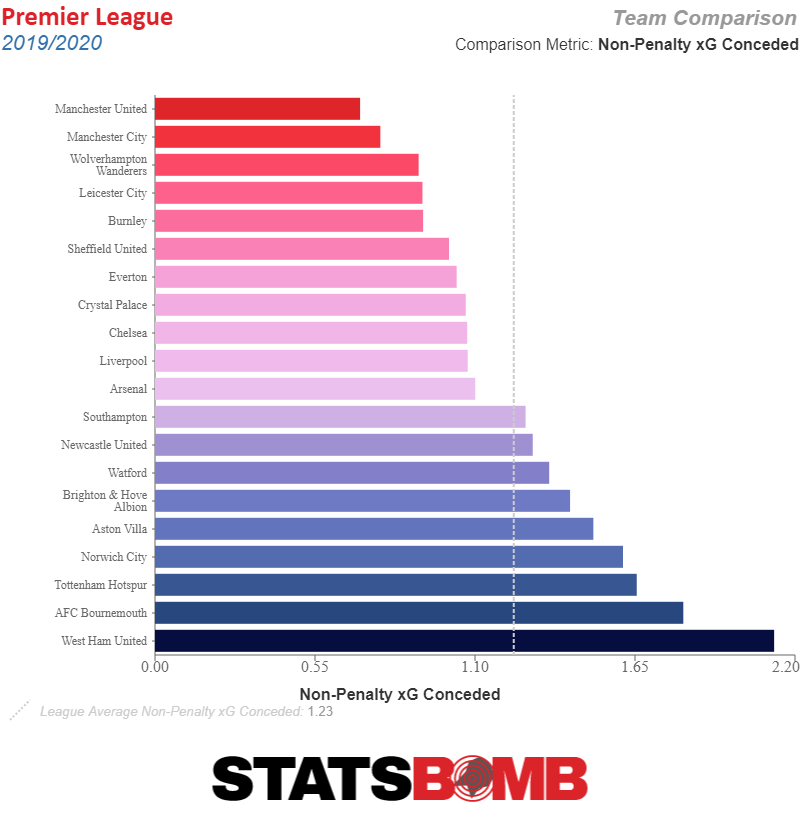 And in attack they’ve actually been quite good. They are actually improbably, the third best Premier League team when it comes to expected goals.
And in attack they’ve actually been quite good. They are actually improbably, the third best Premier League team when it comes to expected goals. 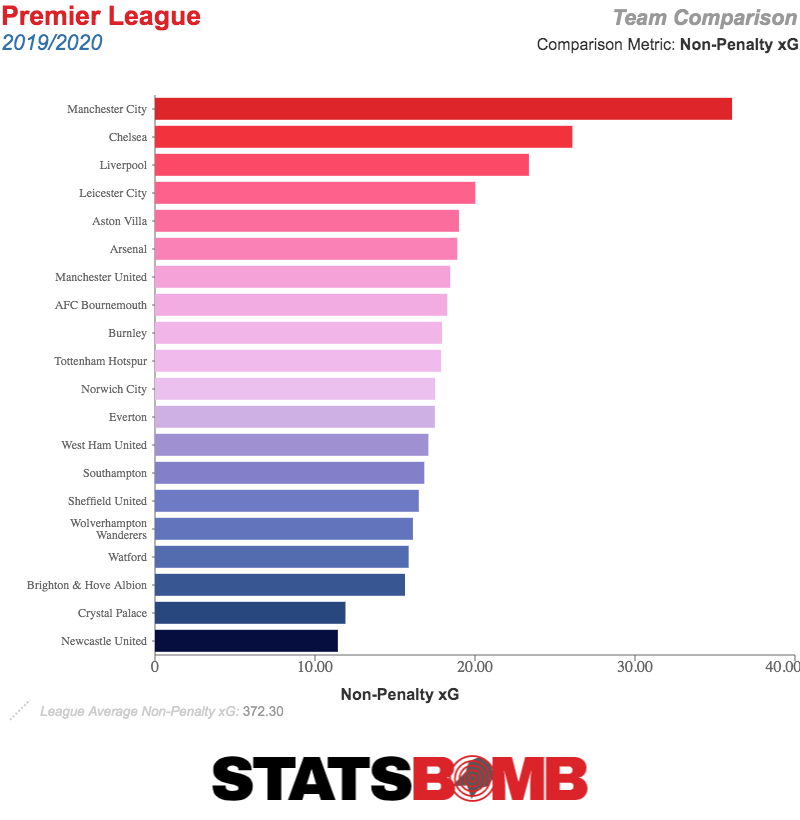 The problem is, well, their actual goals aren’t living up to expectations. Get a job actual goals, stop hanging out on your parent’s couch playing video games all day.
The problem is, well, their actual goals aren’t living up to expectations. Get a job actual goals, stop hanging out on your parent’s couch playing video games all day. 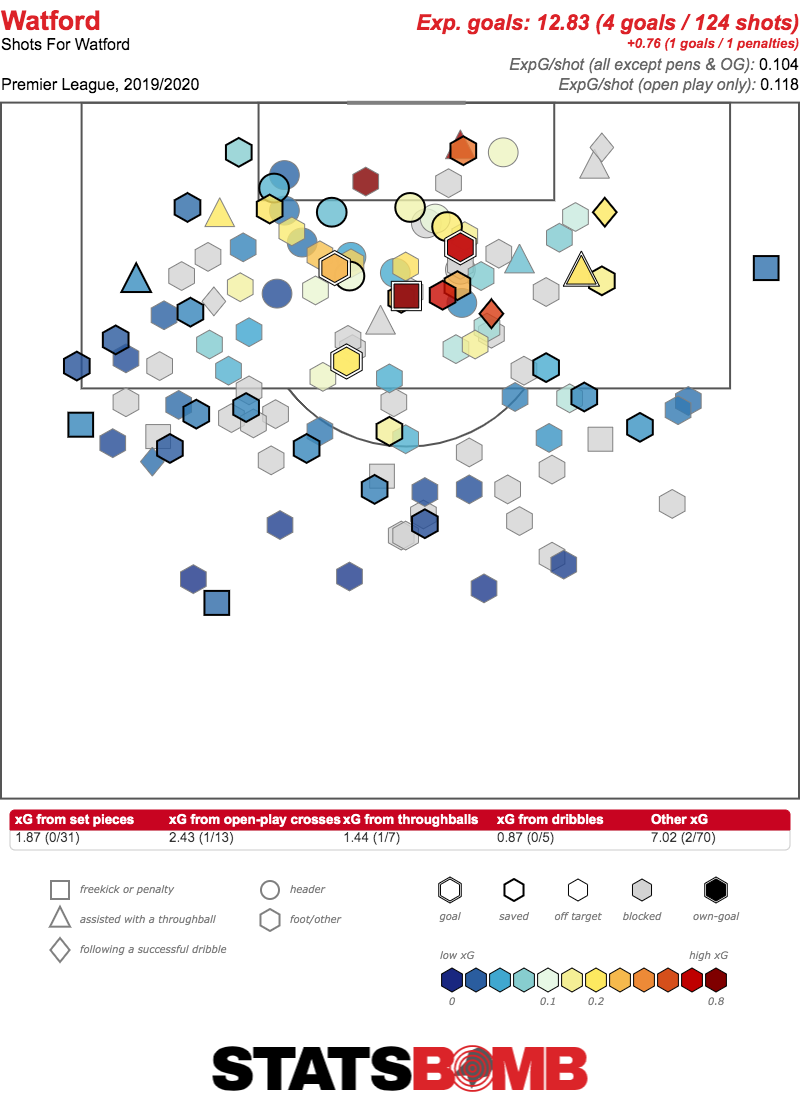 Even more specifically, it’s not like keepers are playing amazingly against them. A quick look at their post-shot expected goals shows that the post-shot value of their shots is significantly lower than the overall value.
Even more specifically, it’s not like keepers are playing amazingly against them. A quick look at their post-shot expected goals shows that the post-shot value of their shots is significantly lower than the overall value. 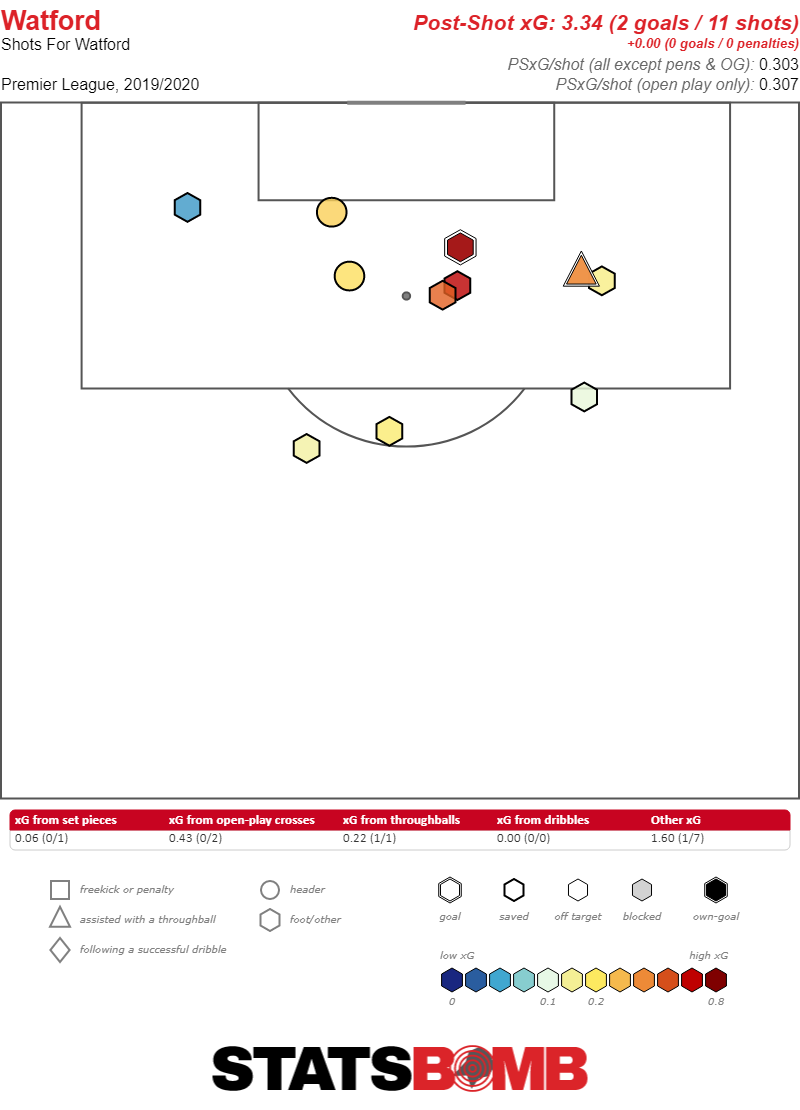 Eventually you really would expect that all those wayward shots that, so far, aren’t finding their way on net, to eventually even themselves out. Four games is only four games after all. On that level, then, this seems like the classic luck driven overreaction. A team lose some winnable games, and despite playing well enough to merit keeping a steady hand, ownership panics and changes the thing that it’s easiest to change. Over the side goes the manager. In a narrow sense that’s true, but in the broader sense there is a slight complication. A look back over Gracia’s time in charge shows a team that after an initial marked improvement defensively, has been trending the wrong direction since the beginning of last season, with an attack that’s not improving quickly enough to match it.
Eventually you really would expect that all those wayward shots that, so far, aren’t finding their way on net, to eventually even themselves out. Four games is only four games after all. On that level, then, this seems like the classic luck driven overreaction. A team lose some winnable games, and despite playing well enough to merit keeping a steady hand, ownership panics and changes the thing that it’s easiest to change. Over the side goes the manager. In a narrow sense that’s true, but in the broader sense there is a slight complication. A look back over Gracia’s time in charge shows a team that after an initial marked improvement defensively, has been trending the wrong direction since the beginning of last season, with an attack that’s not improving quickly enough to match it. 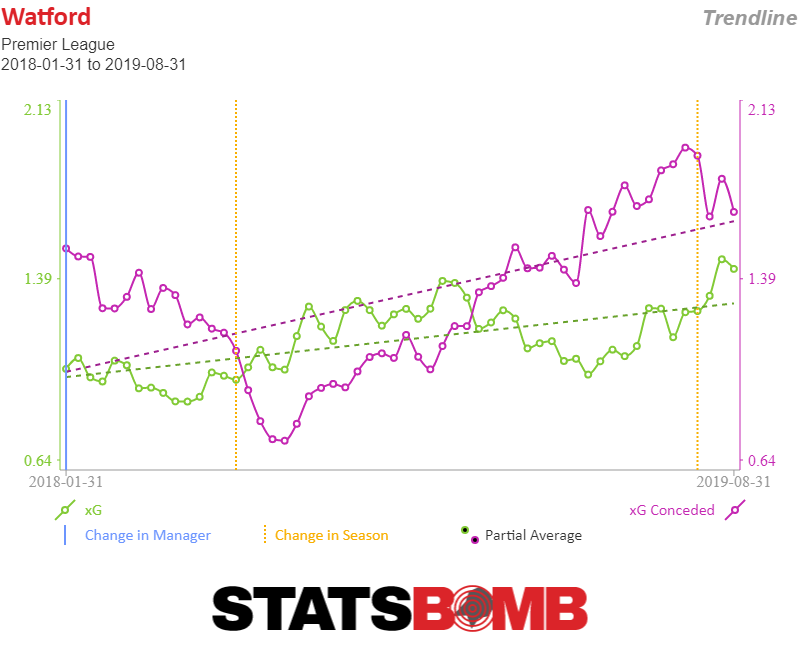 Some coaches simply have short lifespans with a team. It’s not unreasonable to look at the last year’s worth of numbers and decide to move on. Of course, the last year’s worth of numbers were available four games ago too. Over the summer it would have been reasonable to look at the fact that Watford’s performances were trending downwards and make a change. It was equally defensible to look at the most recent season and decide a steady hand was needed. The team did finish 11th, and for most of the season were among a pack of midtable competitors that seemed more likely to move up the table then down. It makes sense to be cautious before changing course after a season like that. The problem is, having made the decision to keep Gracia, firing him after these four games, becomes fairly indefensible. The results so far this season don’t merit it. The only reason they don’t have more points is because some guys missed some shots, a thing which realistically has very little to do with the manager. But they fired him anyway. And changing managers mid-season (even only four games in) is a completely different animal than making an off-season change. If Watford had decided at the end of last year that Gracia wasn’t going to be coming back then they could have conducted a thorough process, looked at multiple candidates, weighed their options and made a considered decision. By waiting four games into the season, Watford forced themselves to act quickly. Now, maybe Quique’s second time around will be as good, or even better, than his first, and maybe if Watford changed managers months ago they’d have hired him anyway, but also, maybe not. There are, of course, always things that the public cannot know. Losing does strange things to a team. Maybe the balance of personalities in Watford’s dressing room were so fragile that four relatively unlucky games was all it took to shatter the team’s cohesion. Maybe Gracia showed signs of disinterest in preseason that hadn’t been present before. There are countless maybes that go into any decision to hire or fire people in positions of management. But, barring something untoward going on beyond the scenes it’s simply hard to see how this move really makes sense. In football, as in so much of life, the problem here is the process more than the end result. If these four games are enough to get Gracia the boot, then it’s almost certain that he should have been shown the door at the end of last season. Having decided to keep him then, it’s unfathomably short sited to now fire him thanks to this season’s results. It’s really not that hard to imagine what an unlucky four game stretch to start a season looks like. If your managers hold on his job is so fragile that that’s all it takes for him to slip over the edge, then it certainly makes more sense to just take the plunge before the season starts. None of this will necessarily prove fatal for Watford. While they’ve squandered a number of points already, they still have a squad that seems more than good enough to fend off relegation. They might have only a single point, but it’s not like they’re out of touch with the rest of the table (and how could they be, because again, four games). They’re one of nine teams with four points or fewer. The table has yet to define itself. On the other hand, the timing of this move is fraught. Watford’s next three matches are home against Arsenal, away to Manchester City and away to Wolves. Then the schedule lets up a little bit as they host Watford and Bournemouth in-between matches with Spurs and Chelsea. It’s not really until November when they play a run of easier matches with Norwich, Burnley, Southamption, Leicester, and Crystal Palace all in a row. Welcome back Quique! As the vast sea of midtable teams ebb and flow, it’s the accumulation of little decisions that build the bedrock for sustained success. Who gets to take a shot at cracking the top six if everything goes right, and who is one injury away from an unlikely relegation battle if it doesn’t is determined by the foundations that management lay. Firing Gracia now chips away at that bedrock of good decision making. Either he was enough of a problem to fire last summer, or he was good enough to survive the current stretch. Landing firmly in the middle is, barring extreme circumstances, self-sabotage. The fact that Watford might limp forward and survive doesn’t lesson that fact. Watford made a bad decision here. They had two reasonable options and they chose the third, a panic firing with no real basis in performance. That’s the basic blue print for how to turn a midtable team into one fighting a relegation battle.
Some coaches simply have short lifespans with a team. It’s not unreasonable to look at the last year’s worth of numbers and decide to move on. Of course, the last year’s worth of numbers were available four games ago too. Over the summer it would have been reasonable to look at the fact that Watford’s performances were trending downwards and make a change. It was equally defensible to look at the most recent season and decide a steady hand was needed. The team did finish 11th, and for most of the season were among a pack of midtable competitors that seemed more likely to move up the table then down. It makes sense to be cautious before changing course after a season like that. The problem is, having made the decision to keep Gracia, firing him after these four games, becomes fairly indefensible. The results so far this season don’t merit it. The only reason they don’t have more points is because some guys missed some shots, a thing which realistically has very little to do with the manager. But they fired him anyway. And changing managers mid-season (even only four games in) is a completely different animal than making an off-season change. If Watford had decided at the end of last year that Gracia wasn’t going to be coming back then they could have conducted a thorough process, looked at multiple candidates, weighed their options and made a considered decision. By waiting four games into the season, Watford forced themselves to act quickly. Now, maybe Quique’s second time around will be as good, or even better, than his first, and maybe if Watford changed managers months ago they’d have hired him anyway, but also, maybe not. There are, of course, always things that the public cannot know. Losing does strange things to a team. Maybe the balance of personalities in Watford’s dressing room were so fragile that four relatively unlucky games was all it took to shatter the team’s cohesion. Maybe Gracia showed signs of disinterest in preseason that hadn’t been present before. There are countless maybes that go into any decision to hire or fire people in positions of management. But, barring something untoward going on beyond the scenes it’s simply hard to see how this move really makes sense. In football, as in so much of life, the problem here is the process more than the end result. If these four games are enough to get Gracia the boot, then it’s almost certain that he should have been shown the door at the end of last season. Having decided to keep him then, it’s unfathomably short sited to now fire him thanks to this season’s results. It’s really not that hard to imagine what an unlucky four game stretch to start a season looks like. If your managers hold on his job is so fragile that that’s all it takes for him to slip over the edge, then it certainly makes more sense to just take the plunge before the season starts. None of this will necessarily prove fatal for Watford. While they’ve squandered a number of points already, they still have a squad that seems more than good enough to fend off relegation. They might have only a single point, but it’s not like they’re out of touch with the rest of the table (and how could they be, because again, four games). They’re one of nine teams with four points or fewer. The table has yet to define itself. On the other hand, the timing of this move is fraught. Watford’s next three matches are home against Arsenal, away to Manchester City and away to Wolves. Then the schedule lets up a little bit as they host Watford and Bournemouth in-between matches with Spurs and Chelsea. It’s not really until November when they play a run of easier matches with Norwich, Burnley, Southamption, Leicester, and Crystal Palace all in a row. Welcome back Quique! As the vast sea of midtable teams ebb and flow, it’s the accumulation of little decisions that build the bedrock for sustained success. Who gets to take a shot at cracking the top six if everything goes right, and who is one injury away from an unlikely relegation battle if it doesn’t is determined by the foundations that management lay. Firing Gracia now chips away at that bedrock of good decision making. Either he was enough of a problem to fire last summer, or he was good enough to survive the current stretch. Landing firmly in the middle is, barring extreme circumstances, self-sabotage. The fact that Watford might limp forward and survive doesn’t lesson that fact. Watford made a bad decision here. They had two reasonable options and they chose the third, a panic firing with no real basis in performance. That’s the basic blue print for how to turn a midtable team into one fighting a relegation battle.
Is Chelsea's César Azpilicueta bad now?
Who exactly is to blame for Chelsea’s defensive woes? Over the last three years Chelsea have undergone a stunning tactical shift. A side that started out as a possession shy defensive juggernaut under Antonio Conte morphed into a wide open possession machine under Maurizio Sarri, and is now, in theory, a press heavy quick hitting operation. As tactics change, so do expectations. Players are asked to different things. Some systems will suit some players better, some will be forced to perform tasks they’re less prepared for. Their successes and failures can become more (or less) obvious to the naked eye. That brings us to César Azpilicueta. Azpilicueta is a long time Chelsea defensive stalwart. Although he was acquired as a right back, he truly turned into a star playing on the left during Jose Mourinho’s second stint at the club, and then as a right sided center back in Conte’s back three system. By the time he returned to right back under Sarri Azpilicueta hadn’t played regularly in his “natural” position for five seasons. The challenge in assessing Azpilicueta is that while he has been ever present for Chelsea, Chelsea have changed so much that separating out possible decline in the 30-year-old from a shifting system is hard. The shift from Conte to Sarri emphasizes just how drastically tactics can change. In each of those years Chelsea conceded 0.88 expected goals and between nine and ten shots per math. But, under Conte they played 577 passes per match and allowed 469, while under Sarri they played 695 and conceded 412. So opponents had the ball significantly less, but turned that possession into the exact same number of expected goals. This isn’t shocking. The primary defensive weapon Sarri deployed was always having the ball. The team was extremely vulnerable when they didn’t have, it’s just those times were relatively few and far between. Conte on the other hand made sure his team was not vulnerable out of possession, but would more readily concede possession to do so. This season, through four games, Chelsea really are worse defensively, not just different. They’re conceding 1.07 xG per match, despite conceding a similar number of shots. They’ve also played 592 passes and conceded 472. They aren’t quite the possession machine that they were under Sarri, but they’re not far off. The problem is that not only are they conceding shots quickly when they lose it, but they’re conceding really good shots (even if more of them have gone in than you might predict). 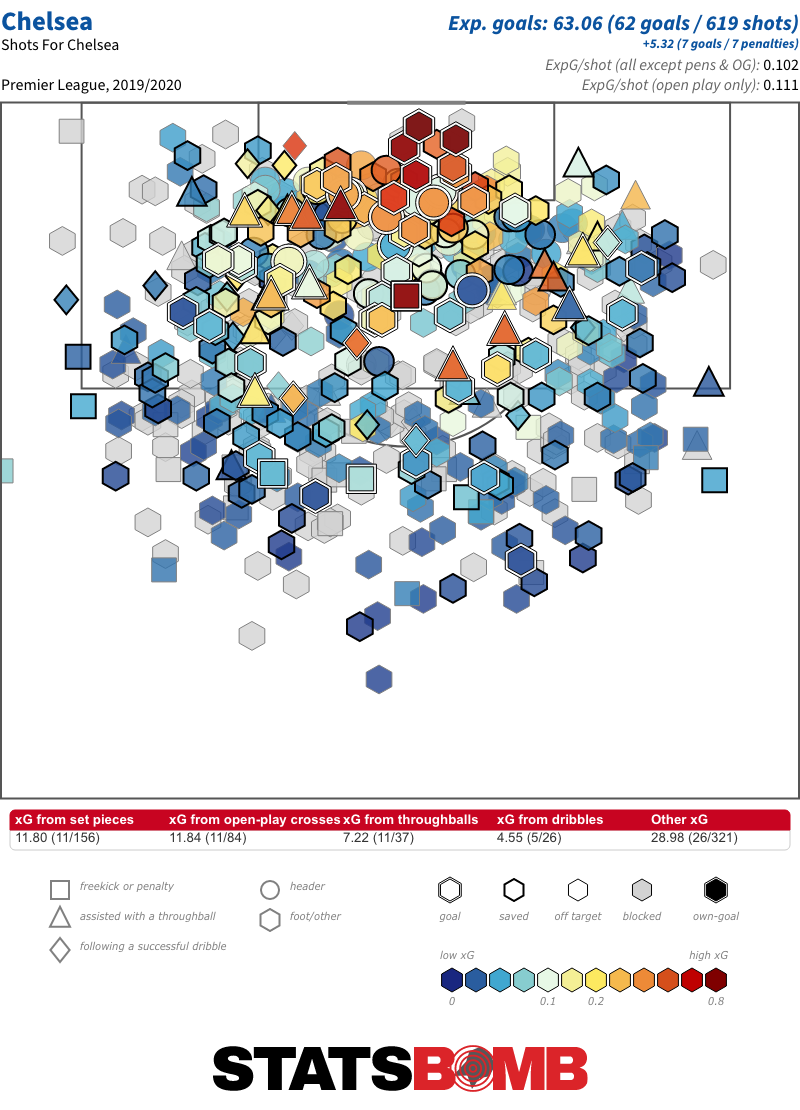 Give that, it’s at least fair to wonder if Azpilicueta is declining. The team’s possession stats haven’t change a tremendous amount, nor have the number of shots they’re conceding, it’s just that the quality of chances are increasing. A simple explanation would be the team’s reliable defender getting old and less reliable. The data, however, hints at a more complicated story. Let’s start with old reliable, the radar, and compare last season and this season.
Give that, it’s at least fair to wonder if Azpilicueta is declining. The team’s possession stats haven’t change a tremendous amount, nor have the number of shots they’re conceding, it’s just that the quality of chances are increasing. A simple explanation would be the team’s reliable defender getting old and less reliable. The data, however, hints at a more complicated story. Let’s start with old reliable, the radar, and compare last season and this season. 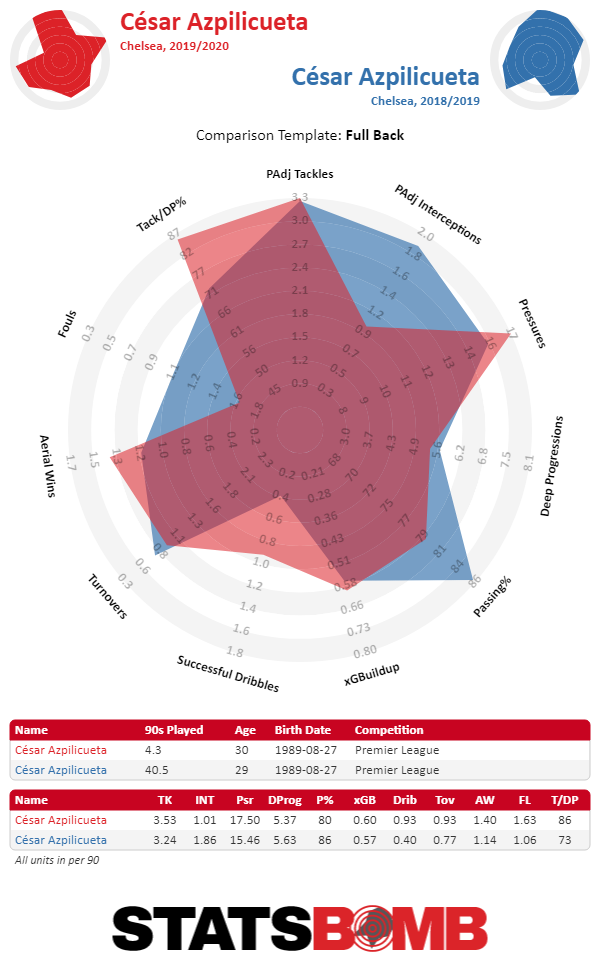 The radars are different, but this year’s version sure doesn’t seem bad. There are a couple of particularly notable trends, however. First, he’s doing a lot less intercepting of the ball, dropping from 1.86 per 90 minutes to 1.01. Second, he’s not only doing more tackling, but, on a percentage basis he’s doing it more efficiently than last season, with his possession adjusted tackles per 90 ticking upwards to 3.53 from 3.24 and his tackles per dribbled past % going from 73% to 86%. So, he’s getting dribbled past less of the time he tries to tackle this season, despite the fact that he’s actually doing more tackling. Then there’s the fact that Azpilicueta’s defensive actions have actually come higher up the field this season than last. He’s frequently stepping into the opposition half to pressure the opposition and try and break up play.
The radars are different, but this year’s version sure doesn’t seem bad. There are a couple of particularly notable trends, however. First, he’s doing a lot less intercepting of the ball, dropping from 1.86 per 90 minutes to 1.01. Second, he’s not only doing more tackling, but, on a percentage basis he’s doing it more efficiently than last season, with his possession adjusted tackles per 90 ticking upwards to 3.53 from 3.24 and his tackles per dribbled past % going from 73% to 86%. So, he’s getting dribbled past less of the time he tries to tackle this season, despite the fact that he’s actually doing more tackling. Then there’s the fact that Azpilicueta’s defensive actions have actually come higher up the field this season than last. He’s frequently stepping into the opposition half to pressure the opposition and try and break up play. 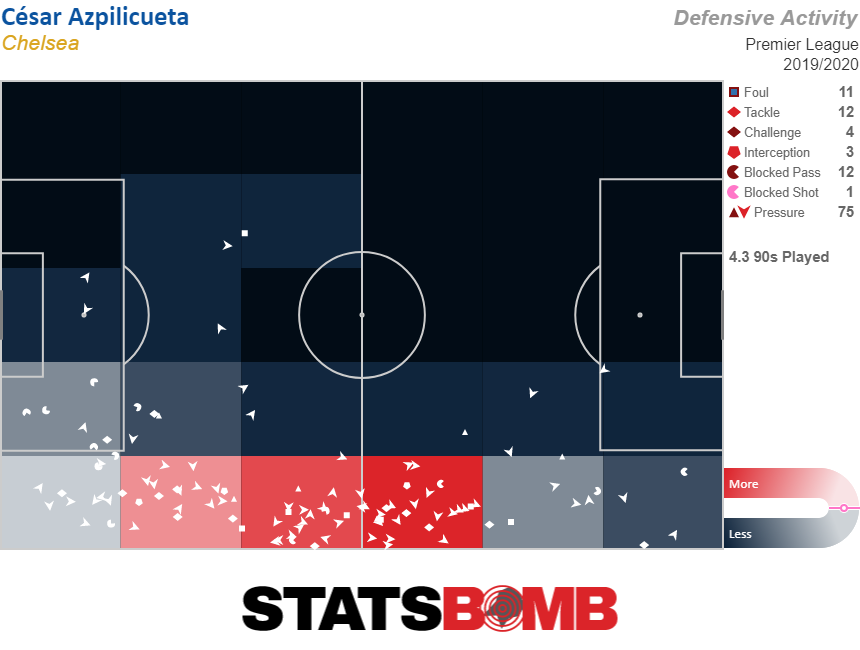 Last season, he was able to stay somewhat more in reserve and intervene primarily in his own defensive half.
Last season, he was able to stay somewhat more in reserve and intervene primarily in his own defensive half. 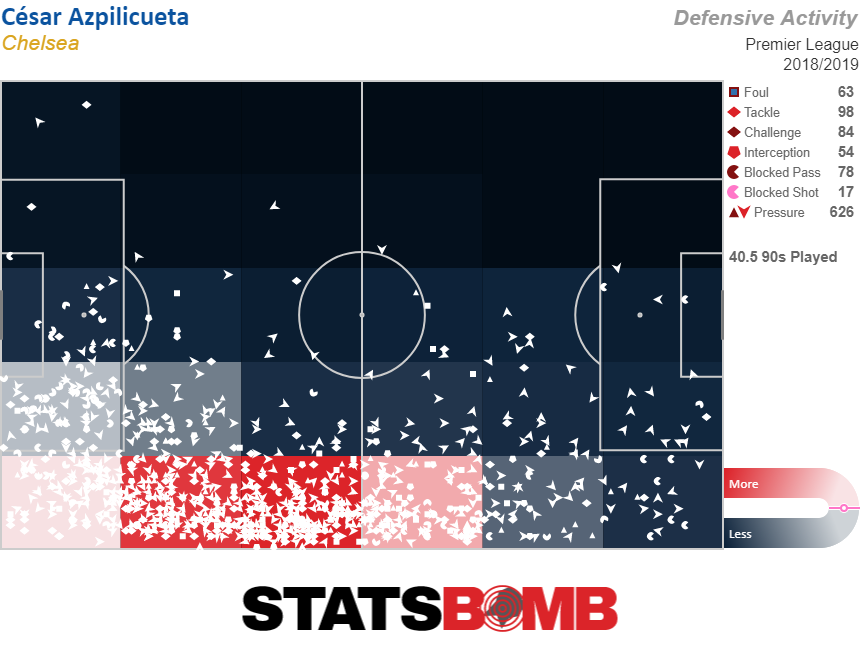 And finally, we can look at what opponents do with the ball when attacking Chelsea. Here are all the times that Chelsea’s opponent have moved the ball into the penalty box from open play, either by passing the ball in, or carrying it.
And finally, we can look at what opponents do with the ball when attacking Chelsea. Here are all the times that Chelsea’s opponent have moved the ball into the penalty box from open play, either by passing the ball in, or carrying it. 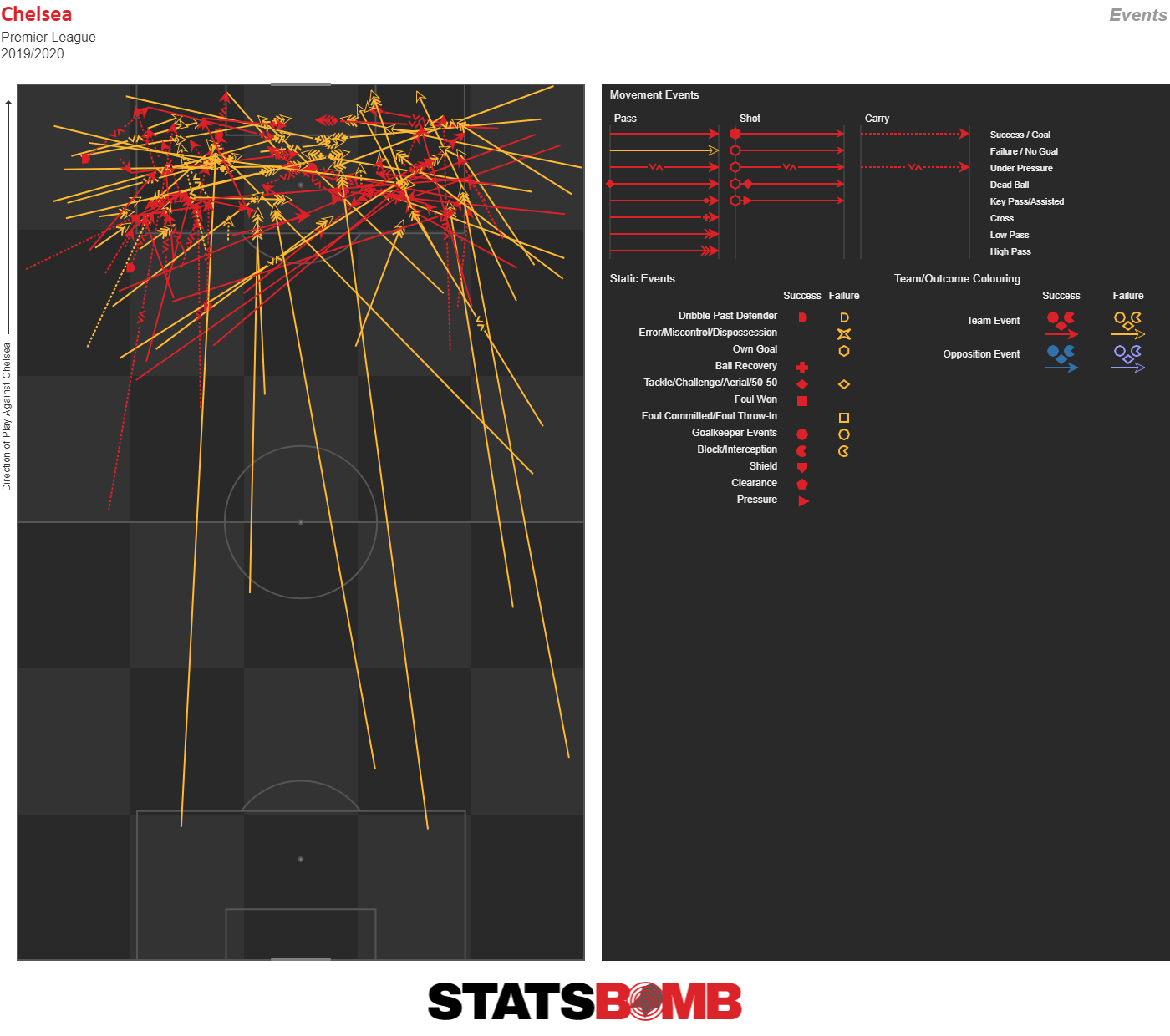 Azpilicueta’s side of the penalty area does not seem to be more under siege than his counterpart on the left. However, if we drill down a little bit, something interesting appears. If we look only at successful plays that are unpressured, here’s what we find.
Azpilicueta’s side of the penalty area does not seem to be more under siege than his counterpart on the left. However, if we drill down a little bit, something interesting appears. If we look only at successful plays that are unpressured, here’s what we find. 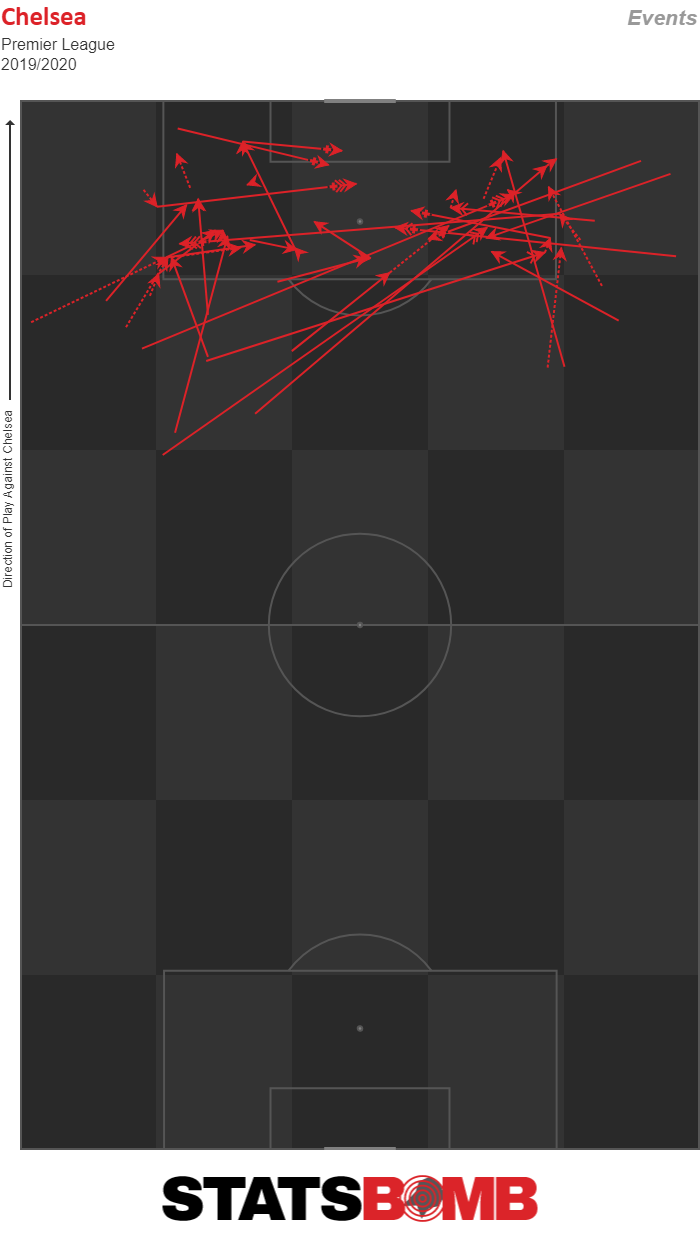 There are a number of instances where Chelsea have allowed a successful, unpressured pass from their right defensive inside channel to the left side of the box. That left defensive side of the box has been targeted from the left wing as well. In fact, the left side of the box seems to be under assault from unpressured actions significantly more than the right side is. If we look at successful pressured actions, however, we see Azpilicueta’s side light up.
There are a number of instances where Chelsea have allowed a successful, unpressured pass from their right defensive inside channel to the left side of the box. That left defensive side of the box has been targeted from the left wing as well. In fact, the left side of the box seems to be under assault from unpressured actions significantly more than the right side is. If we look at successful pressured actions, however, we see Azpilicueta’s side light up. 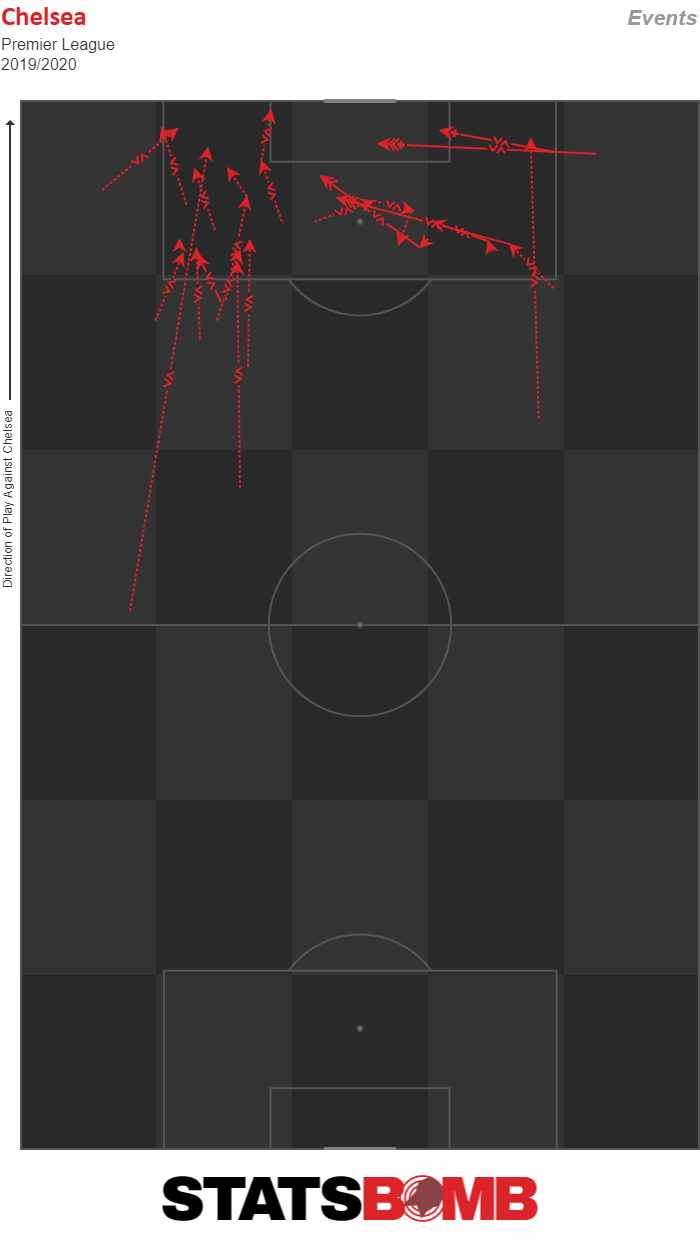 Putting all those pieces together into a coherent story is tricky. One thing that seems clear is that Azpilicueta is being tasked with an incredibly difficult job. The combination of strong tackling numbers with the dip in interceptions and more aggressive positioning suggests that he’s frequently being left on an island and forced to deal with attackers running at him in space. While he’s largely successful at holding down that flank, he’s not perfect. He’s largely able to harry attackers and pressure opponents as they attempt to get to the byline, but has been vulnerable when players cut back to the inside and play crosses across the box (like the one that led to Kurt Zouma’s game tying own goal against Sheffield United). On one level, those kinds of outcomes tend to be what happens when a player makes the best of a bad situation. Azpilicueta’s slowing down attacks and forcing wingers to turn back inside and either face defensive help from his teammates, or play lower probability balls than they would be if they wiggled free. But, it’s also fair to ask, with the higher positioning seemingly required of him this season, would a more athletic player (somebody like 19-year-old already in the team of the season in the Championship last year for Wigan Reece James) be effectively preventing these situations to begin with by preventing the passes out to the wing in the first place? Finally, there’s the question of the rest of the Chelsea defense. It’s a lot less dangerous to force a player to check back inside if he’s running into N'Golo Kanté than it is if it’s only Jorginho waiting on him. Then there’s Kurt Zouma as the left sided central defender who teams appear to be picking on relentlessly. It’s possible that if Antonio Rüdiger returns from injury and takes his place (either directly or by coming in on the right and allowing another defender to slide over), those crossfield balls will start seeming less dangerous. Ultimate it’s easy to see the things Azpilicueta has struggled to do this season. He’s been isolated defensively, and teams have been attacking quickly and directly down the flank to take advantage. Azpiicueta has, in those circumstances reliably made the best of bad situations, but sometimes that hasn’t been good enough, and it’s fair to ask if a younger version of the Spanish defender might have had the range to prevent those situations from developing to begin with. But, it’s also fair to ask whether Azpilicueta is being let down by his teammates and whether all those moments when he forces players to check inside, or slows them down without stopping them should result in his teammates picking up the slack more than they are. That’s good news for Chelsea. It means that as some of their better defenders come back, Azpilicueta will likely appear to be improving. It’s also good news for Azpilicueta, because it means that at 30, he’s not nearly as vulnerable as he seems at times. If he’s not good enough for the role he’s being asked to play at times, it’s because that role is incredibly difficult. Better defensive players around him will ease that burden. Those players will make the job of playing right back for Chelsea easier, rather than requiring that the team go out and find a better to play right back. Header image courtesy of the Press Association
Putting all those pieces together into a coherent story is tricky. One thing that seems clear is that Azpilicueta is being tasked with an incredibly difficult job. The combination of strong tackling numbers with the dip in interceptions and more aggressive positioning suggests that he’s frequently being left on an island and forced to deal with attackers running at him in space. While he’s largely successful at holding down that flank, he’s not perfect. He’s largely able to harry attackers and pressure opponents as they attempt to get to the byline, but has been vulnerable when players cut back to the inside and play crosses across the box (like the one that led to Kurt Zouma’s game tying own goal against Sheffield United). On one level, those kinds of outcomes tend to be what happens when a player makes the best of a bad situation. Azpilicueta’s slowing down attacks and forcing wingers to turn back inside and either face defensive help from his teammates, or play lower probability balls than they would be if they wiggled free. But, it’s also fair to ask, with the higher positioning seemingly required of him this season, would a more athletic player (somebody like 19-year-old already in the team of the season in the Championship last year for Wigan Reece James) be effectively preventing these situations to begin with by preventing the passes out to the wing in the first place? Finally, there’s the question of the rest of the Chelsea defense. It’s a lot less dangerous to force a player to check back inside if he’s running into N'Golo Kanté than it is if it’s only Jorginho waiting on him. Then there’s Kurt Zouma as the left sided central defender who teams appear to be picking on relentlessly. It’s possible that if Antonio Rüdiger returns from injury and takes his place (either directly or by coming in on the right and allowing another defender to slide over), those crossfield balls will start seeming less dangerous. Ultimate it’s easy to see the things Azpilicueta has struggled to do this season. He’s been isolated defensively, and teams have been attacking quickly and directly down the flank to take advantage. Azpiicueta has, in those circumstances reliably made the best of bad situations, but sometimes that hasn’t been good enough, and it’s fair to ask if a younger version of the Spanish defender might have had the range to prevent those situations from developing to begin with. But, it’s also fair to ask whether Azpilicueta is being let down by his teammates and whether all those moments when he forces players to check inside, or slows them down without stopping them should result in his teammates picking up the slack more than they are. That’s good news for Chelsea. It means that as some of their better defenders come back, Azpilicueta will likely appear to be improving. It’s also good news for Azpilicueta, because it means that at 30, he’s not nearly as vulnerable as he seems at times. If he’s not good enough for the role he’s being asked to play at times, it’s because that role is incredibly difficult. Better defensive players around him will ease that burden. Those players will make the job of playing right back for Chelsea easier, rather than requiring that the team go out and find a better to play right back. Header image courtesy of the Press Association
Crystal Palace: 2019-20 Season Preview
Crystal Palace have a good news, bad news situation going on. The good news is that they’ve been pretty good, probably even better than their point totals the last couple of seasons suggest. That bad news is that they’re likely to get worse, maybe quickly. First, the positives. In his almost two full seasons, Roy Hodgson has this team playing pretty well. Two seasons ago he took over with them sitting bottom (although with considerably evidence they were a better team than their record), navigated them to midtable, survived an injury crisis and installed a slightly unorthodox system involving an extremely narrow midfield four with two converted wingers, Wilfried Zaha and Andros Townsend as forwards. He followed that up with a fairly unremarkable season, one which again saw Palace put up decent numbers despite Christian Benteke struggling at forward, relying on Michy Batshuayi to come in on loan and provide just enough goals for the team to coast comfortably home. On the whole, the teams numbers aren’t going to get anybody dreaming of greatness, but they sure should keep a side safe from any real risk of relegation. The bottom line is that despite a defensive blip towards the end of last season, things have been generally moving in the right direction. 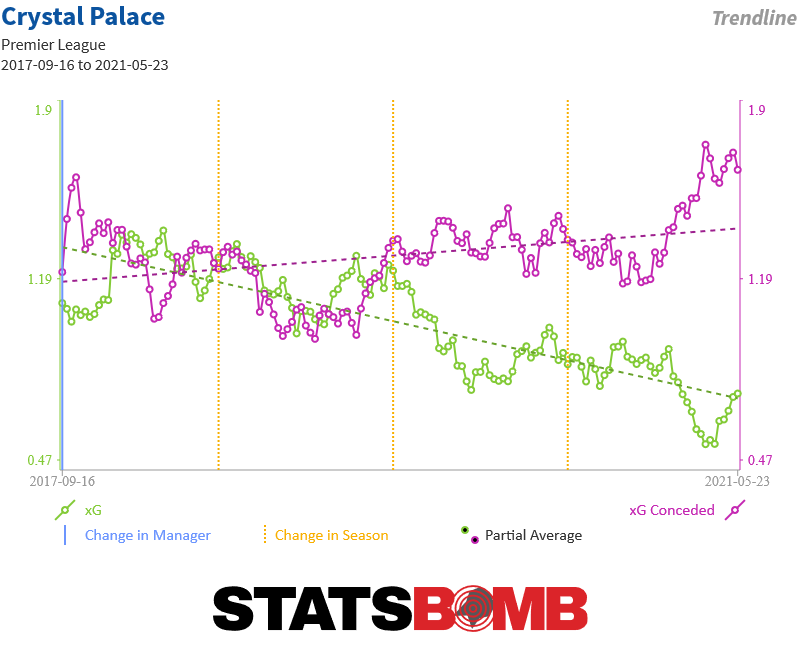 The bad news is that this team is old. Very old. The young star they managed to hold onto, Zaha, is going to be 27. Their sole actual young talent, Aaron Wan-Bissaka is now Manchester United’s right back of the future. The list of even plausibly young talented players in the squad consists of Max Meyer. Tat’s it. And their incoming transfers are James McCarthy, and Gary Cahill, which is the opposite of young talent. Even if the squad is fine right now, it won’t be in a year or two.
The bad news is that this team is old. Very old. The young star they managed to hold onto, Zaha, is going to be 27. Their sole actual young talent, Aaron Wan-Bissaka is now Manchester United’s right back of the future. The list of even plausibly young talented players in the squad consists of Max Meyer. Tat’s it. And their incoming transfers are James McCarthy, and Gary Cahill, which is the opposite of young talent. Even if the squad is fine right now, it won’t be in a year or two. 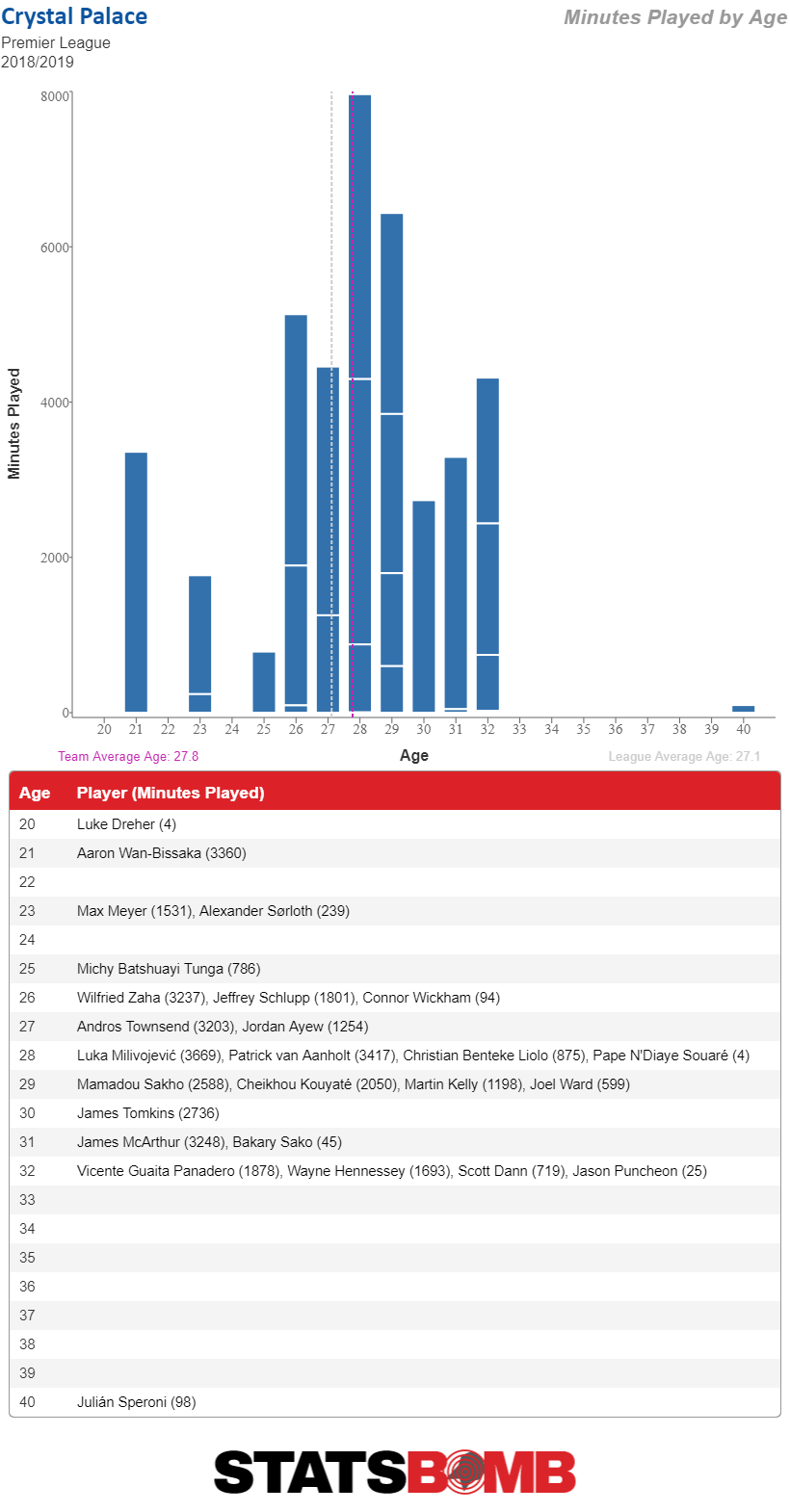 Crystal Palace are in desperate need of a rebuild, the kind which involves spending money on young players who might develop into the pillars of a Premier League team for years to come. Unfortunately, that money doesn’t seem to be forthcoming. Spending now, on players who can keep the team competitive would surely be less expensive than flailing around throwing money at whatever players happen to be available if and when a relegation fight does occur. With Zaha staying, there should be enough talent hanging around Selhurst Park to ensure that Palace survive another season, but it’s not a slam dunk. Zaha is asked to do an awful lot of attacking work. He needs to both move the ball up the field, create shots for himself, and set up teammates. He’s extremely adept at dropping deeper, and carrying the ball into the final third.
Crystal Palace are in desperate need of a rebuild, the kind which involves spending money on young players who might develop into the pillars of a Premier League team for years to come. Unfortunately, that money doesn’t seem to be forthcoming. Spending now, on players who can keep the team competitive would surely be less expensive than flailing around throwing money at whatever players happen to be available if and when a relegation fight does occur. With Zaha staying, there should be enough talent hanging around Selhurst Park to ensure that Palace survive another season, but it’s not a slam dunk. Zaha is asked to do an awful lot of attacking work. He needs to both move the ball up the field, create shots for himself, and set up teammates. He’s extremely adept at dropping deeper, and carrying the ball into the final third. 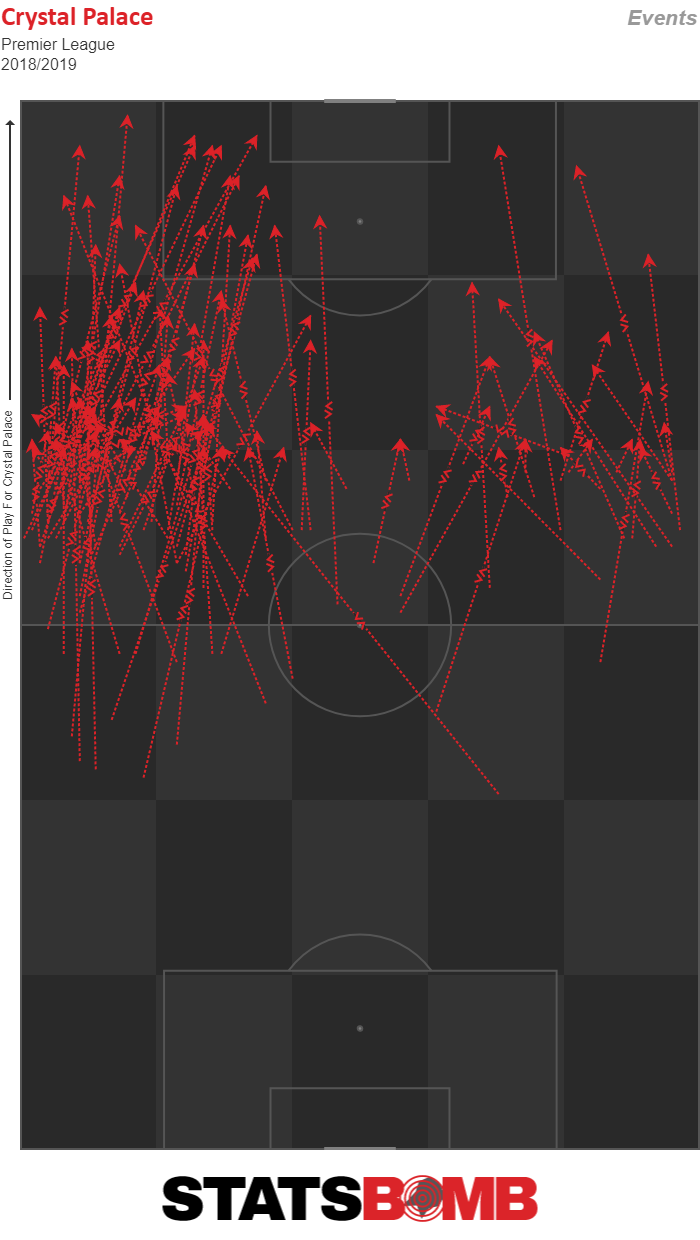 He’s also totally able to either bring the ball into the box himself.
He’s also totally able to either bring the ball into the box himself. 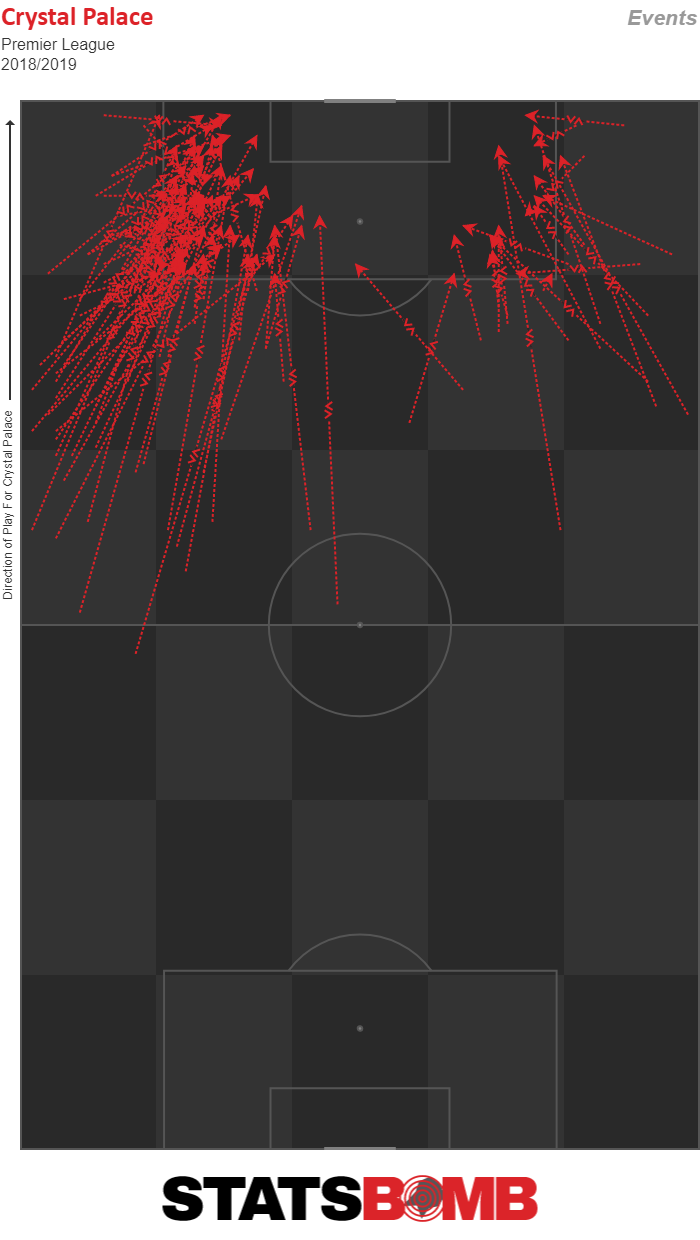 Or feed it to a teammate (yellow passes indicate an incomplete pass)
Or feed it to a teammate (yellow passes indicate an incomplete pass) 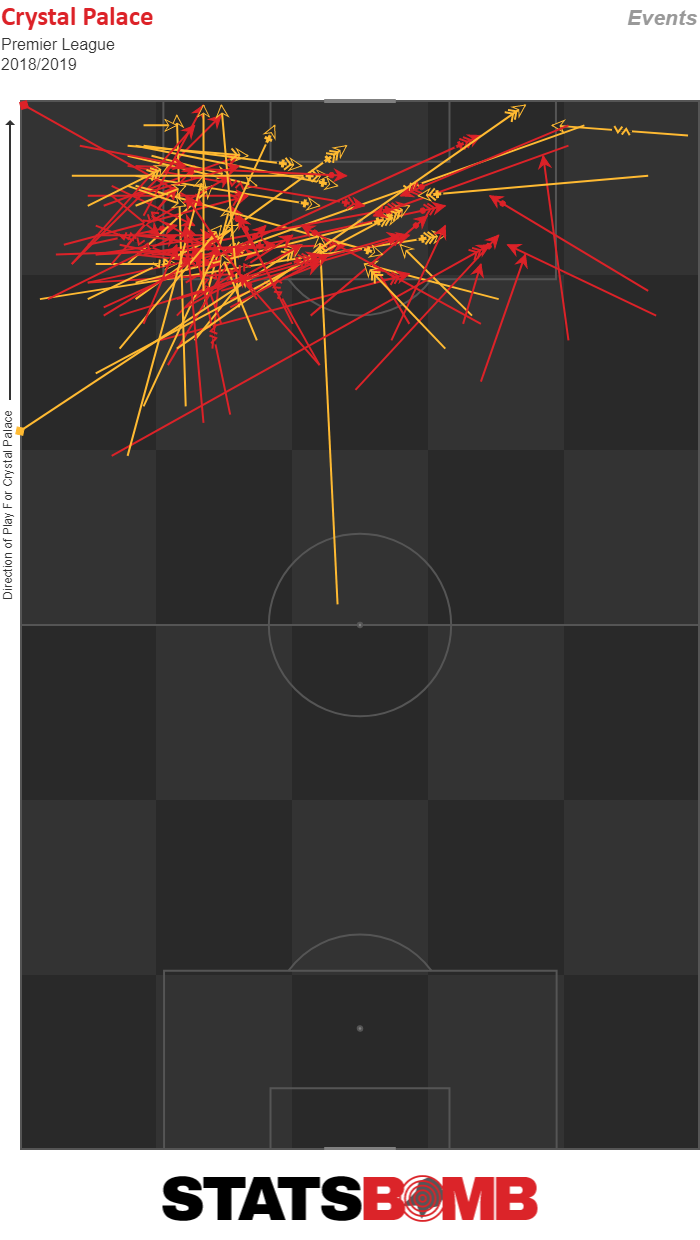 Zaha’s game, however, is so tailored to attacking the box from the side, that it makes his shot chart…challenging. Ten goals are great, but when you’re shooting almost exclusively from these angles, that return is unlikely to continue.
Zaha’s game, however, is so tailored to attacking the box from the side, that it makes his shot chart…challenging. Ten goals are great, but when you’re shooting almost exclusively from these angles, that return is unlikely to continue. 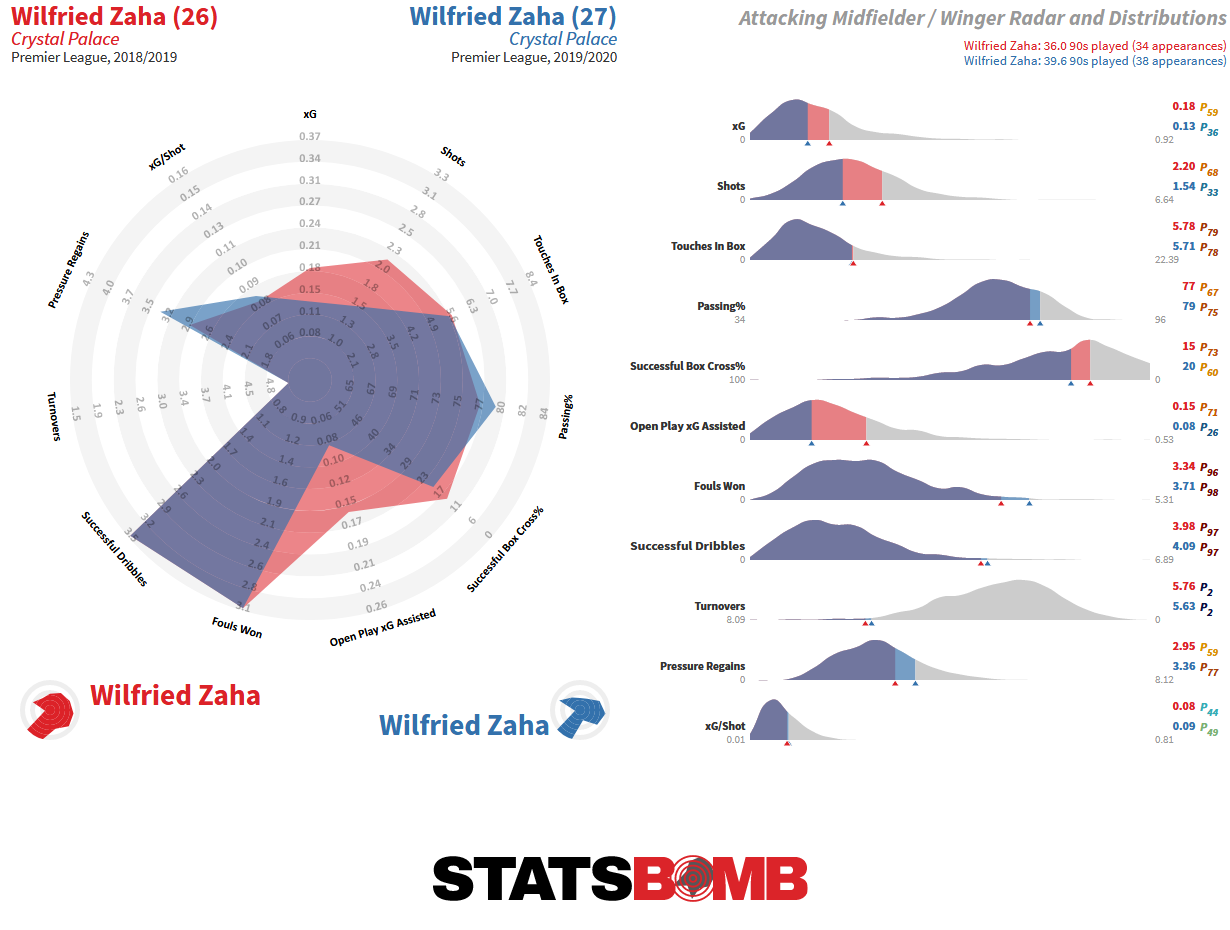 And that’s a problem for Palace because they need Zaha’s goals. Christian Benteke is the sides only proven striker. And he’s spent the last two years working extremely hard to un-prove himself. He’s 28 with a significant injury history, and he’s been in and out of the lineup over the last two seasons both because he can’t stay healthy and because his form has been, let’s call it imprecise. Over the last two years Benteke has been king of the can’t shoot straight club. His underlying numbers are fine, good even. His expected goals from over the last two seasons in somewhat limited minutes total to just over 11. He’s actually found the back of the net three times. Last season his shot chart looked like this.
And that’s a problem for Palace because they need Zaha’s goals. Christian Benteke is the sides only proven striker. And he’s spent the last two years working extremely hard to un-prove himself. He’s 28 with a significant injury history, and he’s been in and out of the lineup over the last two seasons both because he can’t stay healthy and because his form has been, let’s call it imprecise. Over the last two years Benteke has been king of the can’t shoot straight club. His underlying numbers are fine, good even. His expected goals from over the last two seasons in somewhat limited minutes total to just over 11. He’s actually found the back of the net three times. Last season his shot chart looked like this. 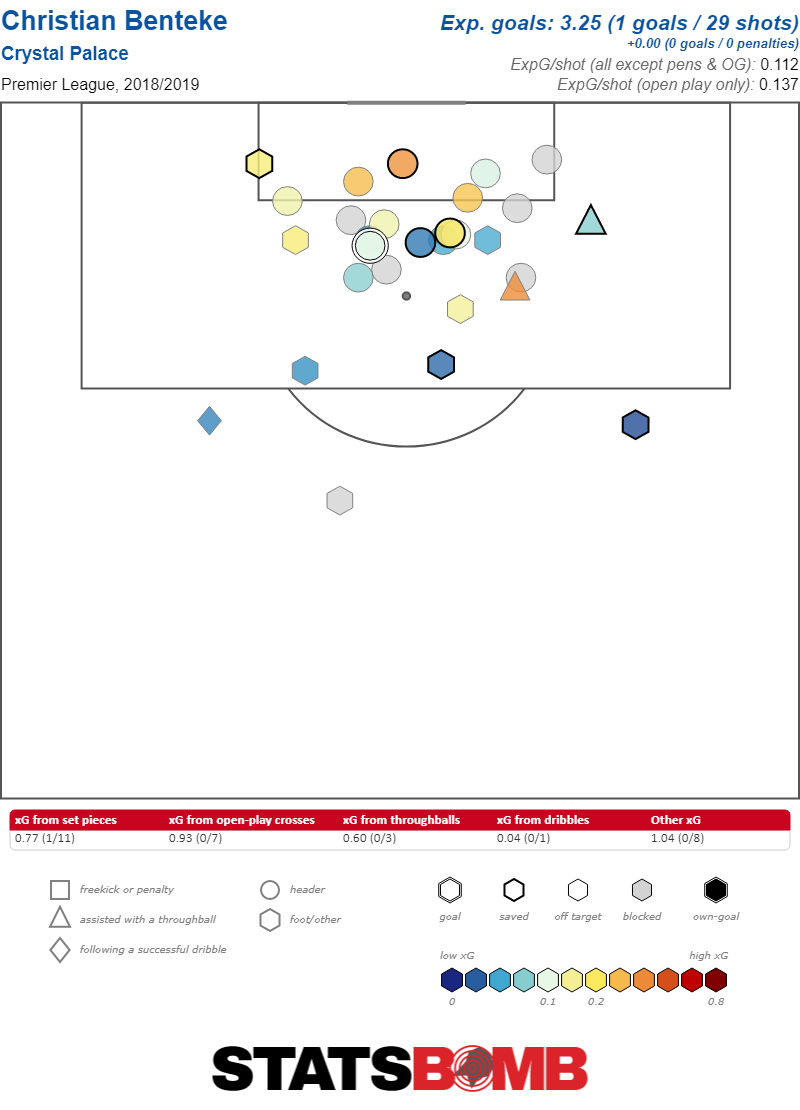 Now, due to limited playing time, he’s only taken a total of 85 shots over the two years combined. It’s certainly possible that Benteke is just in a shooting slump, and continued minutes should see the pendulum swing back towards normal. On the other hand, maybe he’s just cooked. Each of the last two seasons Hodgson has turned away from Benteke and looked for other solutions, this year he won’t have much choice but to hope that the big man finally finds his form again. The Benteke issue is just emblematic of the larger structural problem with Palace. There’s not a whole lot of upside to be found, but the downside risks are starting to mount. A good Benteke season doesn’t really take Palace anywhere above the midtable range, but a bad one might put them on the brink. A healthy Zaha season keeps the competitive, but not much more, were he to miss significant time the team might not be able to survive it. A more carefully constructed team would mix upside and downside. Sure maybe the striker struggles, but Aaron Wan-Bissaka has a breakout year and makes a giant leap forwards. Some players get old and drop off, others step into the breach. That’s not Crystal Palace’s team now. There veteran mix of players are all quite competent but they aren’t going to suddenly become stars. They might, however, start to get old and decline. Running a team in the bottom half of the Premier League is hard work. It’s like being on a treadmill constantly pulling a side towards the relegation battle. It’s hard to keep improving young players on the quad. The best ones get snapped up by the bigger, richer clubs, and if your lucky enough (and willing to commit the wages) to keep one or two, players like Zaha still involve constant battles to keep around. Meanwhile the stalwart pros responsible for your success continue to get older and all need to be replaced. Crystal Palace are on the Premier League treadmill. The last two seasons saw them unexpectedly make some strides forward. But, by standing still they’re being dragged inexorably backwards towards that relegation battle. It may not happen this year, but without a lot of work it’s going to keep getting closer. The team is old and not getting any better. It probably won’t kill them this year, but before long it will be too late to stop the trend. Header image courtesy of the Press Association
Now, due to limited playing time, he’s only taken a total of 85 shots over the two years combined. It’s certainly possible that Benteke is just in a shooting slump, and continued minutes should see the pendulum swing back towards normal. On the other hand, maybe he’s just cooked. Each of the last two seasons Hodgson has turned away from Benteke and looked for other solutions, this year he won’t have much choice but to hope that the big man finally finds his form again. The Benteke issue is just emblematic of the larger structural problem with Palace. There’s not a whole lot of upside to be found, but the downside risks are starting to mount. A good Benteke season doesn’t really take Palace anywhere above the midtable range, but a bad one might put them on the brink. A healthy Zaha season keeps the competitive, but not much more, were he to miss significant time the team might not be able to survive it. A more carefully constructed team would mix upside and downside. Sure maybe the striker struggles, but Aaron Wan-Bissaka has a breakout year and makes a giant leap forwards. Some players get old and drop off, others step into the breach. That’s not Crystal Palace’s team now. There veteran mix of players are all quite competent but they aren’t going to suddenly become stars. They might, however, start to get old and decline. Running a team in the bottom half of the Premier League is hard work. It’s like being on a treadmill constantly pulling a side towards the relegation battle. It’s hard to keep improving young players on the quad. The best ones get snapped up by the bigger, richer clubs, and if your lucky enough (and willing to commit the wages) to keep one or two, players like Zaha still involve constant battles to keep around. Meanwhile the stalwart pros responsible for your success continue to get older and all need to be replaced. Crystal Palace are on the Premier League treadmill. The last two seasons saw them unexpectedly make some strides forward. But, by standing still they’re being dragged inexorably backwards towards that relegation battle. It may not happen this year, but without a lot of work it’s going to keep getting closer. The team is old and not getting any better. It probably won’t kill them this year, but before long it will be too late to stop the trend. Header image courtesy of the Press Association
William Saliba, Player Profile
William Saliba is officially property of Arsenal. The young defender will go on loan back to Saint-Étienne for another season before officially making the move to North London. Here are some basics about what Arsenal can expect from their shiny new center back. First, he’s very very young. At only 18 years old, it’s no surprise that Saliba doesn’t have very many minutes under his belt. Still, he only made 16 league appearances for his club last season, and only played a full 90 minutes on 11 occasions. 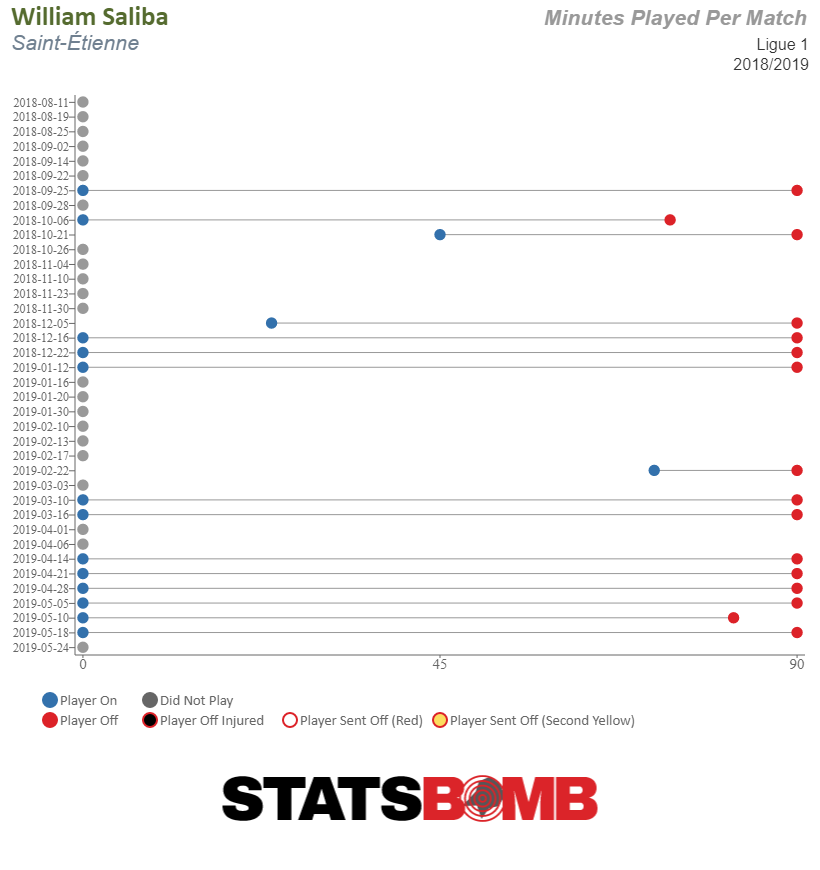 His output when he did play is quite strong. There are, of course, considerable questions about what it means to be a center back who makes a lot of tackles and how that relates to broader team defense, and positional awareness, but Saliba definitely won the ball a lot, 2.5 possession adjusted tackles per 90 minutes, and has an all-around profile with very few statistical weaknesses.
His output when he did play is quite strong. There are, of course, considerable questions about what it means to be a center back who makes a lot of tackles and how that relates to broader team defense, and positional awareness, but Saliba definitely won the ball a lot, 2.5 possession adjusted tackles per 90 minutes, and has an all-around profile with very few statistical weaknesses. 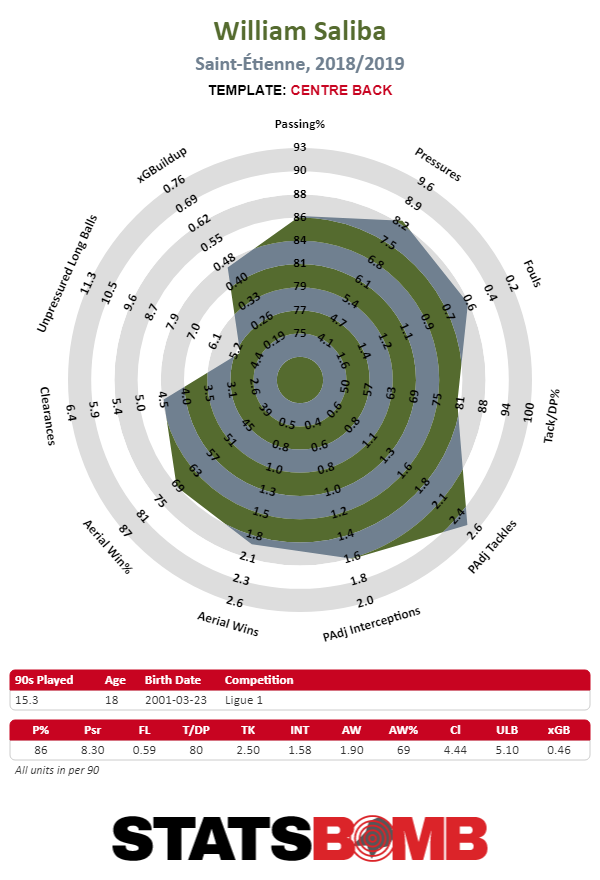 The challenge for Saliba will come when he eventually has to adjust to the different tactical questions that playing for Arsenal will pose, although it’s fair to wonder exactly how different his job will really be. Despite playing in vastly different contexts, top six in England and France but an above average defense in France, as opposed to a bottom half one in England, Arsenal and Saint-Étienne actually have fairly similar outputs.
The challenge for Saliba will come when he eventually has to adjust to the different tactical questions that playing for Arsenal will pose, although it’s fair to wonder exactly how different his job will really be. Despite playing in vastly different contexts, top six in England and France but an above average defense in France, as opposed to a bottom half one in England, Arsenal and Saint-Étienne actually have fairly similar outputs. 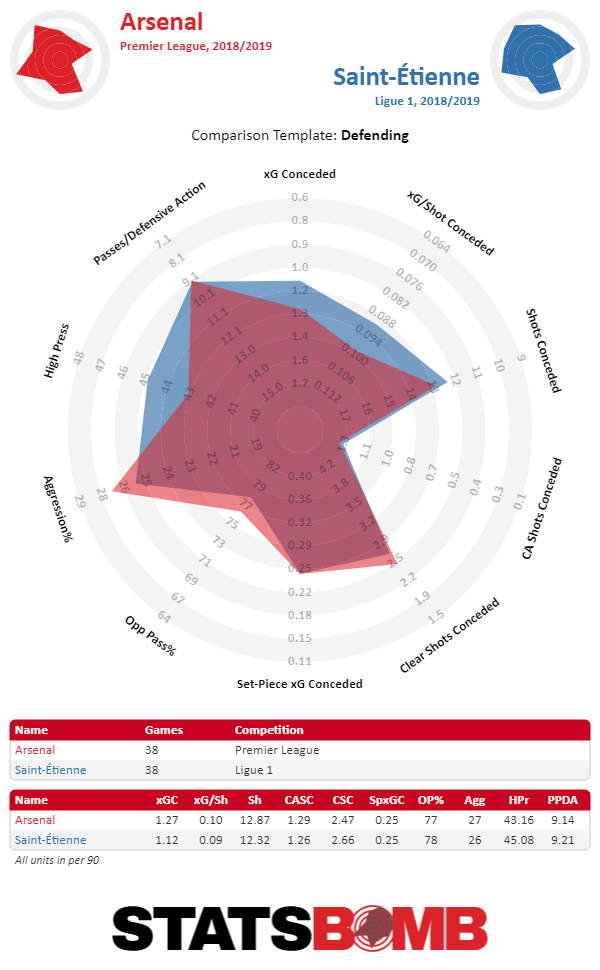 That said, the two teams have chosen to defend very different areas of the pitch. When Arsenal defend high up the pitch, they make their stand primarily in central areas.
That said, the two teams have chosen to defend very different areas of the pitch. When Arsenal defend high up the pitch, they make their stand primarily in central areas. 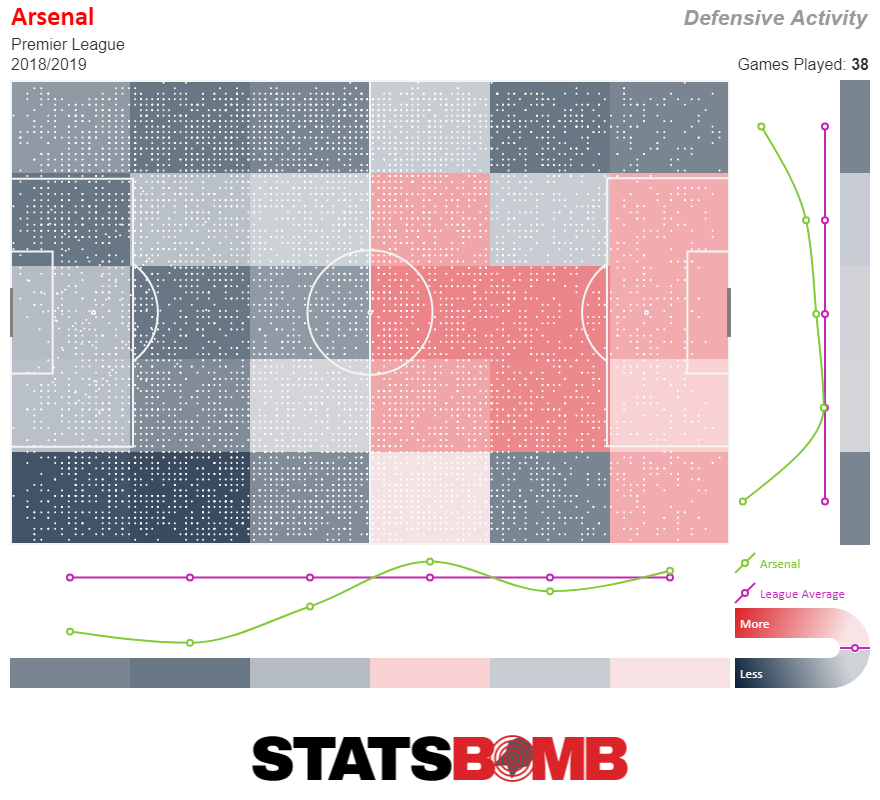 Saint-Étienne press very high and wide, but largely cede the center until the ball is close to their own penalty box.
Saint-Étienne press very high and wide, but largely cede the center until the ball is close to their own penalty box. 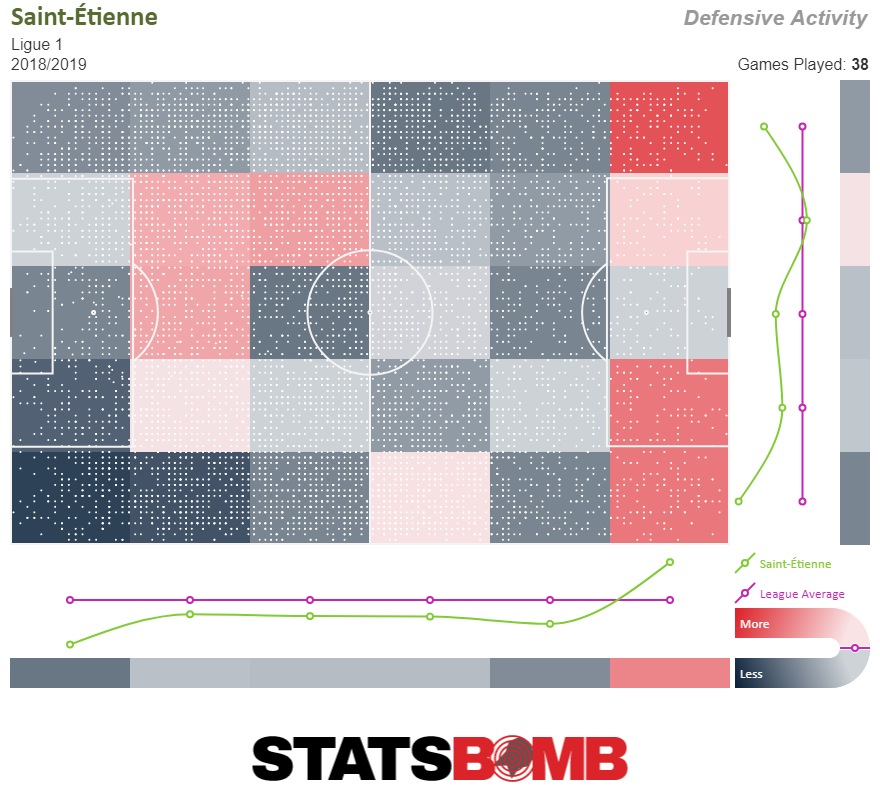 Arsenal are clear getting a very talented, very active center back. He can physical do it all, but that doesn’t mean that when he arrives a year from now, he’ll be ready and able to do it all for Arsenal.
Arsenal are clear getting a very talented, very active center back. He can physical do it all, but that doesn’t mean that when he arrives a year from now, he’ll be ready and able to do it all for Arsenal.
